-
Posts
1,999 -
Joined
-
Last visited
Content Type
Profiles
Forums
Store
Help Articles
Posts posted by Peter Green
-
-
I can't read the text, but the wine labels I can make sense of. Boy, does that look good.
Rona, why not just phone in and ask ahead about wine pairings? The pictures in the link have me drooling.
(Thanks, Hiroyuki!)
-
The lady/man standing in front of Pikachu looks like s/he's flashing it!

It's possible! I think I heard a squeal of "pika pee!"
-
I have to ask--I know how much the different dinners are, but how much is the wine pairing (if you remember, even though you didn't have it)? I don't drink much wine on its own, but I love wine with food, and I imagine the wine pairings are spectacular. I'm a cheap drunk, though. What to do...what to do...
One last thing...do you think it would be inappropriate to print out the coupon for a free glass of champagne with dinner? There's one here. I don't really care for champagne, but it might be good!
If they've got a coupon for it, then I see no reason not to do so! Especially seeing as how champagne goes with everything.
I can't recall what they're charge was for wine pairings (or sake pairings in my case) Really, I'd just glanced at the menu and settled on the shorter course just as a matter of timing. Having read what I've read about Yamamoto now, I would go for the wine pairing, but maybe you could ask them nicely to give you smaller tastings? Otherwise it's going to be a very red faced and giggling Rona heading out for Tokyo Bay later that evening.
I'd definitely go for the gastronomic course if I was going back, but that is going to be a lot of food for you (I remember Ginza Kuraudo in Osaka).
Maybe you could DHL me the leftovers?

-
Ryugin was a meal that both Scud and I enjoyed. Like Paul Pairet in Shanghai, Seiji Yamamoto is somebody who's looking at the new tools and methods of the molecular gastronomy crowd, but dealing with them in that manner, as tools and methods, as a means to achieving the desired result, rather than just the result in and of themselves.
I get kind of incoherent on this topic, I know.
I like having fallen into the meal as a naked naif, as I came to it with no preconceptions. But as I read more about the chef, I'm annoyed now that I didn't take the time to go with the longer 12 course Spring Gastronomy menu:
-Château RyuGin 1970
-White Asparagus Tofu Salad
-"Sakura" Sea Bream
-"Kuzu-Tataki" Rock Trout Rice Bowl
-Assorted Sashimi
-Steamed Abalone & Matsuba Crab
-Crispy Chargrilled "Akamutsu" Perch from Choshi
-Chargrilled "Superior Beef" - Slow Cooked in a "Gastrovac" Oven
-"Bamboo Shoot Rice"
-Pineapple Coated with Coconut Sherbet
-Strawberry Rice Cake with Hot Adzuki Beans
-Minus196℃. Candy Apple
What I've read of the Candy Apple has me kicking myself.
But, countering that, Scud was very good about staying awake, and it is almost as much his vacation as mine ("almost", I am the one paying for this, after all).
Yamamoto san is very active on the international circuit, producing some striking pieces (check out the review of Star Chefs for his Silkscreen of Squid Ink with Squid Carpaccio, the approach taken for detailing the hot tile in for the tilefish I had.
I can see why Food & Wine has him down as one of the top rising chefs (if not arisen)
The Japan Times article talks of Yamamoto having come from the traditional kitchen of Aoyagi, while Michelin puts the credit to an early start with his mother. That background obviously has given him the strong fundamentals to launch into what he's doing now.
He’s also trained as a sommelier, which explains his keen interest in working wines to pair his creations.
I’ll let you read the details in the Japan Time's write-up, but looking that over makes me feel that I must return, with a somewhat better prepared agenda.
And, like I said, even through an interpreter he comes across as just so...likeable. I'd love to have more time with him to go over what he's thinking when he does some of these things.
Alternatively, if he could be talked into coming to Bangkok for the next WGF?.......
-
March 27 – The Singing Dragon
At 9:30 I felt we were getting close enough to brace the elements and begin our journey to Ryugin. I had a map, and it appeared to be just across Roppongi Crossing, through the pimps, and then up a side alley.
Roppongi is an odd mix. You move from the sleeze of the Crossing Crowd to the glamour of the malls to the quiet wealth of the back streets in just a few steps.
As we approached, perhaps a 100 meters out, my phone rang. It was the restaurant calling to let us know that they could take us now. I think I may have surprised them when I let them know I would be there in 170 seconds.
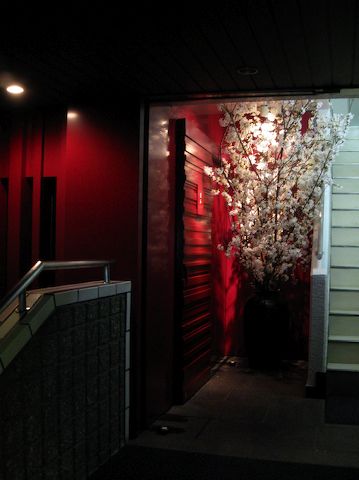
The entrance is easy enough to find, knowing that I’m to look for the red. A small sign, a blaze of cherry blossoms, and targeted lighting make it a simple matter, even for me.
Inside it’s a small, open room. The staff were, of course, expecting us, and showed us to our table with warmth, but no fuss.
There was a choice of three tasting menus, of differing length. Given the hour, and Scud’s menacing looks, we unfortunately chose the shorter 9 course menu – the Spring Short Course. I really shouldn’t say “unfortunately” as there was nothing wrong with it at all, but I would have liked to linger over the longer versions. However, by their advice, this would have had us heading home at 1:00 a.m. from dinner, and that was a little later than Scud was up for.
(Before we proceed, my apologies for my photos. They don’t do justice to the food at all. Still, I’m happy that they allow shooting, they just ask that you don’t use flash, a request I did my best to comply with, but occassionally this cheap thing I have with me resets itself).
As I’d mentioned earlier, I came with few preconceptions of the restaurant and its chef, Seiji Yamamoto, other than knowing that he was someone who was interested in finding out how things can be done well.
The wine list is primarily French, and quite good. But, as the clock relentlessly ticked off my remaining hours in Japan, I was realizing that it was sake that I would miss the most. So, rather than taking wine as they recommended, I asked for them to recommend sake that would work with the dishes.
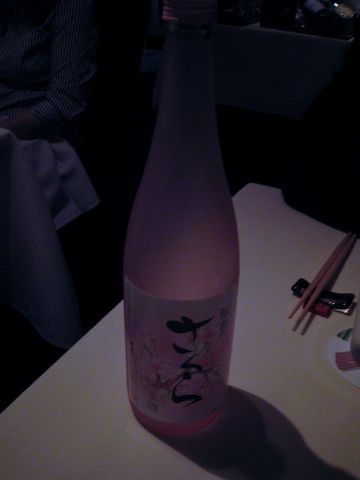
The first sake was a Sakura junmaishu, from Aomori, in the North of Honshu. A little dry in the mouth, and with a pleasant bouquet. It matched with Scud’s comment of the room “Everything here feels light”.
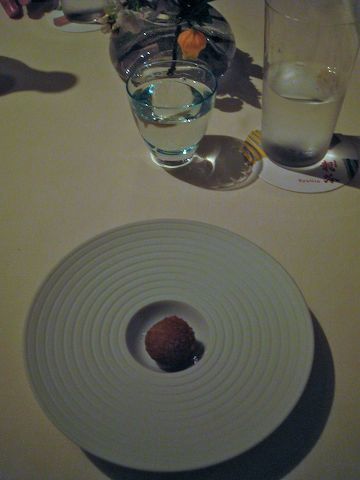
Our opener was an Okura Petit Croquette – a croquette of tofu, a little golden brown ball of tofu with the texture of a proper croquette. A tidy little thing, and, as we’ve said before many a time “frying is good”.
Edited for this: I was just doing more reading and, in a Japan Times article, they referred to this as an okra croquette (okura?), as opposed to a tofu croquette. But my notes say tofu, so I'm uncertain
And truffles never hurt.
It begins with the softness of the tofu against the light crisp of the fried exterior, and then right away, with that softness, the truffle blooms in your nose and then subsides, to linger in the crevasses of your mouth.
Meanwhile my idiot child expresses his delight at this by doing ninjutsu finger movements. I think he watched too much Naruto this day.
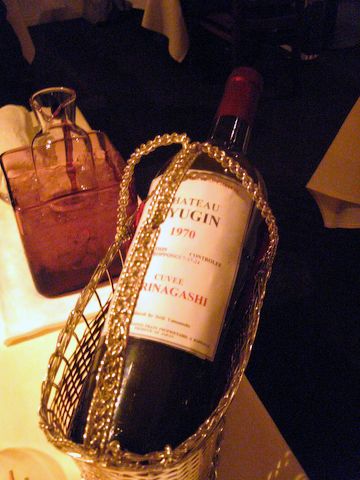
Chateau RyuGin 1970
With Spring Cabbage Puree and Broiled Mullet Roe
Next was a cute little piece. A warm soup of cabbage in broth (surinagashi) corked and presented with the date of our chef’s birth.

The soup was corked, and then poured into a glass alongside a pretty little piece of mullet row, cherry blossoms lightly adorning the black tile it’s served upon.
The mullet roe was, as you’d expect, pleasantly salty, thick and a little pasty, offset by the diakon, and filled out on the sweeter side by the broth.

This was followed by
”Sakura” Sea Bream
Early Cherr Blossom Presentation
Served with Fuki and Celery in Soy Sauce
What arrived was a cherry blossom plate, with one sakura leaf under which the sea bream sheltered.
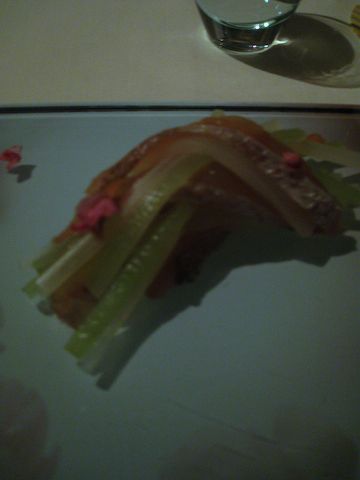
I wish this picture was better, but I include it to give the idea, if not the image. The fish is very nice, but it’s the fuki and celery with it that get my attention, that pleasant crunch to go with the fleshiness of the seabream. The fuki is a form of butterbur (also known as a bog rhubarb), that needs to be prepped with a hot water bath to remove the harshness, and then plunged in cold water to set the colour. This is the same sort of process that Yoonhi follows for bracken fern prep and some other wild roots, as the hot water will remove the toxins (hopefully).
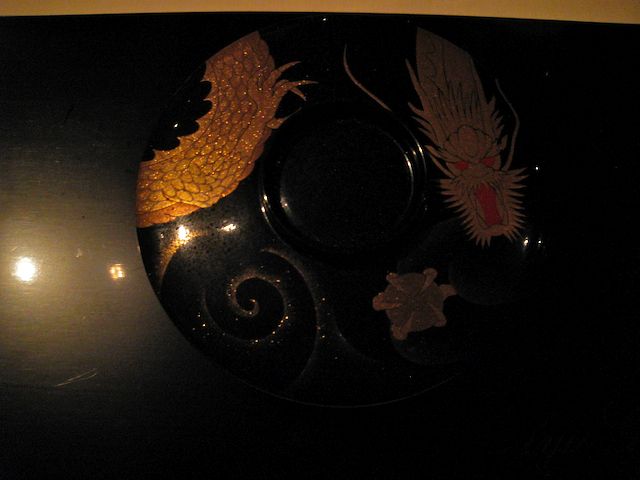
The restaurant’s name comes from a poem, that refers to “the singing dragon in the clouds” a motif that runs through the décor, and again takes me back to the title line of this thread, chosen back in early March. I can’t look at the lid of this bowl and not think of Haku in his dragon form in Spirited Away.
“But, what’s under the lid”, you ask?
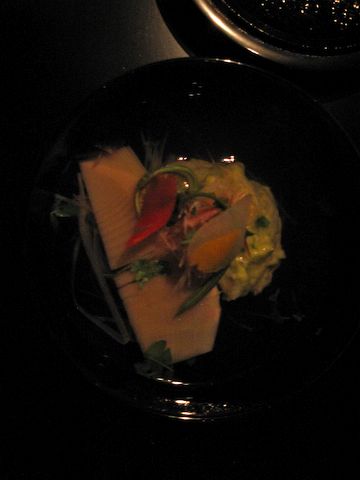
Scallop & Peas Dumplings “Shinjo-wan”
Served with a Hearty Serving of Spring Vegetables
This translated as rich scallops from Hokkaido; sweet green pea dumpling; the almost de rigeur bamboo shoot; fiddle head ferns (kogomi) from the hills; fresh herbs; and a broth of kombu and clams, very clean and fresh.
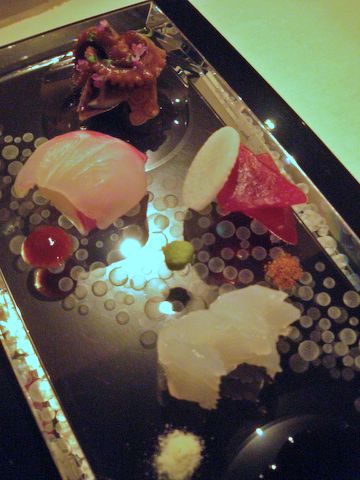
There followed the Assorted Sashimi “Ryugin Style” – pretty cuts of fish, each with a condiment set aside to complement the particular flavour. The octopus…well, I’m a sucker for an octopus, as you know. This was extremely soft and carried the smell of shiso and ginger and cherry blossom with it. The tuna shileds itself behind a wafer of daikon, the seabream (tai) rests folded like an obedient pet, with a droplet of yuzu sauce its leaving behind it. And what I take for squid doesn’t taste at all like ika, but mcuh more like a fish in texture.
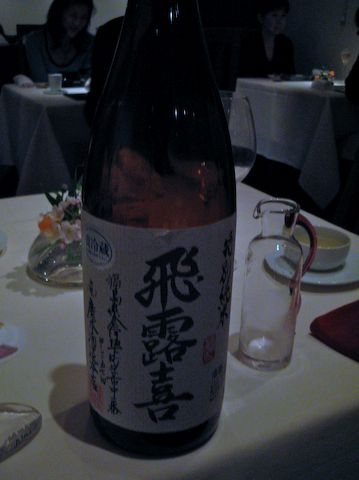
The sake they brought next was the Hiroki from Fukushima (that Hiroyuki had googled for me). This is the same one that I’d had a few days earlier at Morimoto.
It was still good.

Crispy Fried Naruto White Tilefish and Fish Print Presentation
Served with Frothy Brown Vinegar Sauce
Along with Warm Vegetables and Pine Nuts
Was I mentioning Naruto earlier? A tilefish served on a tile. A very hot tile. The signatures and fish design are done with red miso and squid ink. The small mound of green vegetables has been nicely truffled, which goes surprisingly well with the miso used in the marinade, and the broad green starchiness of the beans works well with all of this.
The fish itself is very Mediterranean, from the vinegar foam to the extremely crisp skin, reminding me very much of some of Passedat’s preparations from Le Petit Nice.
Thumbs up from Scud.
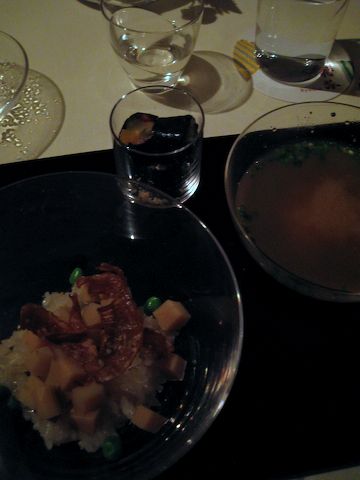
Chef’s Rice Dish of the Day
Now there’s an understated title.
The rice is marvelous.
Seiji Yamamoto’s father-in-law grows this for them in small batches. A northern rice (koshikani?), but this is grown in the South, on their farm in Shikoku.
The rice I adorned with boiled, firm bamboo, onion, and fresh green peas.
The miso was extremely silky, threads of bean paste sliding through your mouth and down your throat.
And for pickles, norimaki, that thick vinegared seaweed holding the pickled vegetables bound tensely to counter the relative abandon of the rice and vegetables.
The chef came by the tables to visit, accompanied by our sommelier who took care of the translations. This is where I asked of the rice and its origin (and probably got the spelling wrong, but that’s my fault). He’s the sort of person you just like as soon as you meet him. A broad, good humoured smile on his face, he’s obviously someone who’s having a lot of fun with what he’s doing, and couldn’t be happier than in doing it for people who enjoy it.
He noticed that both Scud and I had scoured our rice bowls clean, and cheerfully went back to the kitchen to prepare us another serving.
Who are we to argue?
Rice finishes the main part of the meal, and a very nice green tea arrives, but I’m still lingering over the remains of the sake. The tea does look good – the bowl of pale green resting in a donut of a saucer - but I want to keep this flavour of sake, rice, miso and vegetables in my mouth as long as I can.
I’m greedy.
My sommelier then brought me a treat.
A 25 year old sake that had been oaked in casks from Chateau d’Yquem. Shigeri, I believe, was the name, and I think it’s a word that relates to luxuriance.
It’s a very interesting taste, like a brewed sherry, very soft, with a lot of oak in it. When you drink, it flows to the sides of your mouth, then vanishes, with just a shadow of sweetness remaining.
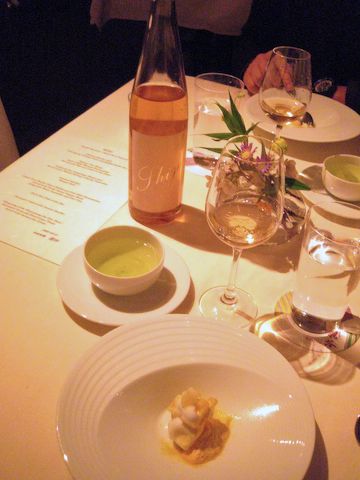
With the sake comes dessert. Pineapple Coated with Cocount Sherbert
The sherbert is full of the taste of coconut (as you would expect) and there’s a dusting of mango powder to give an additional sideways flavour to the tangy sweetness of the pineapple.
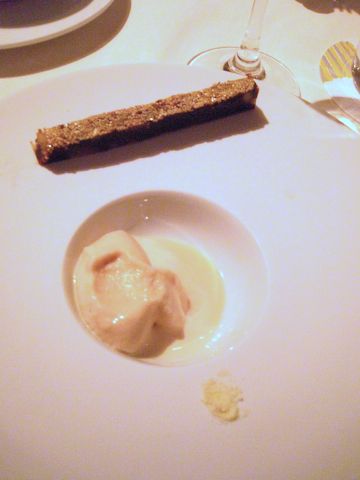
More dessert arrives.
”Whispering of the Wind among the Pine Trees”
Kuromitsu Syrup and Dried Grape Treats
Served with Caramel Ice Cream
There’s a small pile of ginger salt on the side to go with the ice cream. The ice cream itself has that just-pulled-from-the-churn feel about it (which so makes me want to go and get a batch of ice cream underway right now, but I’ll restrain myself until I finish this), and the “cake” is a dense packaging of the fruit, with miso and soy setting off the raisins, chestnuts, pinenuts that are all packed together, with an anti-doping-challenged topping of poppy seeds.
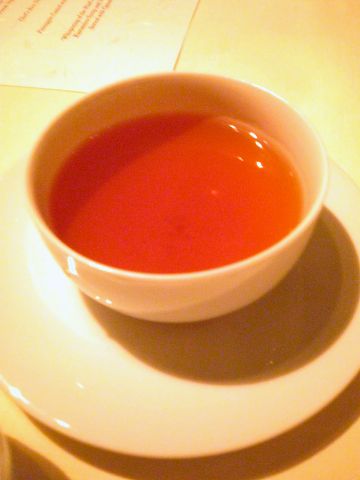
More tea arrives, this time an English camomille.
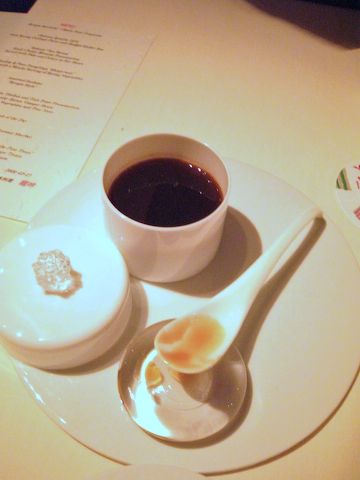
As a sweetener for this comes a tidy little pot of Indian honey, from the border with Nepal (these Himalayan honeys are being touted now as the new wonder medicin, good for whatever may try to hamper your good health).
It was well past midnight by now, but business was still going well. Ryugin aims for two seatings, one at the traditional hour, and another for the post-theatre, post-concert, post-whatever crowd that will arrive looking for an excellent two star meal.
Lucky for us.
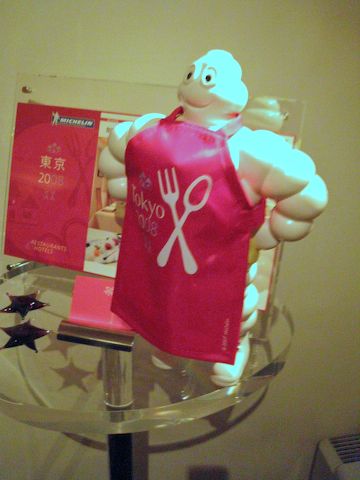
-
March 27 – “Fried is good”
We needed to get out of the house.
“C’mon, Scud! Let’s go to Shinjuku and stare at the bright lights!”
“You fool! That’s how they kill mosquitos!”
That ominous line withstanding, I dragged the boy and his proboscis away from the all-day Naruto fest on tv with the promise of an English language bookstore.
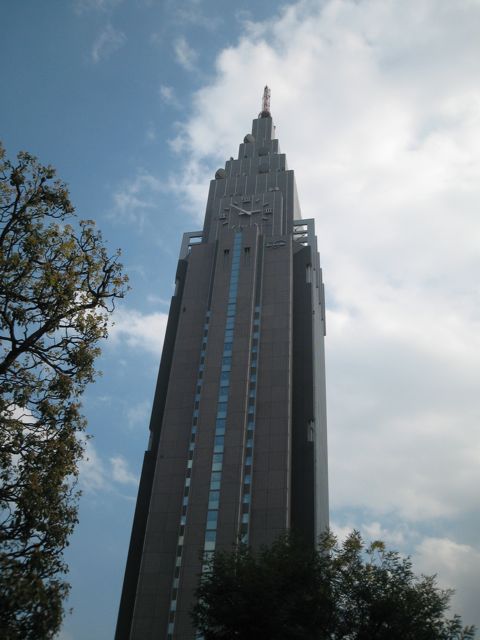
Shinjuku is neat. I say that as a geek. It’s everything modern Japan is supposed to be. Clean lines, superskyscrapers, people moving resolutely from A to B (and even, sometimes, to C) and a total feel of being in the midst of a nest of ants.
I see the Shinjuku skyline, and I think of Akira and Patlabor and Tokyo Babylon and all the other myriad neoTokyo silhouettes that populate the world of anime.
I alsot think of the other Murakami – Ryu. Particularly In The Miso Soup, in which the plot focuses on an aging Western psychopath who butchers his way through the bars of Shinjuku.

We got a little lost in the station, but even that was fun for the sake of seeing what we could find.
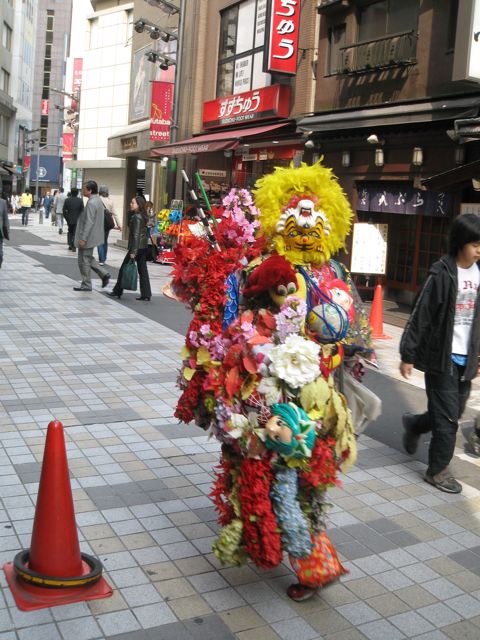
But, beyond the idle idling, we were on a mission. We had to find the big Kinokuniya.
First, being a bookstore, it’s a magnet for the boy and I.
Second, being Kinokuniya, it’s something we’re familiar with through the foreign branches, so it just seems wrong not to visit.
Third, I’d told Scud they’d have English language manga. (Well, I had to get him out of the house somehow, didn’t I?)
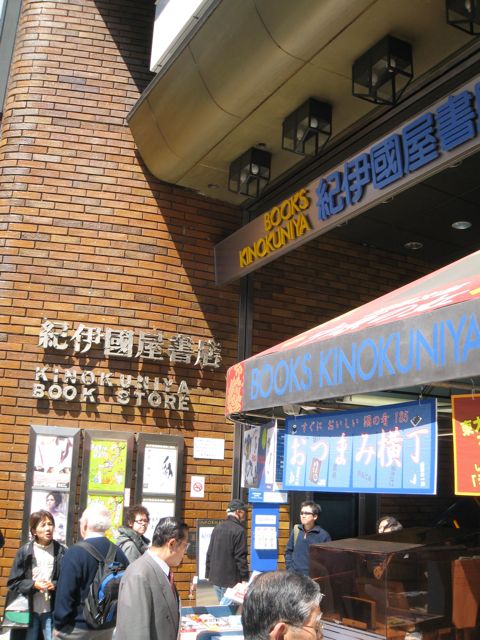
It’s a good store, but, because it’s built vertically, it felt smaller than the ones I know in Bangkok and Singapore. A false illusion, as this was occupying multiple floors in two buildings, but falsehood is the nature of an illusion, and perception is everything.
I just had to say that. Sorry.
Scud did manage to find a copy of Masamune Shirow’s Ghost In The Shell, which satisfied him to some extent. Then he started making noises about buying Shonen Jump.
But, of greater importance, I was finallly able to stock up.
First, I found the Red Book.
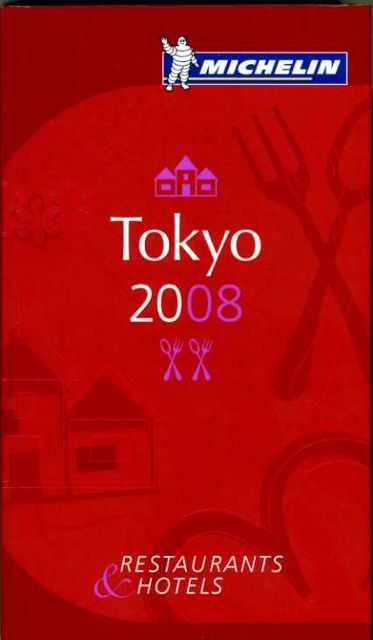
I also found a very entertaining little book called “Who Invented Nattou?”. This is a parallel text, in both Japanese and English. The premise of it is that the modern Japanese are continually being caught out by the odd questions of foreigners (like “who invented nattou?”), and this book is meant to arm them for the irrelevant queries that we can come up with.
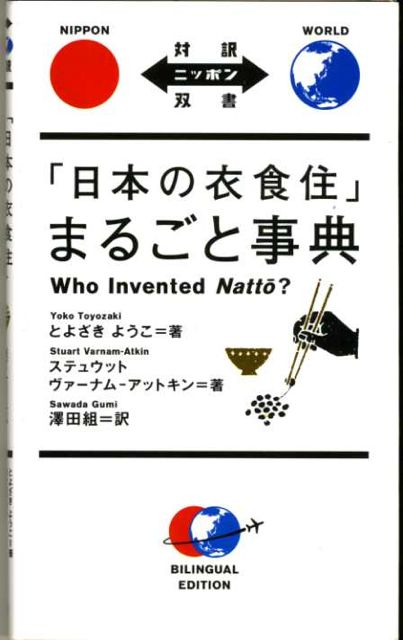
Like the Michelin Guide, this is something I wish I’d had at the start of the trip, as it discusses food etiquette, kitchens, houses, and a host of other day to day trivia that is hard to find elsewhere. Heck, I wish I’d been reading it earlier.
I lusted after some of the cookbooks, too. There was one titled Izakaya in particular, but I had to consider the issue of suitcase weight. Books pile on the kilos faster than almost anything else (well, besides my diet), and I reined in my desires.
Beyond the English section, we rooted through the manga in the second building. Scud had a short list of things one of his Japanese-literate friends at school wanted, and this was a place where we’d have a good chance of finding it.
Book shopping done, we started looking for lunch. I now had a decent guide book with maps to work from – the Time Out for Tokyo – and it praised a particular tempura shop in the neighborhood.
Tsunahachi.

As happens, Rona did this place shortly after us, but she’s a lot better organized and effective than I, and already has the post up here.
What are the odds that she’d be in the same restaurant as I only a few days apart? And greater odds that I’d be in Lin Heung in Hong Kong a few days after her, but before she posted about there?....Anybody see Rod Serling around?
I can hear Rick Blaine now…….
“Of all the tempura joints, in all the towns, in all the world, she walks into mine.”
I love that film. Even the remake, Barbed Wire, is excellent (if you haven’t watched the two back to back you should. Pamela Lee Anderson and Humphry Bogart are like two peas in a pod, say I).
Where were we again?......
Ah, yes, Tsunahachi.
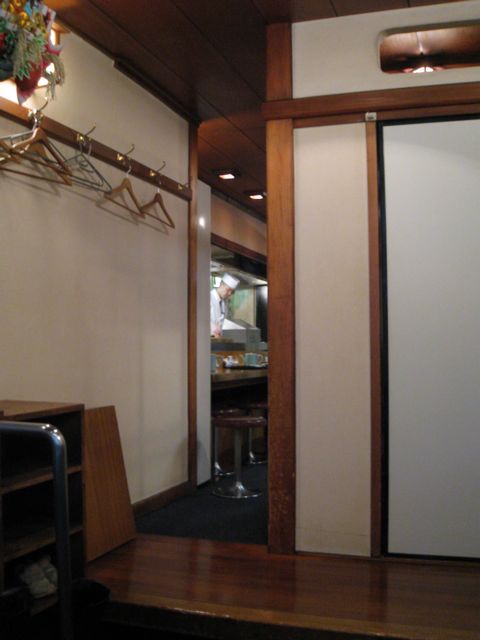
For me, it’s a crowded warren of narrow corridors. From the entry point, there was one bar directly ahead of us, and then there was a no smoking section tucked around to the right. I carefully maneuvered my bulk through so as to not trash the place, and Scud and I were seated at the bar.

Her menu was more elaborate in what was provided. Scud and I had just pointed at the middle of the set menus, which I think may have been the lunch specials, and made do with that.
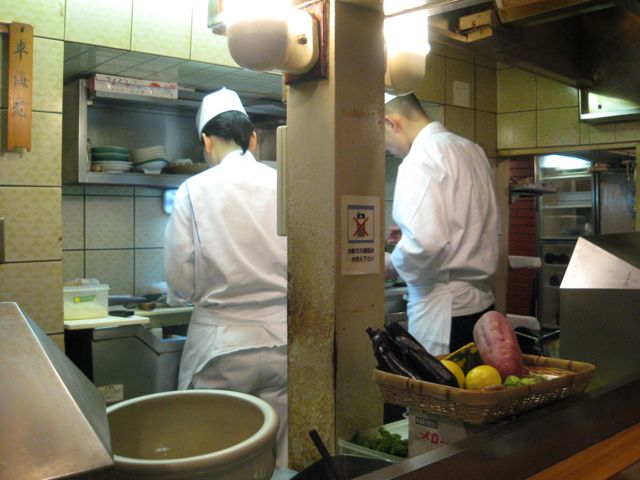
We had two chefs at the bar, the young lady taking care of us and the others at the counter, and the male chef dealing with the crowded tatami room behind us.
First up were the prawns. A pair of ebi, all piping hot and crispy. There’s something wonderful about the taste of fresh fried batter, served up before you straight from the oil.
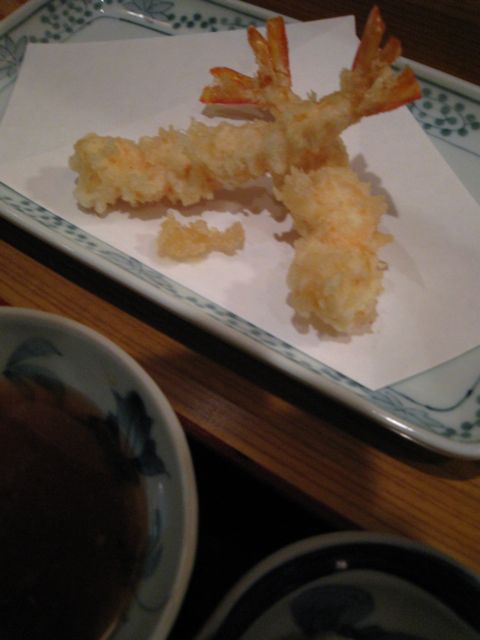
The miso was very nice, with that Hitler’s Brain sort of cloudy texture to the miso. This one had a very pleasant taste of clams about it, and a poke with the chopsticks confirmed there were shellfish down in those murky depths.
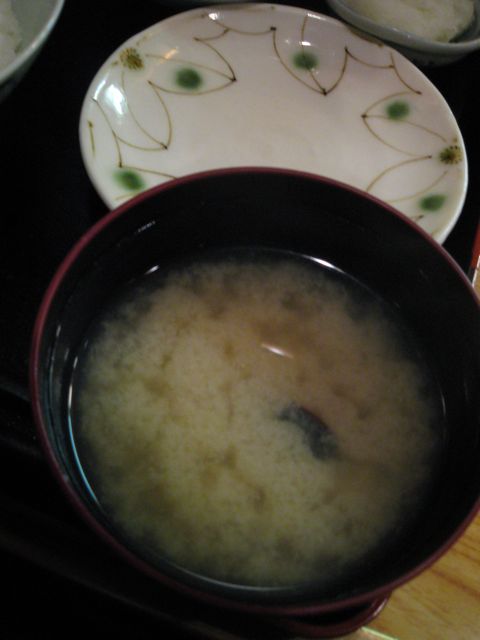
Next was a very buttery piece of squid, for which I have only the shoddiest of pictures. Look to Rona’s shot, it’s much better, and fried squid all look alike anyways.
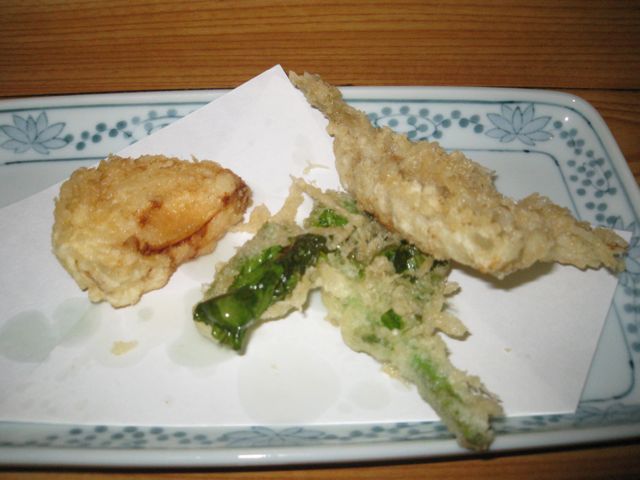
Then there was a trio of vegetables. The one on the left tasted of starch, and may have been a sweet potato. The green was, well, green, and the other was very nice, but I can’t put a flavour to it.
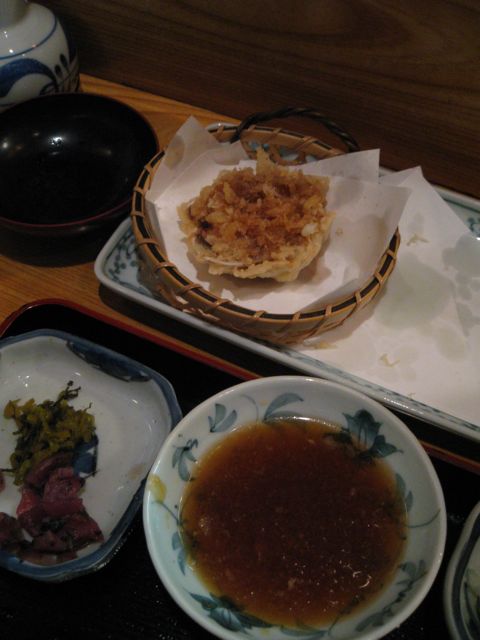
And then there was the shell, stuffed with good bits of stuff, and then battered and deep fried. Both Scud and I really enjoyed this, with the taste of shellfish about it.
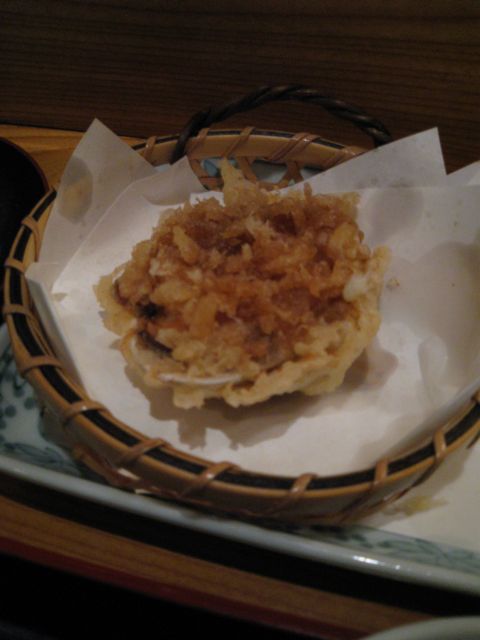
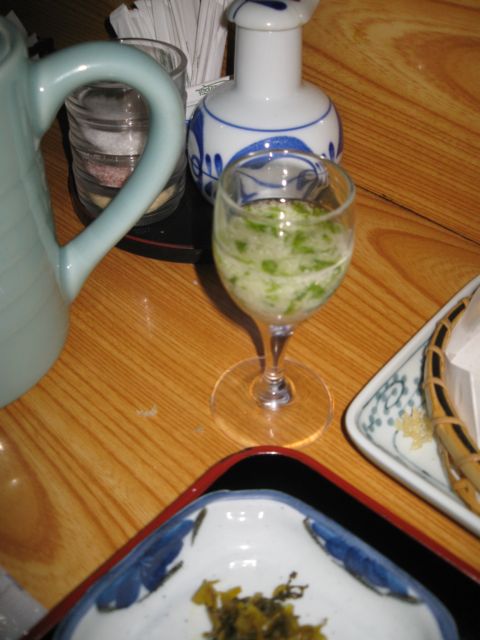
I have no idea what this was. It was green. Rona had suggested aojisai, but that doesn’t help much. It was refreshing enough, but with an odd texture about it.
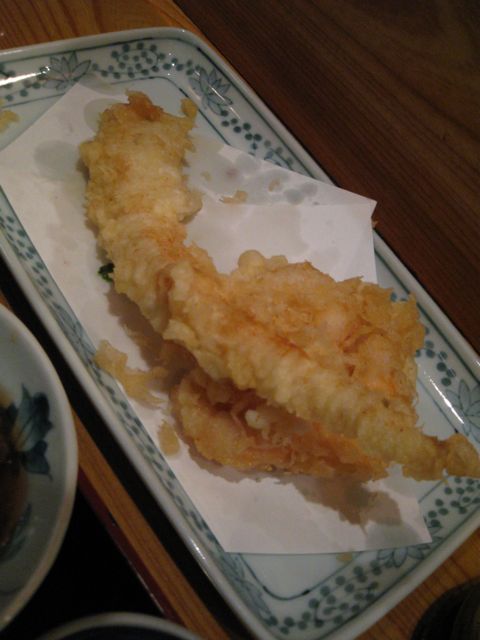
And, like Rona, we finished on eel. Scud was very happy with this, as he misses eel nowadays, and I’d put it off earlier in the trip as I had always thought of eel as a Tokyo thing.
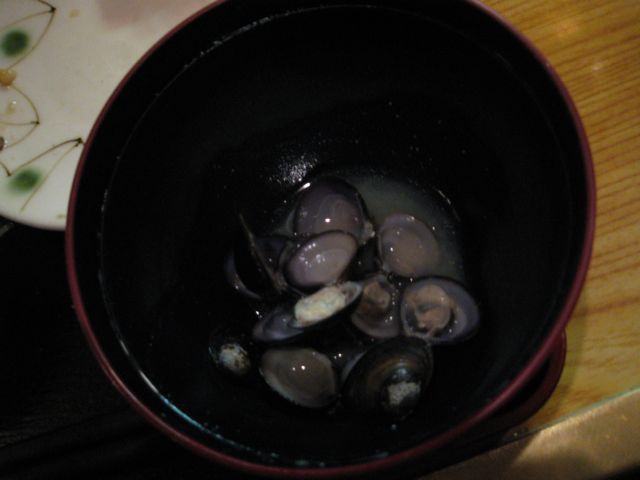
We sniped at the clams in our bowl, but there was a crowd beginning to form, so we cleared the way and tried to get to the counter to pay.
At this point I finally missed a beat, and I clipped the edge of one of the chairs in the waiting area, sending things flying. I immediately glared at Scud in the hopes that everyone would blame him.

We strolled back towards the station, taking in the variety of food and beer venues to be had. And then Scud found a game parlour, and we had to check it out.
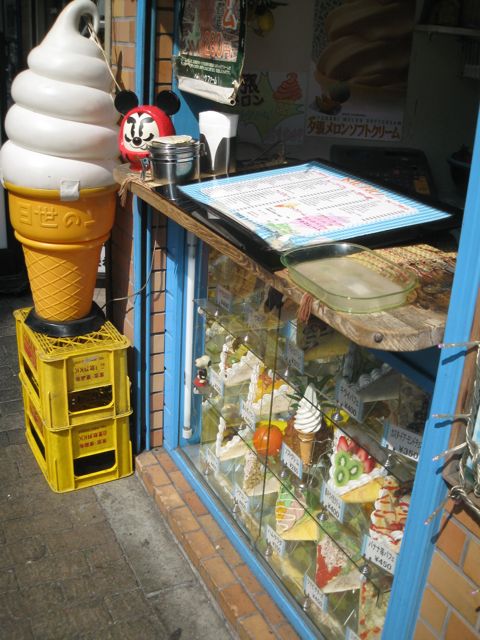
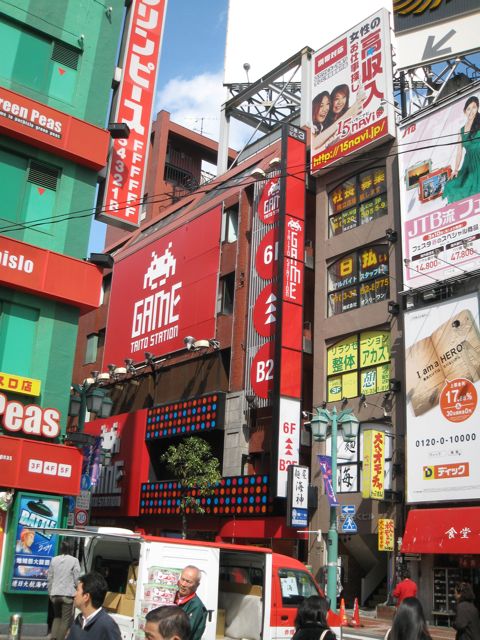
One floor was all dance machines. Dance, Dance Revolution taken to a far more commercial level. And then there were the drum machines, the guitar machines, and others I couldn’t make much sense of.
Another floor up, and everything was pink. Booths for photos. Lots of the crane machines for trying to pick up Hello Kitty dolls, and more stuff that was just, well,….pink.
Finally we found the manly stuff on the fourth floor, and Scud and I blazed away for a few dollars worth against zombies in the sewer system.
That kept us pretty well occupied until the coins ran out, and then it seemed like a good idea to go looking for food.
That’s not hard to do.
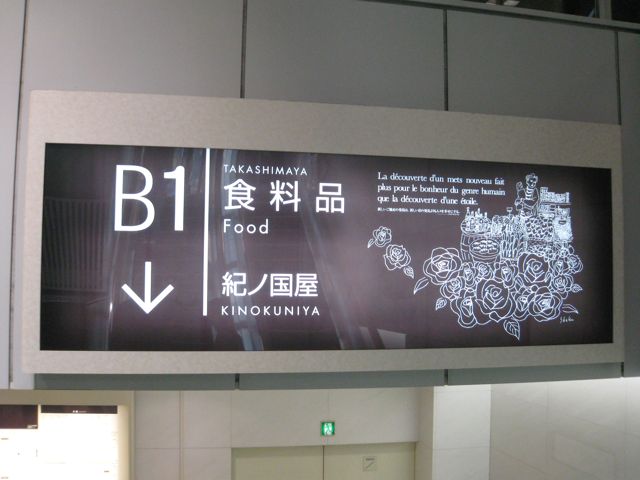
Having satisfied his needs for fairly mindless violence, the Boy had not choice but to follow me into the Depachika of Takashimaya. Rona prefers Isetan, which was also close by (just across the main street from Tsunahachi), but Takashimaya is something I’m used to from Singapore, so the decision was made.
I’m getting used to the pastry thing. The whole initial approach to Takashimaya’s food floor is all pastry. Pastry, pasty, and desserts. But this was okay by us, as one of our missions was to get a sampler of desserts, so we spread ourselves around a bit, buying one or two pieces in the different outlets.
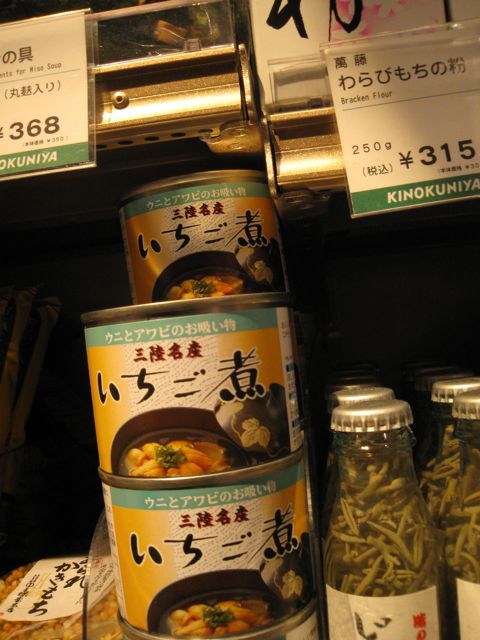
After we’d run the gamut of puff pastries and profiteroles, we made it through to the regular foods.
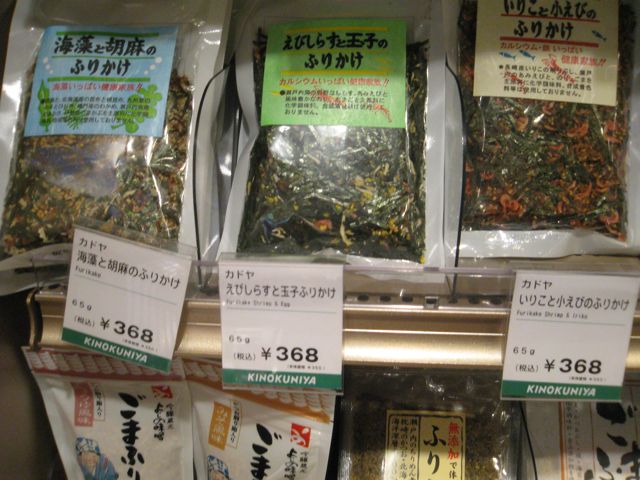
When we did get through to the foods, I spent a lot of time puzzling through the furikake.
Seeing as how furikake has its own thread (this is egullet, after all), I’ll put aside much discussion and direct you to here.
Finally, we emerged from Takashimaya and headed for home with our bags of goodies.
Back in the room, we settled down to a pleasant bit of gluttony.
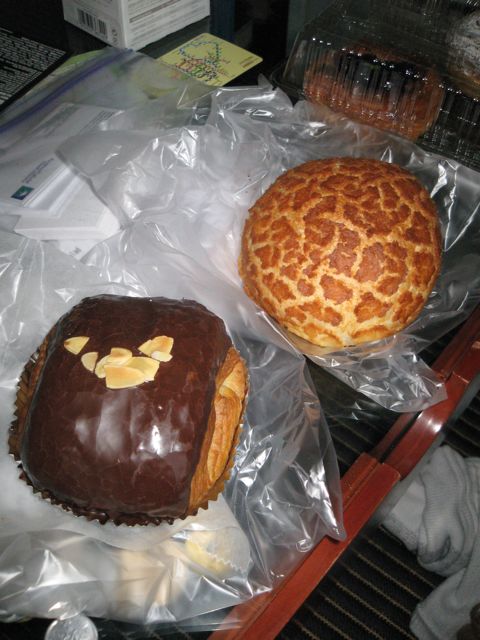
The chocolate one in the foreground had a nice custard filling to go with the roasted almond on top. Behind it was what disappointingly turned out to be a cheese bread type item.

These were both good. I was more partial to he blueberry one on the left, but Scud praised the white powdered sugar with the walnut and plum on top.

Add onto that some more items designed to keep us in the running for the condiment creep awards, and we’d had a relatively successful day of things.
The Boy scuttled away to catch up on cartoons, and I started pouring (poring?) over the Michelin. I did one quick pass, dog-earing several pages, and then did another review.
A lot of the restaurant reviews did look quite similar, which was a little depressing, but there were a few that stood out.
One in particular took my eye, which concerned a young chef who was visiting Spain on a regular basis for the chef’s congress. From this he was bringing back ideas to use in his own exploration of Japanese cuisine.
Sounded good to me. We were going to Ryugin to see Seiji Yamamoto.
Unfortunately, there was the issue of reservations. However, I find that, by abandoning myself to fate, I can often pull things off. A phone call did indicate they were full, but they could possibly fit us in at 10 p.m…..?
Done. They were kind enough, as well, to take my cell and promise to call if anything opened earlier.
This all worked out rather well. We’d just binged out on pastry, it was mid afternoon, I was drinking sake and reading, and we probably wouldn’t be too keen on eating for awhile anyways.
What to do for a few hours?
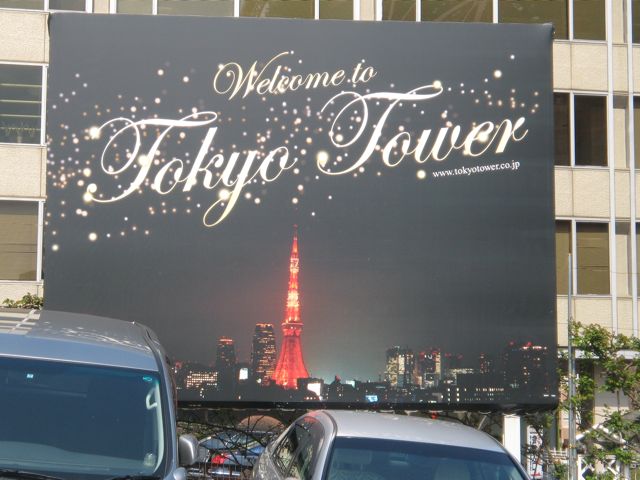
When I’d asked Scud earlier what he wanted to see on this trip, he’d said, with no hesitation, that he wanted to see the Tokyo International Anime Fair, he wanted to go to some manga and anime shops, and he wanted to see Tokyo Tower.
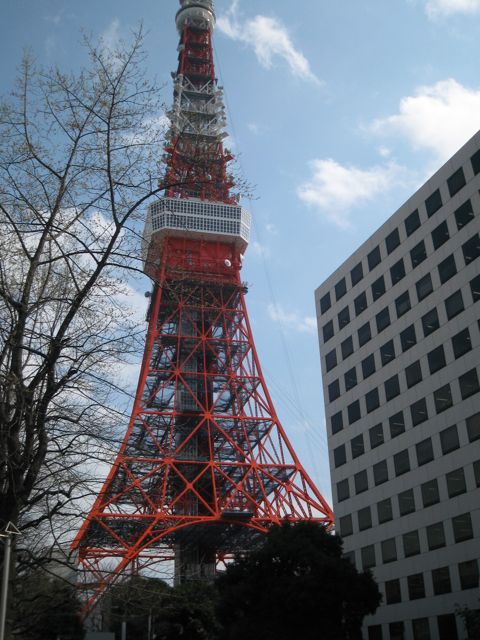
Why do people build these things? Is it all Freudian?
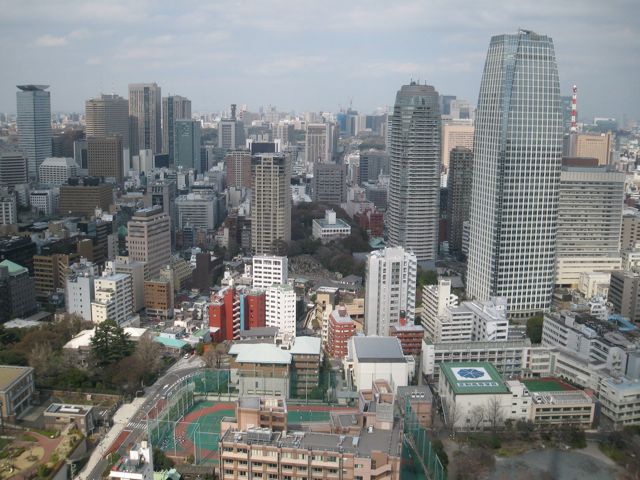
You do get great views, though.
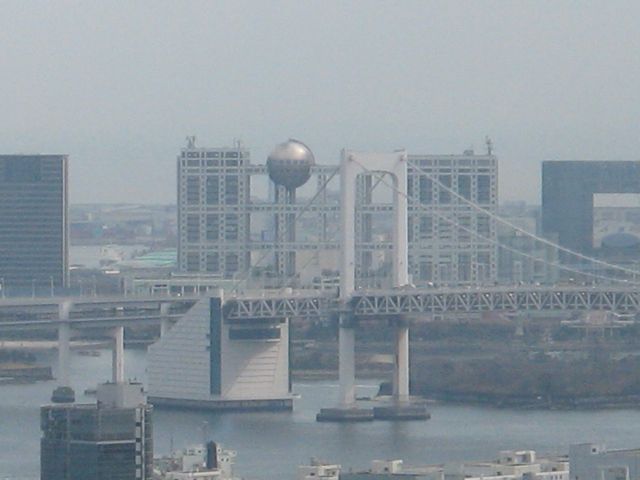
From the other side of the observation platform Scud could make out the Shonen Jump building out by the harbour.
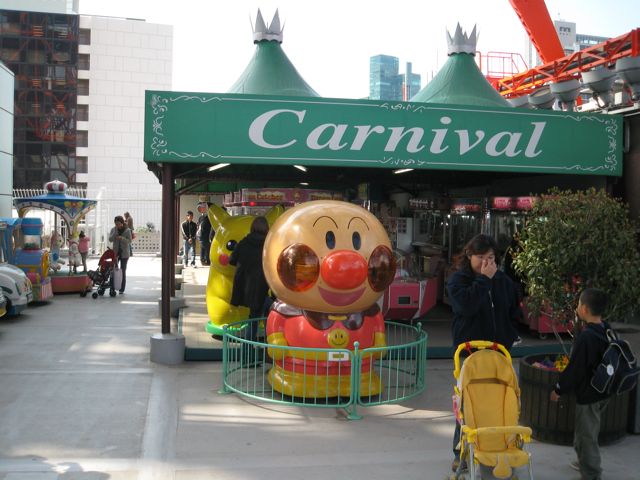
And the second floor had a small amusement park, with a Pikachu the size of me, a merry-go-round, and this little train ride inexplicably overseen by Hitler.

And I even had the chance to buy some authentic souvenirs.
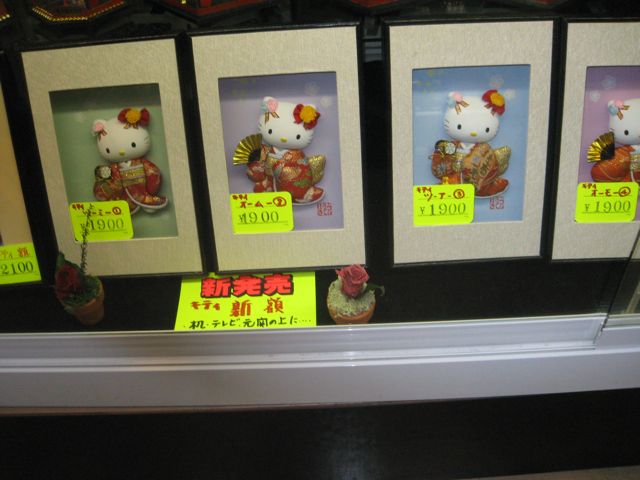
Hello Kitty.

She’s everywhere. And it’s good to see that she and Doraemon are on good terms again after the sumo unpleasantness.
At the base of the tower was a final treat.
A busker.
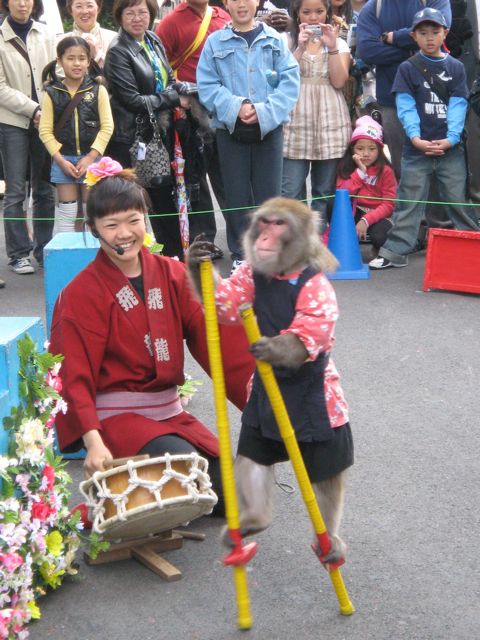
This was like something out of a Shintaro Katsu film….well, except perhaps for the head mike. But the female entertainer working the crowd with her monkey just seemed so….right.
Scud was entranced, and there was no way I was dragging him away from this before it was over. You probably weren’t going to get me away, either.
This seemed like a good spot to wrap up. Needless to say, I failed to do so. Instead we walked down to Shiba Park, and checked out the old neighborhood from when I’d been here back in the 90’s.

Still looks the same. But the cherry blossoms were coming on strong, and it looked like we were in for a good finish.
-
What is it pp for dinner?
Even for dinner, most places in Thailand are quite reasonable (if compared against other capitol cities). It's the wine that'll kill you. I had a comp meal once at Luca's that was one of the most expensive I ever drank, as I'd offered to pick up the bottles (does that make it one of the most expensive meals I ever drank? No, that would be The Square)
On the bright side, many of the good restaurants offer reasonable corkage, so if you're bringing a bottle with you from the airport, it's not so painful.
Alternatively, scout for the wine dinners on offer.
And, of course, eat what you want to eat.
-
Julian,
I take it you liked it, eh?

-
Help! I have a third of a daikon sulking on my kitchen table, because I don't have a home for it. I turned a third of it into cold udon with ponzu, and another third into mul kimchi, but now I need to sort out the rest of it. I don't have much miso left right now, or I'd put it in that. I was thinking something with thin slices...anyone have any suggestions? Helen?
Yoonhi's first reaction is to make a bigger thing of mul kimchi. ("Only 1/3?")
Then she said "well, you can braise it in soy sauce". But that's not really in the spirit of pickling.
-
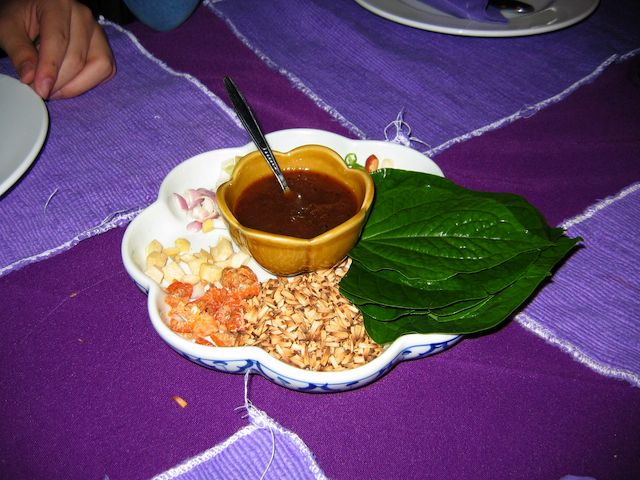
Another speciality of the North I love is miang kam (this is always brought out as a starter at Baan Khanitha in Bangkok), and the beauty is in the simplicity. Pandan leaves are wrapped into a cone, and then a selection of ginnger, peanuts, chilis, dried shrimp, onion, lime, and roasted coconunt is added to be topped with a dollop of sweet sauce (I like the plum). But this can be varied to any adjustment of items (or rather tastes) you care to try.
Those definitely aren't pandan leaves.
I was told they were betel nut leaves, but not sure whether that's true either. Sure is an acquired taste though.
Yes I believe they are fresh betel nut leaves. Or at least what you use to chew betel nuts.
Edited to add:
This is also one of my favorite things to munch on. Great appetizer. Good with beer I'm told ( I was too young to imbibe back then). I can't find the leaves here fresh and it doesnt work otherwise.
You're right. I don't know why I thought pandan. Bai chaploo, or some transliteration like that, which I think is betel nut leaves. Waxy texture, but a neat taste.
-

This has been hanging around for awhile ( a couple of years actually) and there are so many folks with trips to Chiang Mai coming up that I figure I’d better toss this up.
First, as you can tell from the the pictures of the vermin, this is from a couple of years ago. For that reason, I’ll concentrate more on Thai food than European (‘cause you’re never too sure who’s still in business).
So, let’s look at what there is to eat in Chiang Mai.
There are a few things about CM to know before going.
One, because it’s so small, it’s very big. The city is, in many ways, tiny, but it’s sprawled over the years. Combine this with the lack of mass rapid transit, and you have a situation where it can take ages to get to the other side of what appears to be a fairly small town. Plan your days to get to one part of town, and then cover that area. It can take longer to get places here than it does for a similar distance in Bangkok, as there’s no Skytrain.
Two, having said the above, don’t rush. Part of the joy of CM is the pace at which it moves.
There, let’s look at food.
Chiang Mai, representing the older Lanna Kingdom, has more ties with the region from here to Luang Prabang to Sip Sawng Panna than it does with Sukhothai and the Krungthep to the South.
In fact, it’s difficult to find Northern food in the capital. Some of the food from Isaan will have crossovers (coming from the aforementioned Lao tie in) but the food of Isaan is much different from what you’ll find here. So, make the most of the trip and see what there is to be had.
First, remember that pig meat is good. As Steingarten said, all great civilizations are based on pork.
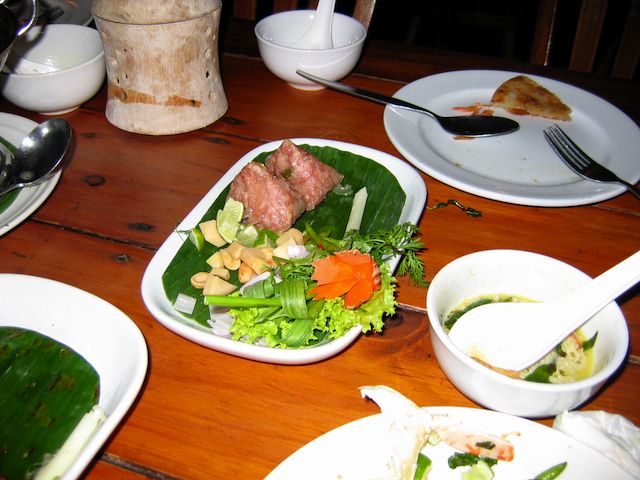
The North specializes in fermented pork (you can buy this as pink sausages in tubes – nehm), which will come glistening from the steamer or the fryer, dripping in fat.
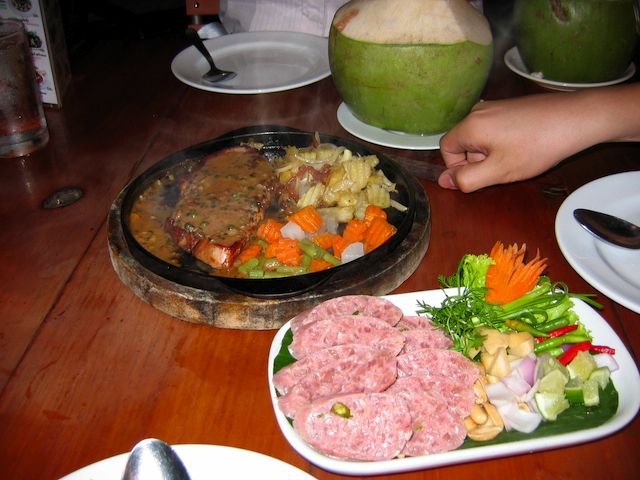
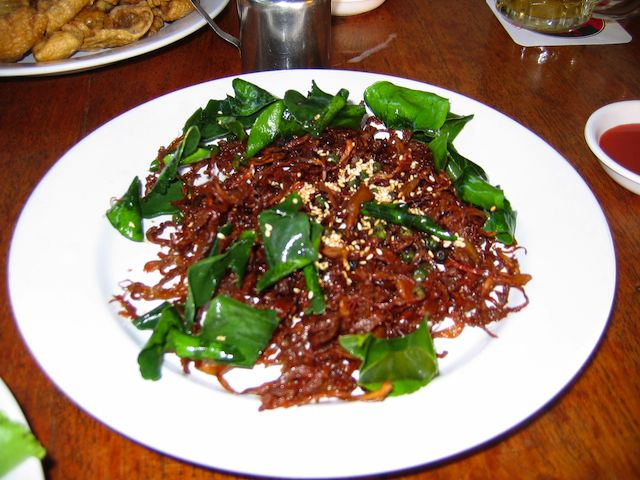
You can also get it shredded and dry fried (with fresh basil in this case).
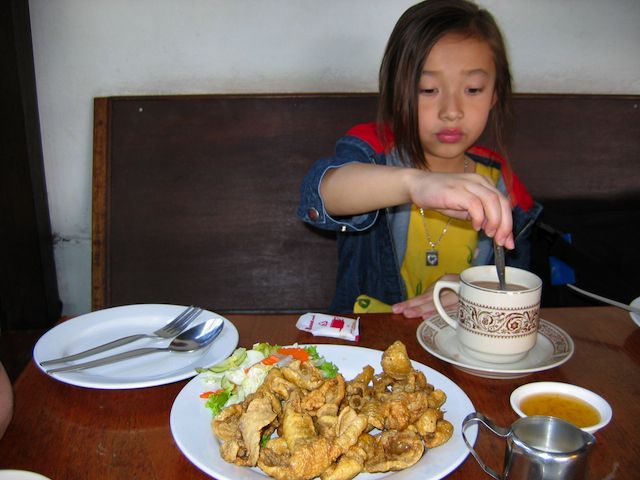
And let’s not forget pork rinds, crispy and tough to chew, with a sweet dipping sauce (and Serena having her hot chocolate).
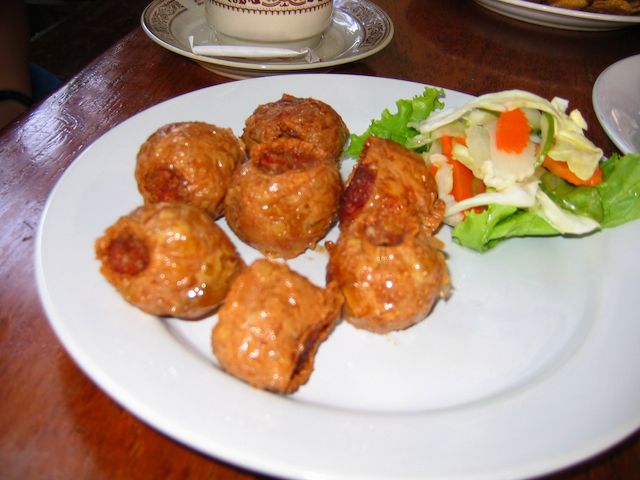
What we have here is more pork – spareribs this time, fermented and then deep fried.

Another speciality of the North I love is miang kam (this is always brought out as a starter at Baan Khanitha in Bangkok), and the beauty is in the simplicity. Pandan leaves are wrapped into a cone, and then a selection of ginnger, peanuts, chilis, dried shrimp, onion, lime, and roasted coconunt is added to be topped with a dollop of sweet sauce (I like the plum). But this can be varied to any adjustment of items (or rather tastes) you care to try.
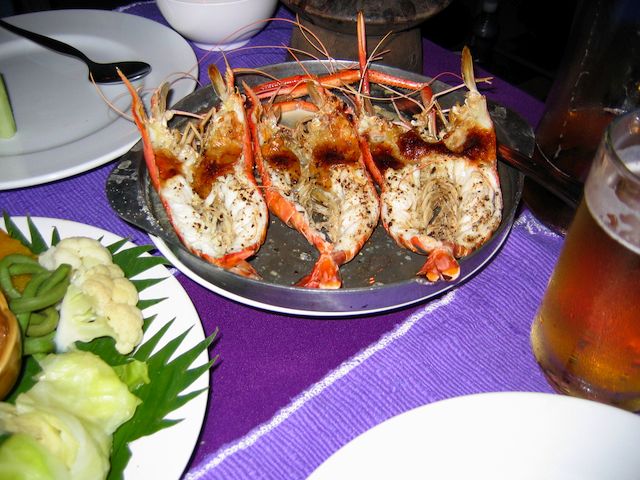
I’d say “don’t be scared to order seafood”. It’ll be relatively fresh, and it will taste good. The only down side is that it isn’t pork.

A lot of the seafood dishes will have a Chinese background to them, like this crab in vermicelli. The Chinese community with their traditional center in Waroraj, their big market on the Ping (conveniently across the foot bridge from where we’d taken a house off of Charoenraj.

If you look over to the right hand side of this shot, you’ll spot a bowl of dip, with some deep fried buffalo skin, pickles, and cabbage to go with it. Dips are a very Lanna thing.
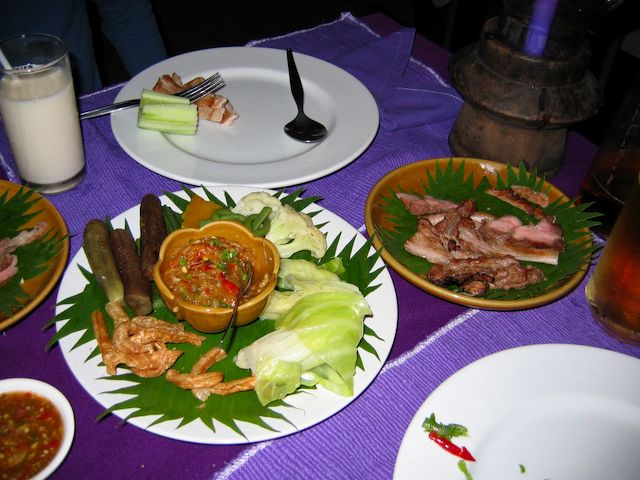
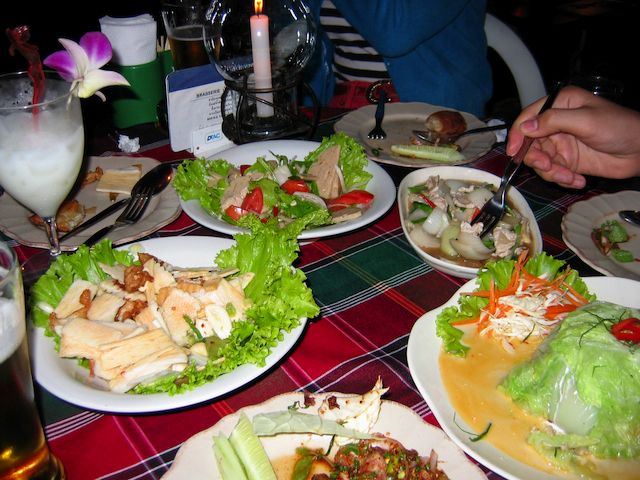
And mushrooms. Be sure to find as many different types of mushrooms as you can. There’s some of the local pate (yeah, I know, why not just call it spam) worked into a salad. This is very similar to what you’ll find in Saigon, Hanoi, and Penh.

Oh, and lest I forget….drink a lot of coconuts.
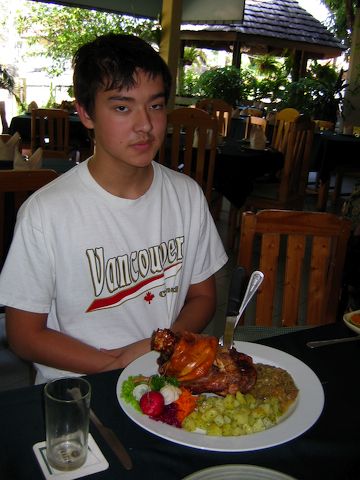
I said I’d pass on the Europeans, but friends of ours up there had taken us to “To Nobody”, a German restaurant. It’s a ways off the beaten path, but if you have wheels, it’s a nice break. The chef does an excellent pork knuckle (the Thai have a real weakness for German pork knuckles), and Scud considered it a personal challenge to finish it off (boy, does he look young here).
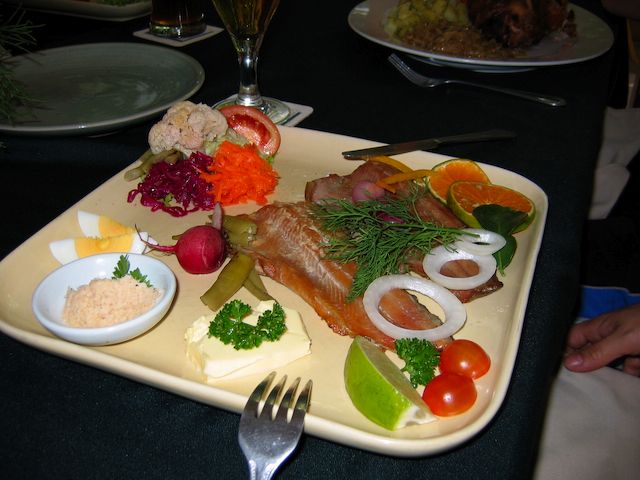
Of more interest to me, he’s drawing a lot of his material from the Royal Projects up here in the north, particularly the trout, which he’s providing here as a smoked dish. At the time (I’m not certain now) he was providing the Business Class meals on Thai.
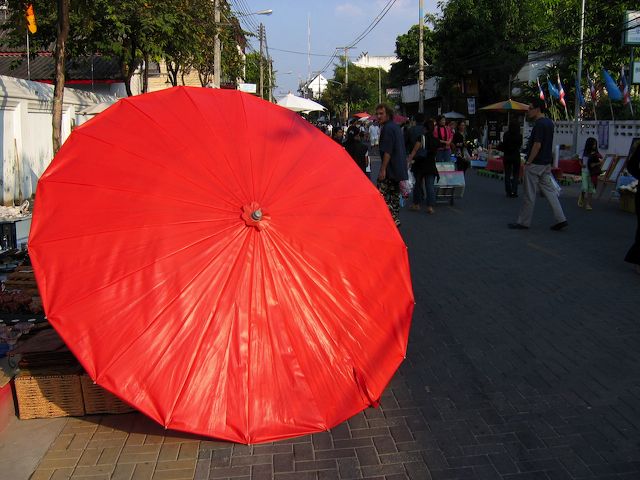
Keep an eye out for the Sunday Market on Rachadamnoern in the middle of town. It’s a good chance to find a lot of fun stuff for nibbling on, without the traffic (and the resultant pollution and noise).
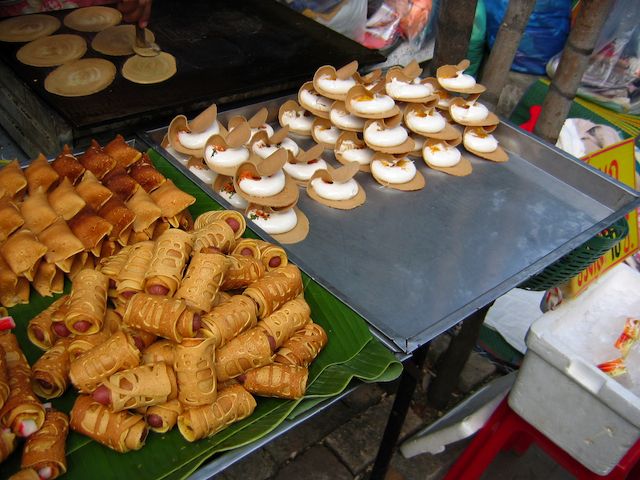
The streetside sweets are very similar to what you’ll find in Bangkok. I do love that fortune cookie egg based dough they do.
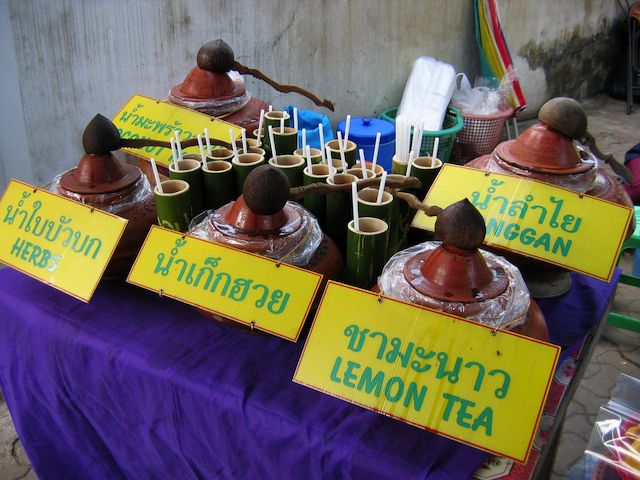
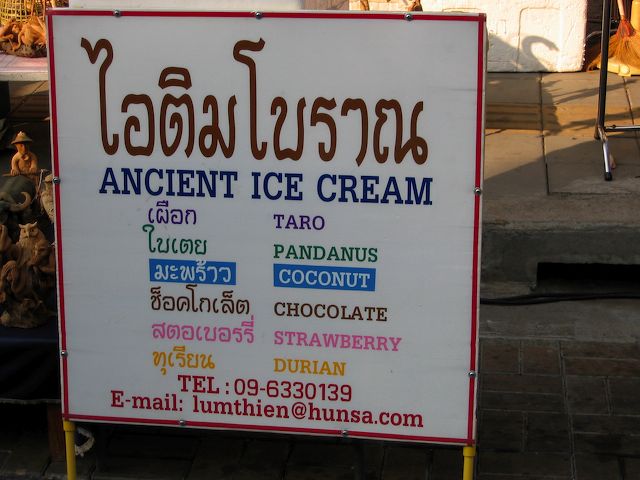
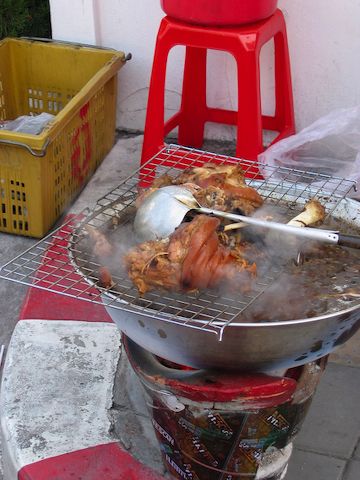
I already mentioned the thing about pork being good, didn’t I?
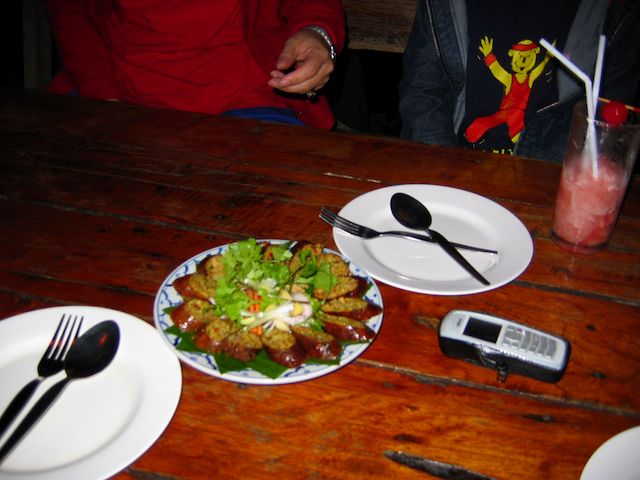
Besides pork, beef isn’t bad. Sai eua, the famous lanna sausages, are something that’ll stop me in the street anyday. Nicely loaded with burning evil green chilis, these’ll bring a tear to your eye.

And – we only found these at Antique House, the other one on the far side of the Ping (our side) – are crispy fried bamboo worms. You can also buy these at the airport to take home.
This is the Good View, but at early lunch. It’s very much an evening place, but we were quite content to wander down for a bit while Yoonhi and Scud were at massage school.
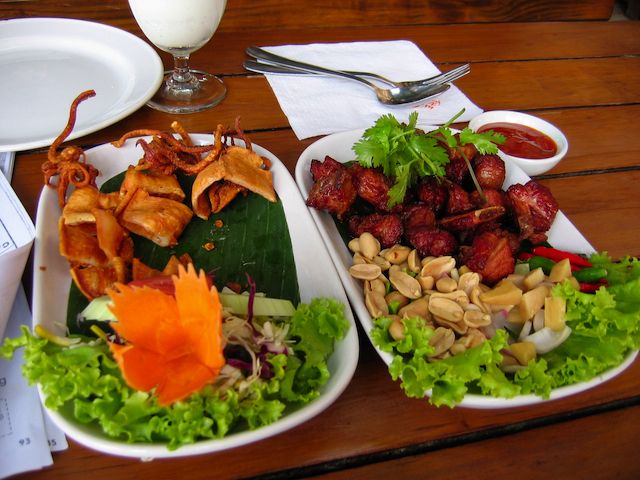
Lunch for me would be fried squid, and fired fermented pork ribs. Lots of bits and pieces, all taken with the fingers.
Besides coconuts, also take the time to get as much fresh fruit into you as you can. Somehow the pineapple in Thailand always tastes sweeter than anywhere else.
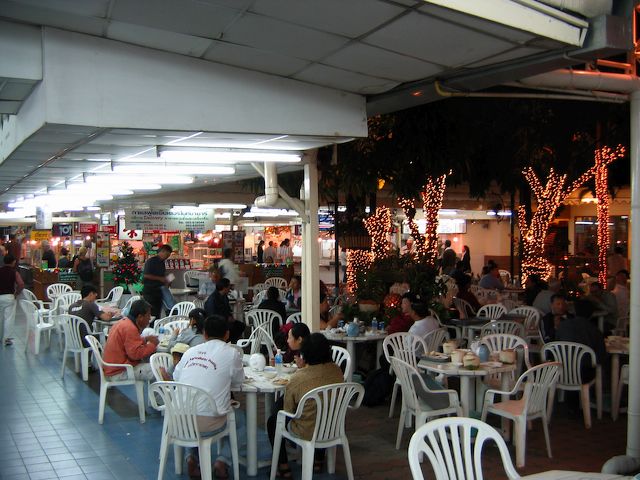
The food courts are always a safe bet. You’ll be at the Night Bazaar at some point, so the Galare Food Court across the street (I think that was the name) is a good choice for an hour or so of eating.
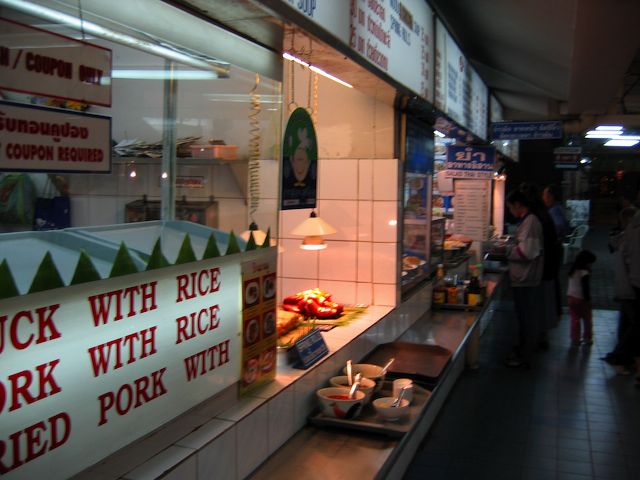
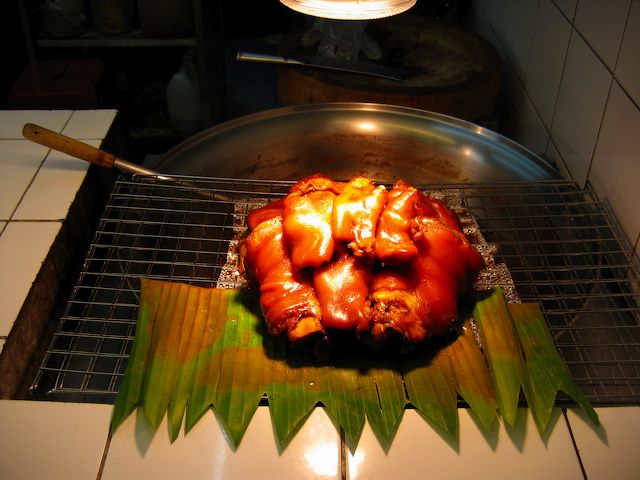
Pigs’ feet. How can you say no?
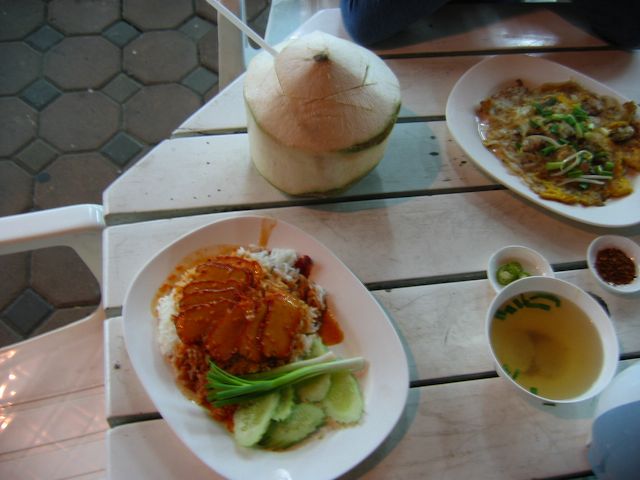
Here we have red pork on rice, and an oyster omellet.
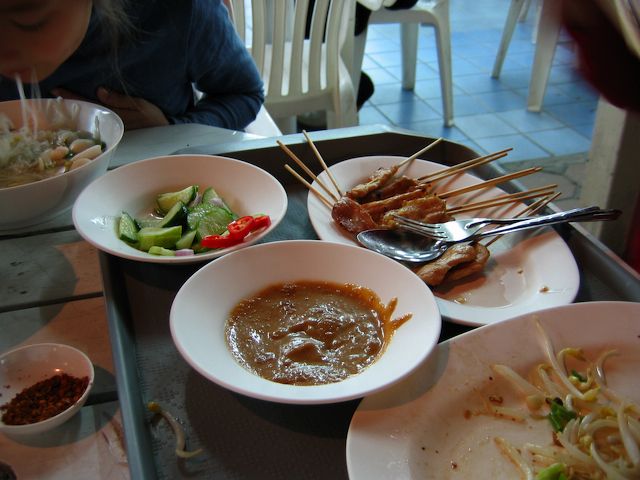
The pork satay is good, and the phad Thai didn’t linger around long enough to be photographed.
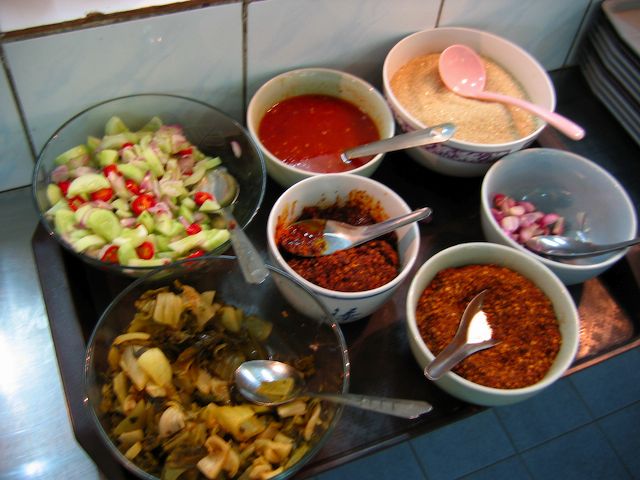
Feel free to work up your food to the desired flavoured, with a wide selection of chilis and pickles. The red chilis aren’t hot at all. Trust me.
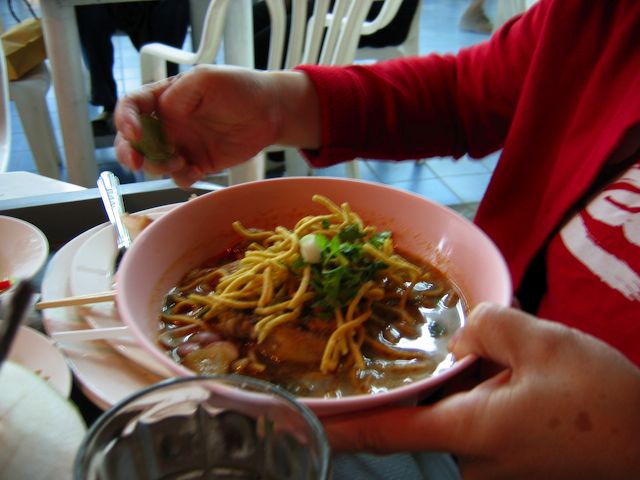
The khao soy isn’t bad here (but load it up with the pickles from the last picture).

And some of my friends claim this to be the best mango and sticky rice with coconut in the country.
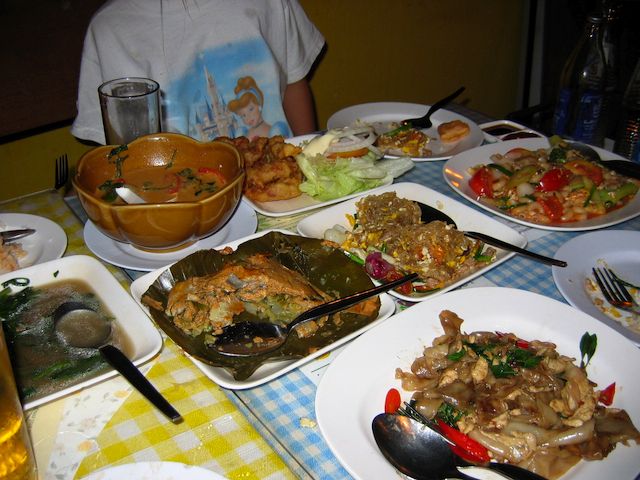
Besides the Chinese noodle dishes which are thick in this shot, you can also find kranab, mousses of chicken or fish roasted inside of bamboo leaves. These are worth hunting out.

And don’t forget to have some fish. A traditional prep is to fry the fish (the Thai are the masters of frying things) and then covering it with sauce, preferably loaded with chilis and garlic (at least, that’s what I always order).
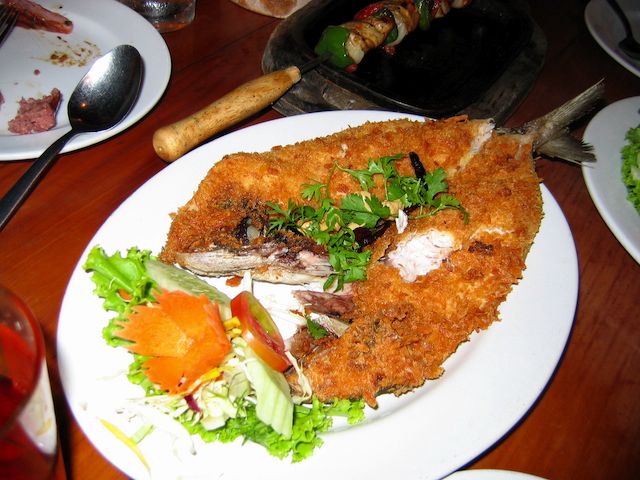
Another way to go is for the full frying experience. Crust and bread it, and go for the simple joy of oil.
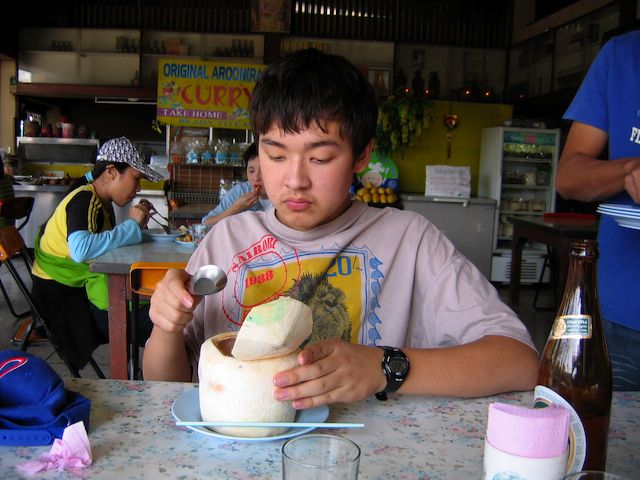
I did mention the part aobut coconuts, right? (By the way, Aroonrai isn’t fancy, but they do nice curries).
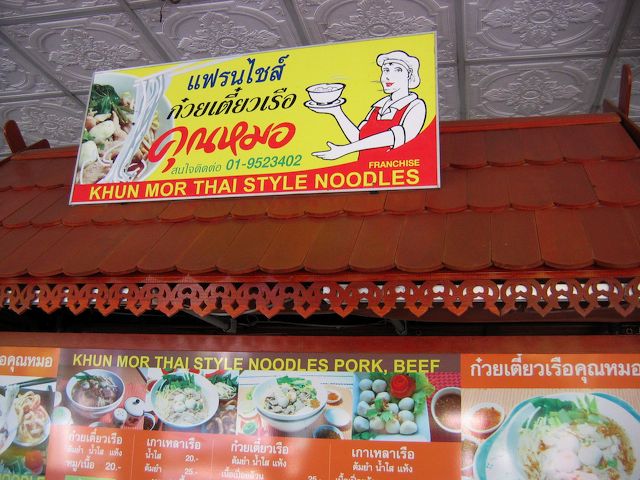
Remember I said to plan your days out? If you’re up around Nimmanhaemin Road, which’ll put you in a funky university neighborhood down below Doi Suthep, then you need to do lunch at this place. This’ll start arguments, but the lady doctor who owns this place does some of the best kway tieow noodle soups to be had.

Both the broth and the fish balls are excellent. I took Yoonhi here, and even she admitted that the broth was clearly above what we’d had elsewhere.
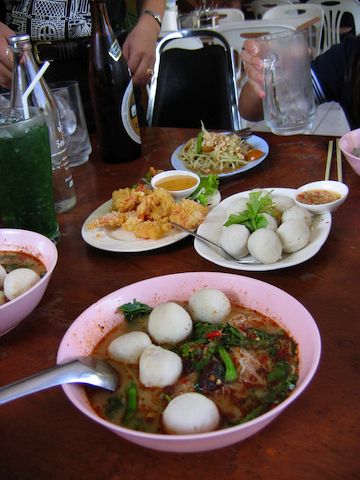
Our typical breakfast would be a walk across the footbridge to Wowaraj for noodles, but these left them in the dust (and they were about the same price).
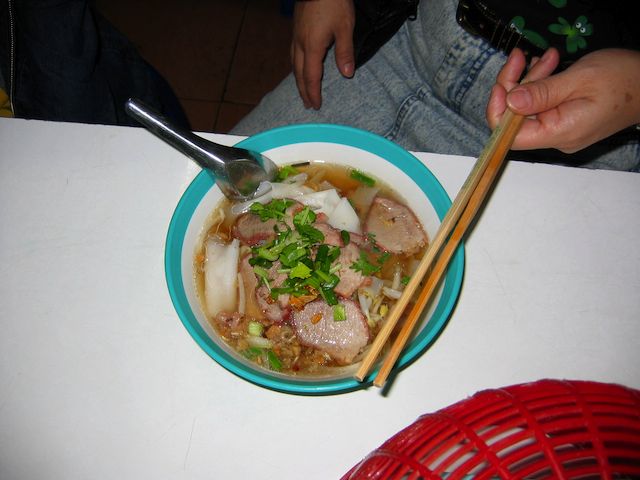
Here’s a comparison shot from the market (it doesn’t look bad, either, though, but the truth is in the broth).
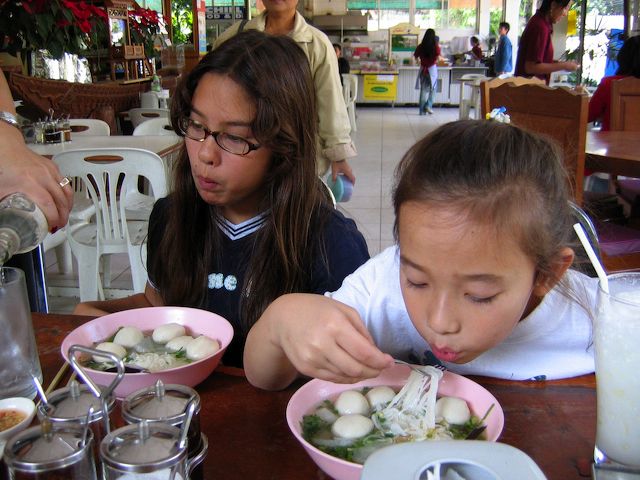
It’s not fancy, and it’s not expensive. Just ask questions until you get to the place.
Back to our side of the Ping, let’s look in ont the Good View at night.

Along with the food, you also have the added attraction of towers of beer.
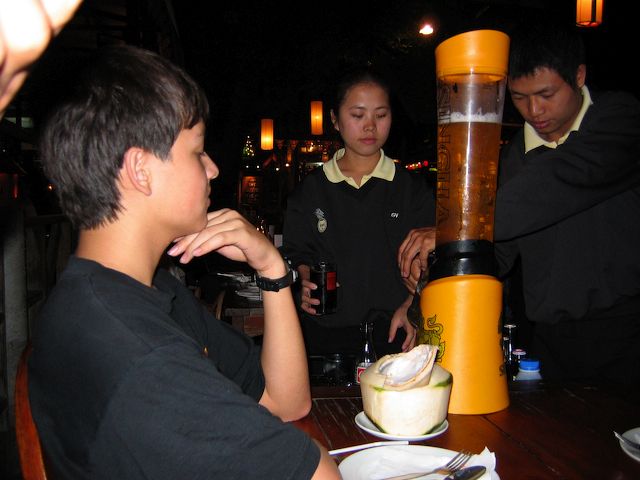
How can you not love this place? And I haven’t even posted the pictures of the beer girls in the leather police outfits!
There. That touches upon some of the things to be eaten. There’s lots more, but, like we said at the start, when you’re up here, take your time and just relax into things.
Lifes to short to be in a hurry.
-
March 26 – Things on Sticks
My plan consisted of walking around in Ryogoku looking for something good.
Scud was less than impressed.
Initially, we cut through the train station to see what was there. Train stations are usually a safe bet for eats.

Ryogoku is sumo, at least in Tokyo. Coming out from under the tracks at the JR station, the massive Kokugikan stadium loomed took up a big part of the night sky in front of us. I’d already mentioned that I liked this part of town. It’s just got a great feel to it.
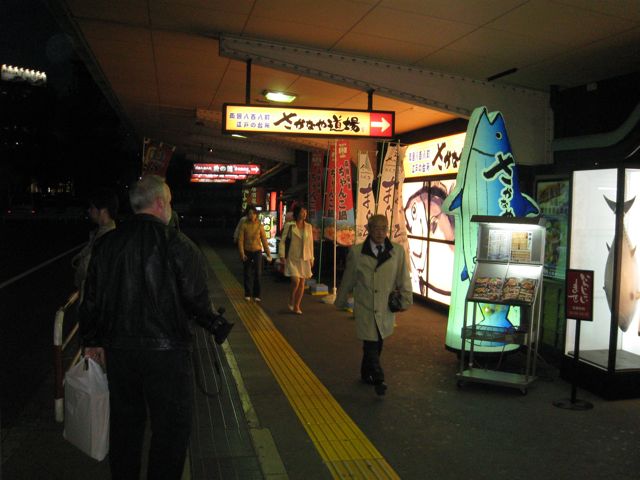
Part of it is the plethora of chanko restaurants, serving beer, beer, beer, and nabe.
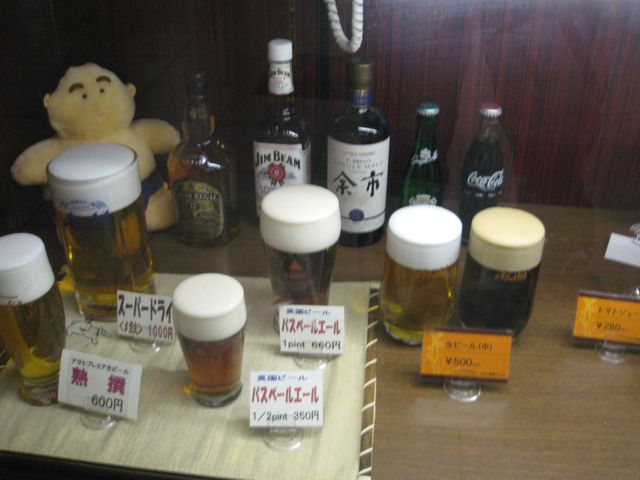
The other part of it is the history. It was here in Ryogoku that the 47 Ronin pulled off their hit on Kira Yoshinaka. It’s also here that Ryunosuke Akutagawa grew up. He’s still one of my favourite short story writers (yes, even more so than Murakami).
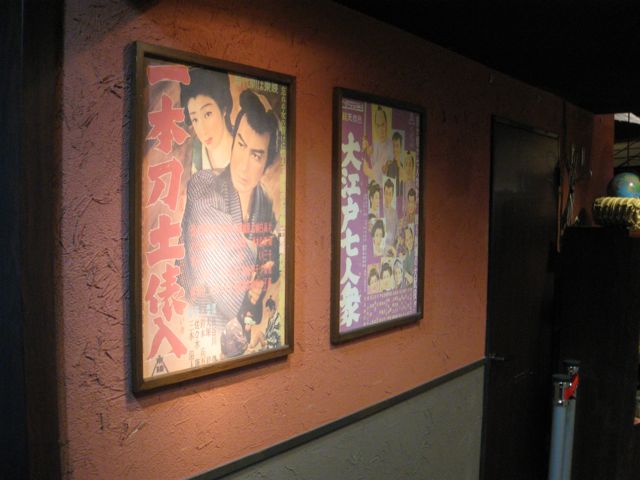
There’s a feeling of fullness around Ryogoku, like everything is packed just right. Not too tight, but with no slackness left about.
We ended up back on the other side of the tracks. We passed the masked young lady working yakitori over charcoal on the street, and impulse took me to ask for a couple of sticks. She shook her head, and indicated that we needed to go inside.
Decision made. We were eating yakitori.
I love it when a plan comes together.
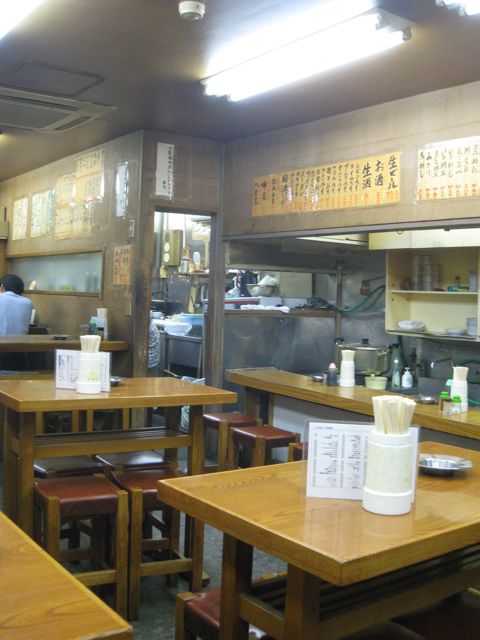
Inside was perfect. Glaring flourescent lights, a smoke alarm on the ceiling, chunky wooden tables, and a long bar fronting off a great collection of sake, beer, and shochu (and a mess to make me feel good about the state of my computer room).
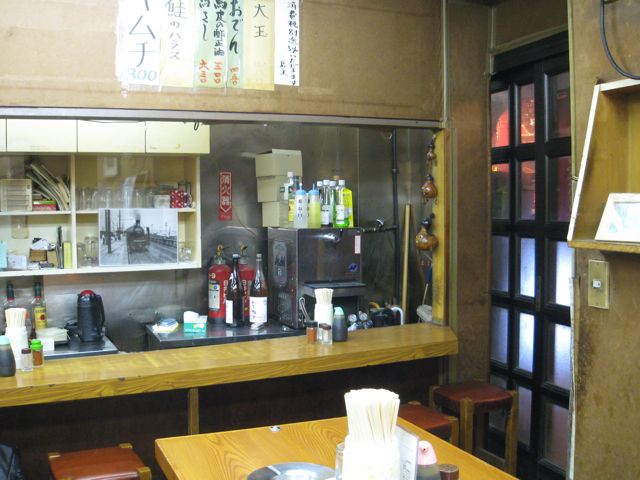
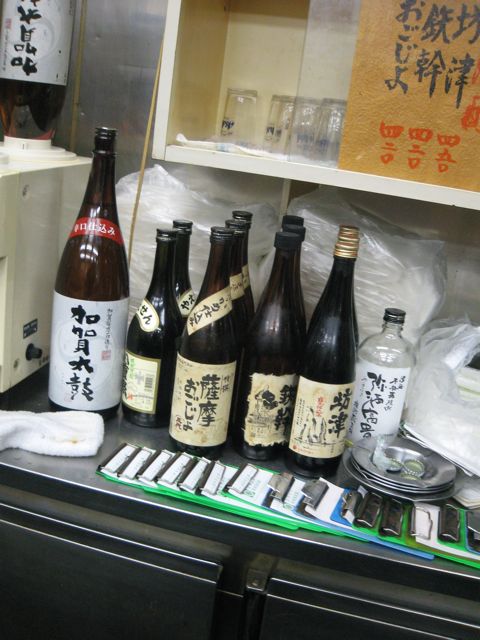
I started with some non-descript sake (hot) and I even sprang for some tap water for the Boy.
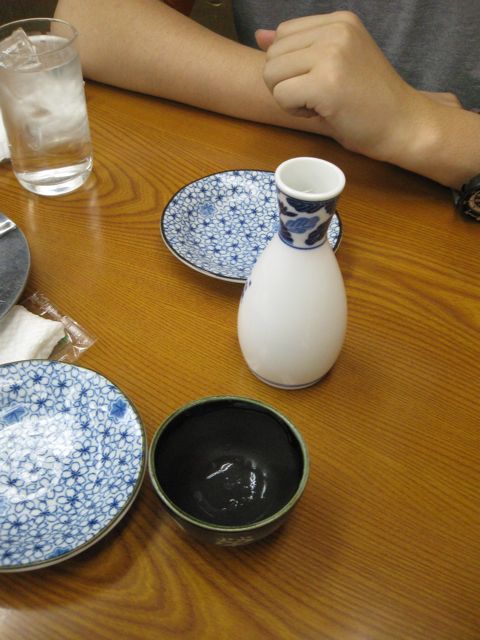
We ordered a eight chicken to start, half of them in soy, and half of them salted.
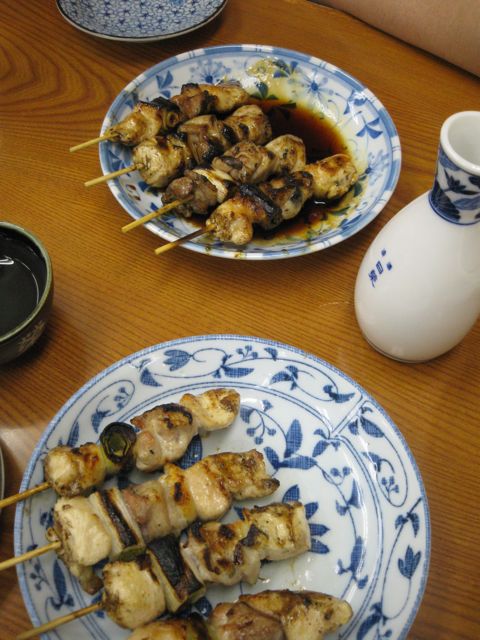
That was enough to get us started, and so I moved onto the next stage of the night’s entertainment.
Pantomime.
The older, smaller man who was running the place had incredible patience. And good humour. Through jabs and well placed hands, I managed to order some chicken hearts and liver.
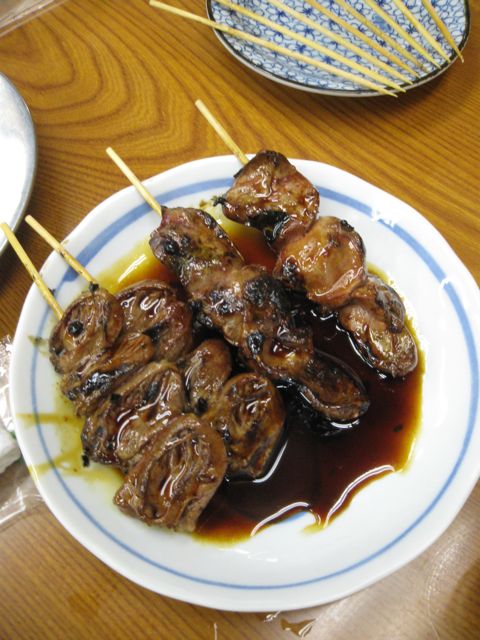
Both of these were good, the chicken heart with that Bill Cosby allure to it was particularly tasty.
There were three running the restaurant. The older, reserved gentleman who was manning the bar and taking the orders. An older lady with one of those voices that is just way out of place (if you closed your eyes, you’d think she was 10. Either that or a cat). And the younger masked chef working outside over the coals.
I was trying to puzzle through the specials up on the wall, and there were a couple that I was drawing a blank on. Finally, I went back up to the counter, and did the Marcel Marceau thing again.
One of them appeared to be quail eggs. The other was more difficult.
The older gentleman craned his head around to read the sign, smiled, and then pointed at my crotch.
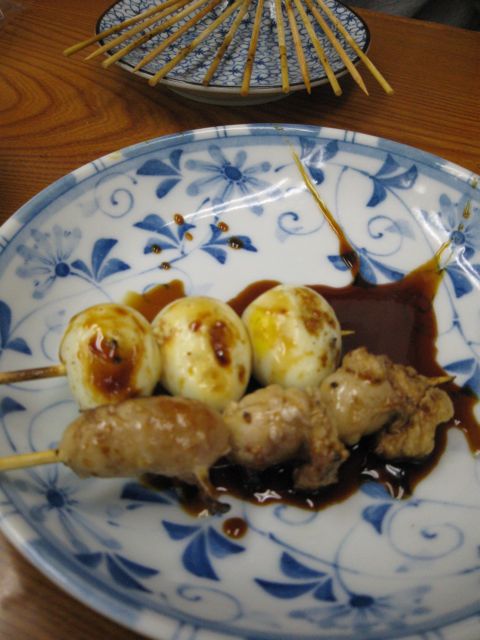
The quail eggs were a little tough on the outside, with a lot of chew getting through to the yolk. The testicles were that sort of soft, sweet meat consistency. Nothing coarse or gristly about them.
Scud refused to go near them.
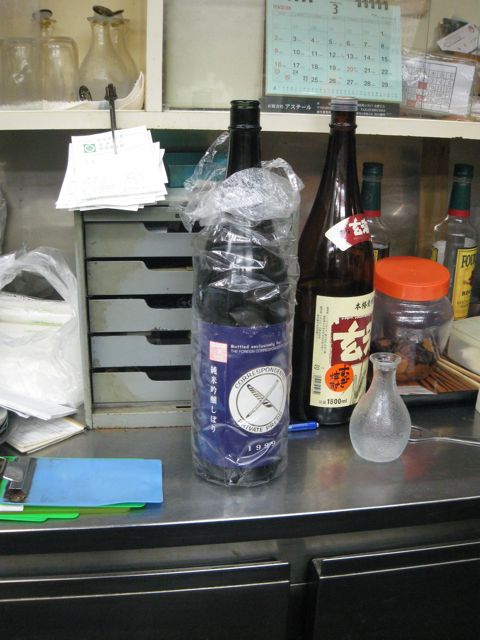
There was also a sign up for a more expensive sake – Correspondent’s Club, at 700 yen. It’s a 1999, and the lable claims that it’s bottled exclusively for the Foreign Correspondent’s Club, which begs the question, what’s it doing here?
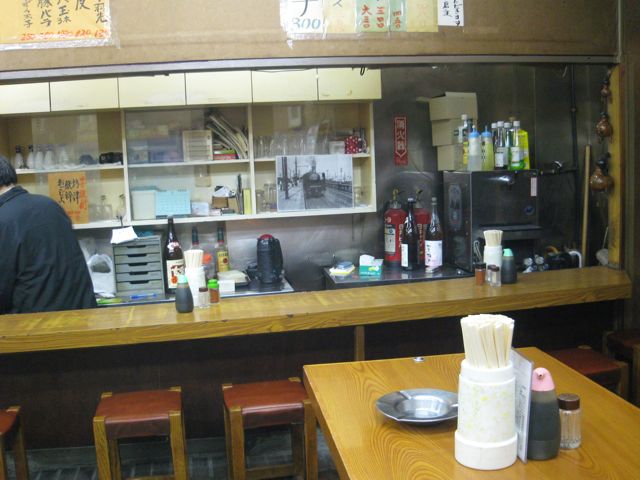
I dallied with the idea of a beer, or maybe some shochu, but I felt that now was the time for sake.
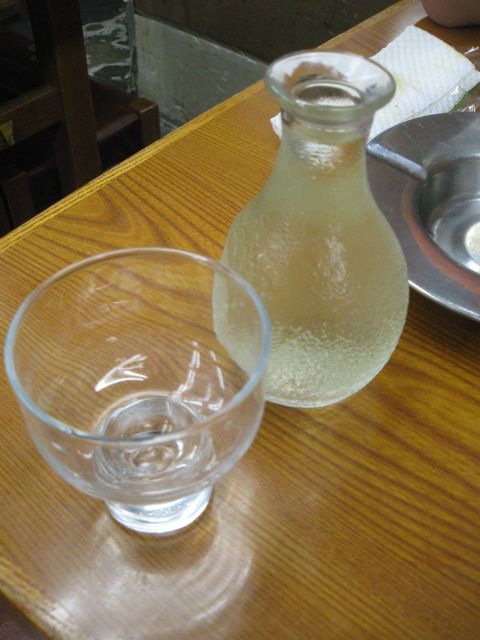
A nice enough sake. Served cold it had a very clean smell. In the mouth there was a bit of citrus, and a taste that passed away fairly quickly, leaving a dry mouth.

Next we found the pig belly and some pork neck, all glistening with fat. We loaded up on these, figuring this would probably wrap up the evening.

We finished on the pork, and I took a few minutes to enjoy the last of the sake. We thanked our host, paid the bill, got the cook to pull down her mask for a smile, and headed for the underground to get the train back home.
Just as we were beginning to head off, though, our host came running out to present us with a thin piece of paper covered in kana and kanji, that looked like a sumo programme. But he was pointing to one particular line to the left of the centre, and just down in the finer font.
I was confused. I’ll have to figure out how to scan it without damaging the paper, and get some advice.
With that, we headed home.
-
Thanks for the update. And, Pilsner from Echigo Beer? Niigata has a number of wonderful local beer (ji-beer) breweries, and Echigo Beer is Japan's first local beer brewery.
Official website of Echigo Beer:
http://www.echigo-beer.jp/index.html
Edited to add: Butter on the potatoes: Was it really butter, not margarine?
Margarine? Good point! It didn't seem quite as malleable as marg usually is, but I'm not an expert.
-
March 26 – Part 2 – Old Town
I figured, as long as we had to cut through it in order to get to Kappabasha dori, we might as well do the tourist thing.
Asakusa.
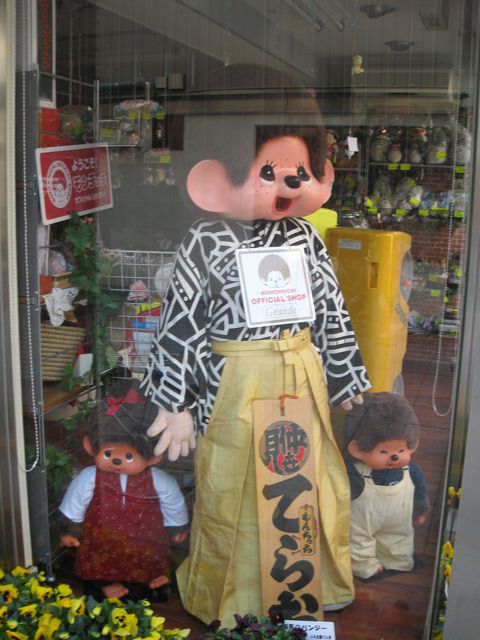
It’s a tourist trap, but it’s still fun. And it looks almost exactly the way I remember it looking when we were here 14 years ago. The shops selling stuff for the temple, the dried snacks all tidy on disply curbside, and the usual gewgaws.
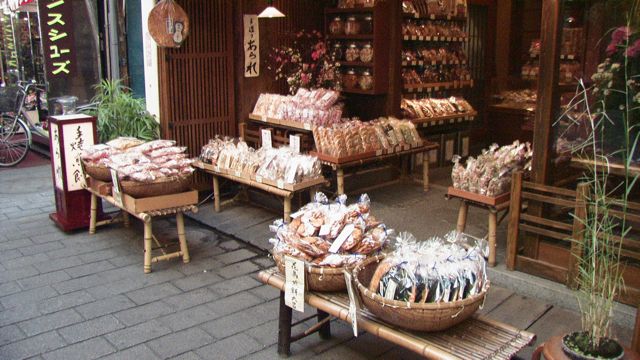
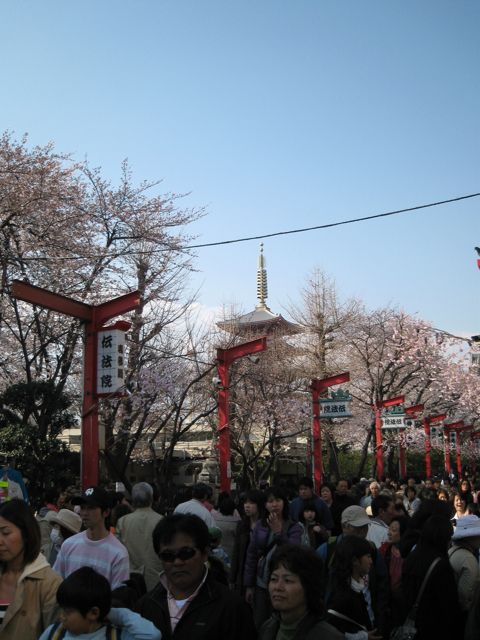
And, as a bonus, the cherry blossoms were just coming out. We had’t missed them after all.
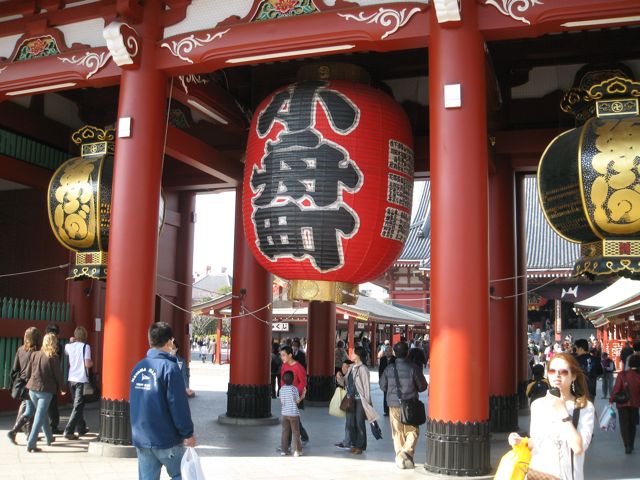
It was jammed with people, everyone on their way to the big temple, the Senso-ji, a tribute to Kannon, the embodiment of mercy and to the lack of common sense on the part of two fishermen who tried (repeatedly) to throw away a gold statue that showed up in their nets on the 18th of March, 628 A.D. Those darned gold statuettes are such a nuisance, and you never have the proper license for them when you head out fishing in the morning.
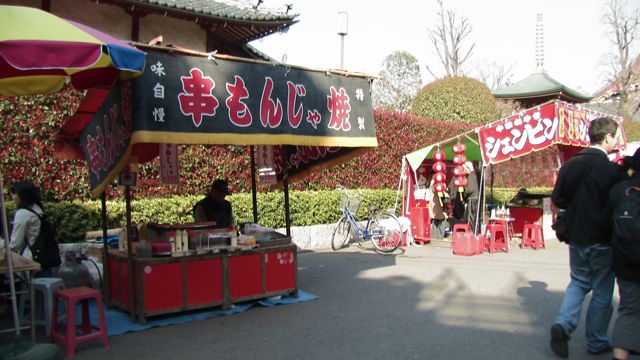
The big temple is impressive enough, but how many of these can you visit? Okay, one is a bit of a push for the two of us. Scud and I were more curious about the collection of little stalls on the side. These were in the direction of Kappabashi dori anyways, so we stopped for a bite.

Roots and tubers. Steamed and ready to go. I was confused by the ones on the far left. They almost looked doughy…..we ordered one. What the heck.
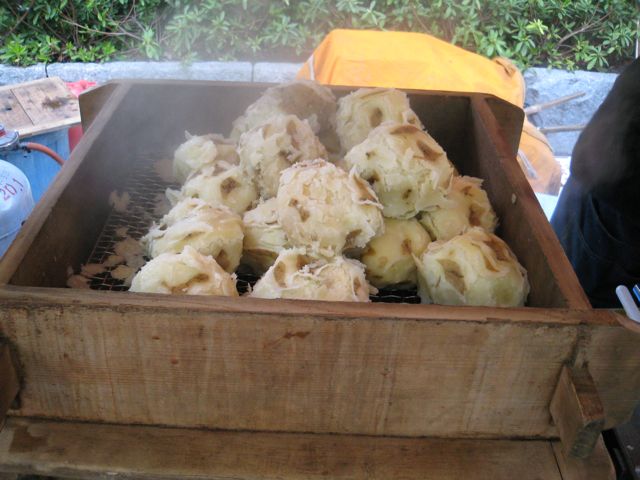
Potatoes, duh! Steamed, and loaded up with salt and a massive lump of butter.
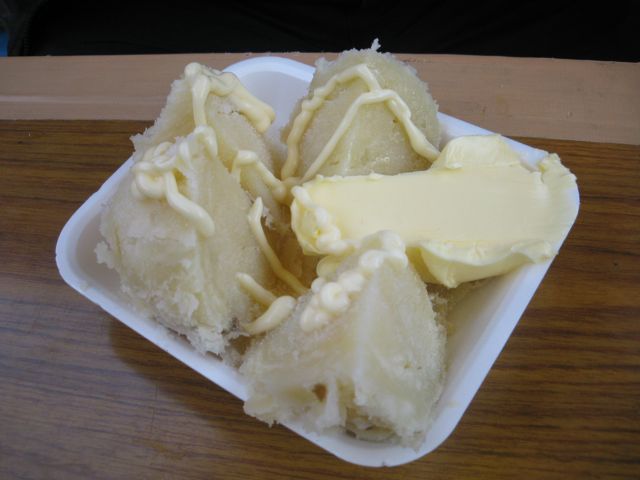
There’s another thread going on, JIs Japan Starving?, where there's a discussion on how butter has disappeared from the shelves of the supermarkets. I’ve solved the mystery. It’s all here at this stand.
I mean, I like butter as much as the next person…..okay, maybe a bit more than the next person, but, still, I had problems working through the mass of fat that had been spatula’d onto this potato. We did our best, but there was still a couple of dabs on the styrofoam at then end of it all.
With our monthly intake of dairy fat and salt in us, we continued our Journey To The West.
It’s a nice walk, with the neighborhood being very much that, a neighborhood. The trappings of the tourist zone fall away as soon as you’re out of the covered arcades, and you’re back in a working people’s area, with shops and small factories
After a few minutes of walking through narrow alleys, and past a few interesting looking shrines, we came to that famous marker of the street of food equipment: The Imprisoned French Chef.
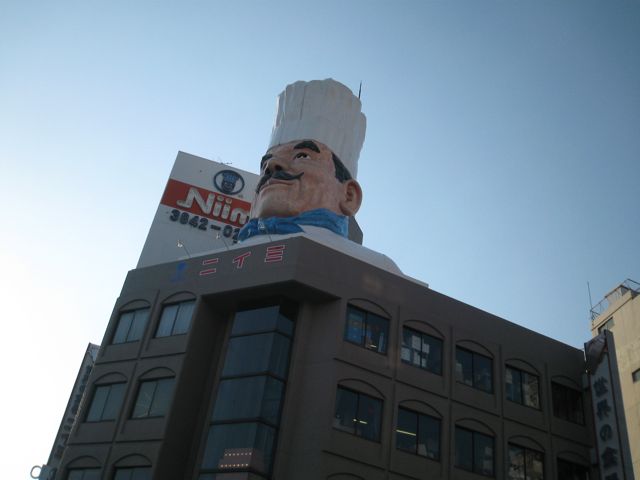
I explained to Scud how Pierre (that’s his name) had been fused into the building by the Self Defense Forces after the 80 foot tall monster chef went on a rampage in this part of the city.
At least, that’s the story I tried to feed Scud. I swore up and down that I’d taken it from that famous book of modern history “Monsters Are Attacking Tokyo”.
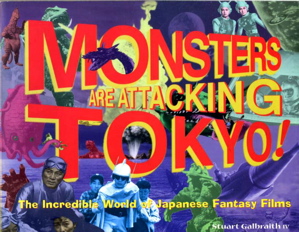
He doesn’t seem to believe me as easily nowadays.

Anyways, the street of food gear – Kappabasha dogu gai.
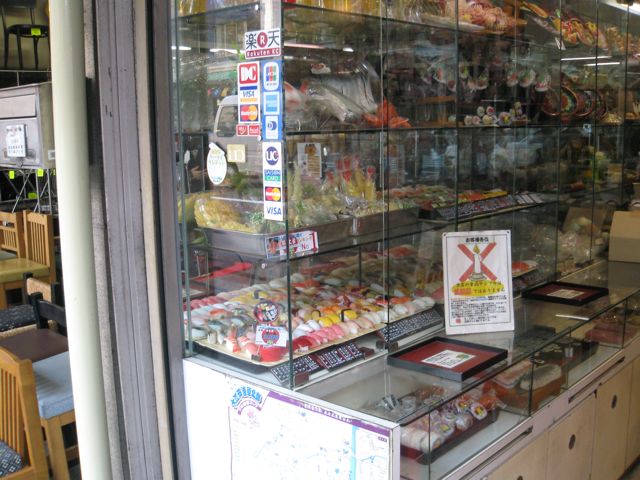
As you’d expect, you can buy all the stuff you might possibly need for a window display. There were windows full of sushi,
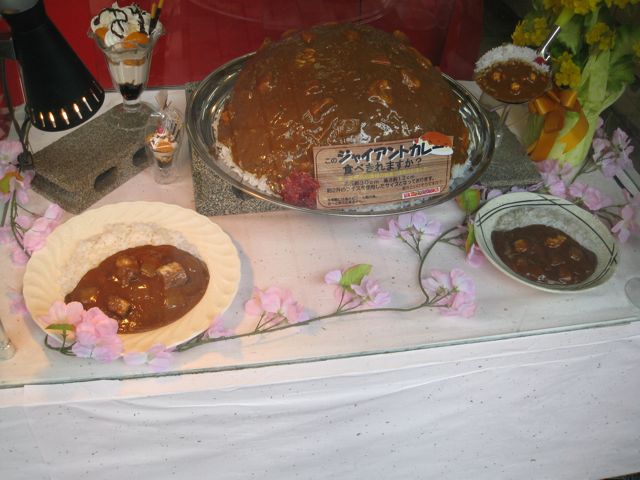
And some of the biggest mounds of curry rice you’re going to see anywhere.
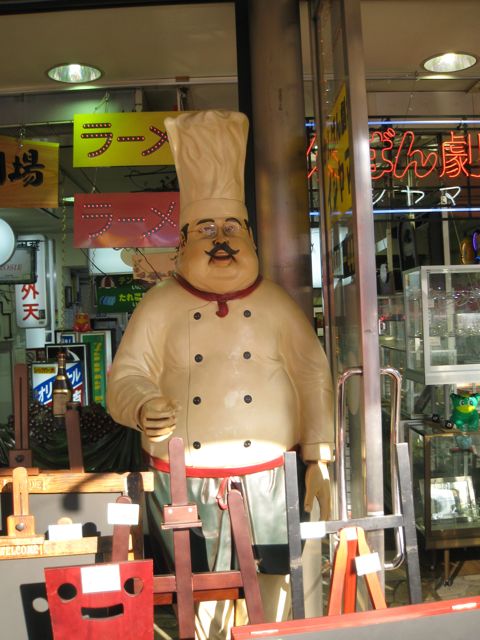
You can even buy a life-size statue of me to scare small children and aircraft with.
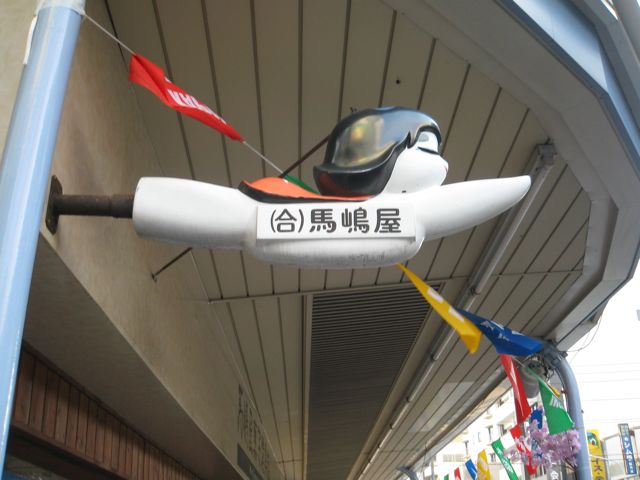
The street signs were a curiousity looking an awful lot like Buttercup from the PowerPuff Girls, but I’m pretty certain they predate that series.
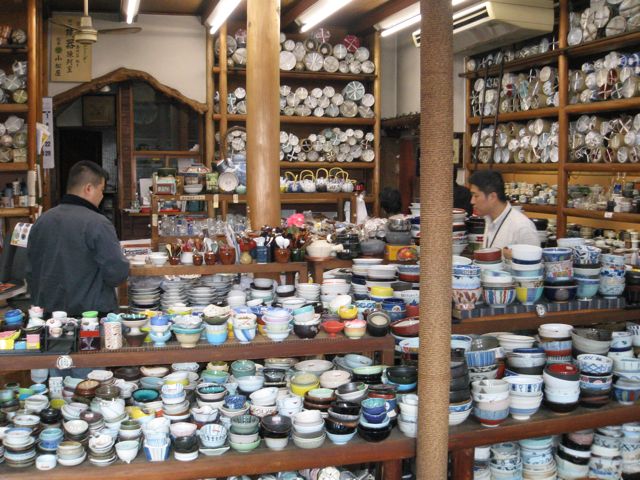
The porcelain gave me cause to pause. I could use a few more pieces, if I could bring them back in one piece.
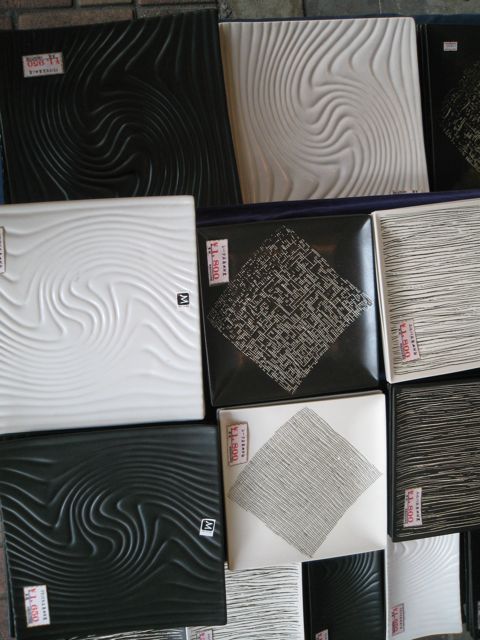
I figure, you always need a few more serving pieces.
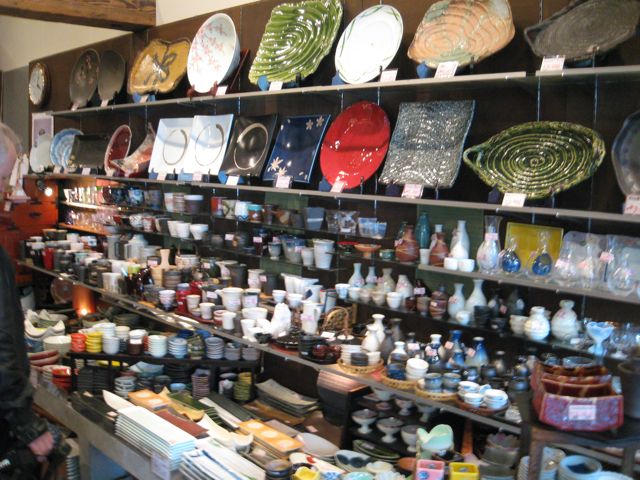
And, as you’d expect, there were plenty of places selling pots, and a couple of very good looking knife stores. But I was on video and Scud was on still, so you won’t be seeing any of that.
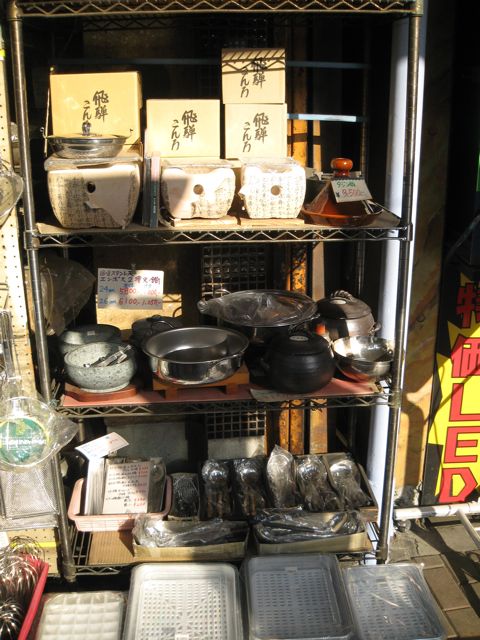
I caught sight of something I’d been looking for, and bought a ying yang hotpot. Why is it I have to go to Tokyo to buy something for a dish from Chengdu?
Strangely, what Kappabashi doesn’t have is a lot of restaurants. Lots of equipment, but nowhere really for it to be put to use.
It’s odd, as you’d think there’d at least be a place for cucumber rolls – kappamaki.
Which puts us on the topic of kappa.
The picture didn’t come out, but there’s a pretty little statue of a kappa. The kappa is another member of the Yokai, the ubiquitous water spirit that haunts streams, ponds, sewers, and toilets. He carries a small puddle of water in a depression on the top of his head. He’s also bound by a keen sense of etiquette, so, if you’re in trouble with one, the trick is to get them to bow, spill the water, and then they’re yours. A handy thing to know if you catch one munching on a small child. The cucumber reference is because their second favourite food (after human children) is cucumbers.
It’s another odd coincidence. I’d read about Kappa in Murakami’s Hard Boiled Wonderland and the End of the World, but that was a long time ago. And then, a week ago, a friend loaned me a film about a Yokai war in the the Northeast, the hero being a wolf, but with a swamp scene with kappa. And then today I was watching a new anime with Serena – Karas – in which kappa appear as serial killers in the toilets of Shinjuku.
Poking around on IMDB for the title of that film (Kiba something or other) I also see that Takashi Miike has a 2005 film, Yokai Daisenso – The Great Yokai War, which echos of Pompoko.
So, you just never know.
Where was I?
Dinner was going to be something we’d want in the not too distant future, so we started walking back in the direction of the underground. It’s a good part of the town to stroll through, as there are still a lot of the older, smaller shops about, and these gave us an opportunity to stare into windows and make a nuisance of ourselves.
I even found a go store, with proper-sized boards. I’ve never done well with getting Scud to take up the game (perhaps it was the taunting and jeering?), but I was sneakier with Serena, and found a go anime for her. She really enjoyed Hikaru No Go, and so I’ve set the stage for her to learn. The theme of Hikaru No Go is that a young boy, Hikaru, finds an old haunted go board. The board comes with a metrosexual go tutor from the Heian days who takes a fond interest in the little boy. Lots of dramatic scenes of go stones being placed dramatically on the board. Talk about excitement!.....
Ahem!
I won’t say I was disappointed, but it’s a little sad how go has fallen out of the limelight in Japan, and even Korea. Ten years ago there were go schools all over Korea, and I should think they were still popular in Japan (from the magazines I subscribed to then), but the world of electronic gaming has left the black and white clam shells behind.
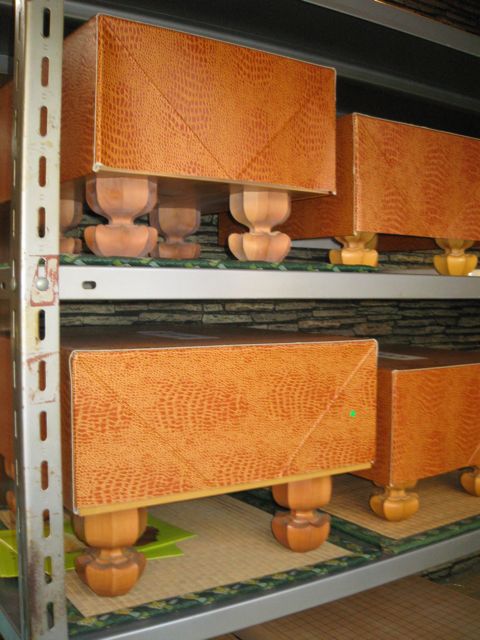
I couldn’t even find a go channel on tv. Sniff!
From where we were, it seemed reasonable to target Ryogoku for an early dinner. Scud was in favour of this, and that was good enough for me.
We were going back to Popeye.
Scud was really concerned that we get there before the crowd descended upon the place for happy hour. He remembered how crowded it had been the other night (when we were there at 9 p.m.) and assumed that the world would rising up en masse to fall upon the doors of Popeye as soon as they opened.
So, at 4:50 p.m., we had a ten minute wait before they would be starting service.
This is okay by me, as it provided a chance to do some shooting with decent light. The staff had no problems with my taking a few pictures, and were happy to discuss bits and pieces of the beer business.

I really haven’t done much to cover their bottles. They have a seriously impressive selection of Belgians, I must say, and, as we saw the other night, the glasses to match them.
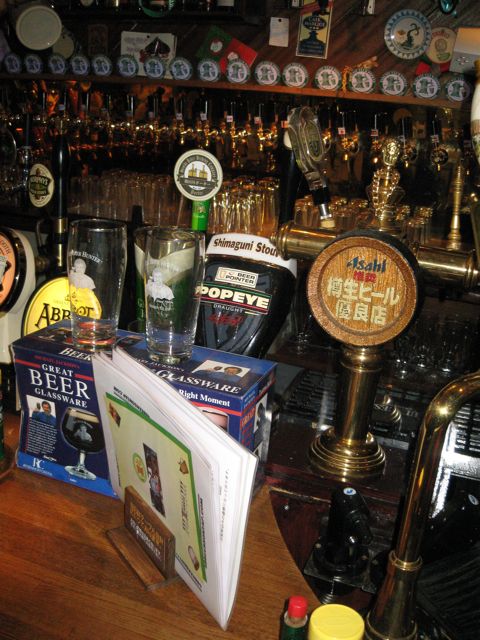
But it’s the drawing line behind the bar that really gets my respect. Forty beers is an easy phrase to toss about, but when you see the massed line of taps back there, you get a better realization of how much goes into keeping that many lines up, stocked, and running.
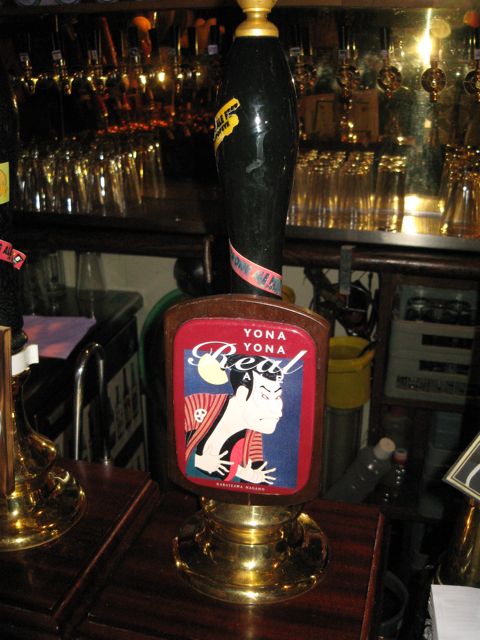
And there’s Yona Yona, one of the pioneer micro-brews of Japan. And they’ve got the coolest coaster.

Our starter this time was a salad with some chunks of fried octopus.
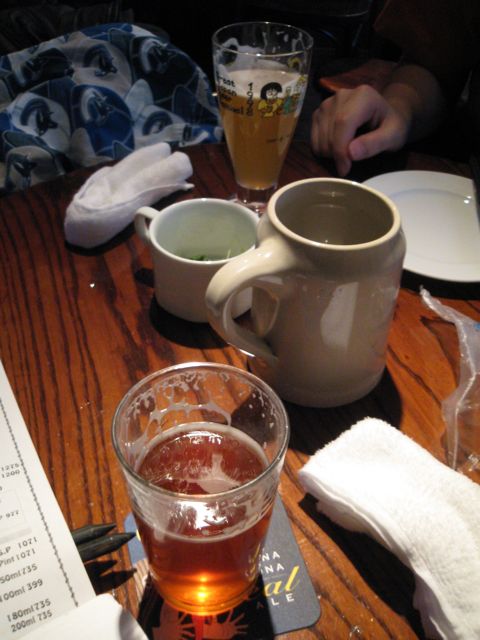
Scud went back to the Weizen, this one a Ginza Kougen (from Iwate) with a good cloud about it, and a fairly decent head, one that held on longer than I’d expected. It was sweet, with a full mouth, which is what Scud was looking for.
Myself, I had the Shiga Kougen IPA. Good and hoppy, with enough bitterness about it to make me happy.
The Kougen group is probably the largest of the small in Japan, with four brew restaurants in town, and their pulls available here, as well.
We had another plate of the sausages (the trio) we’d had the other night. For Japan, Popeye has an excellent happy hour deal. They don’t do anything about the price on beer, but with selected beers on the menu (about a dozen of the draughts) you get a free plate of food. Given that in Asia you should eat while you drink (sensible) this takes a fair bit of the financial burder off of a night out.
Plus, I like the food.
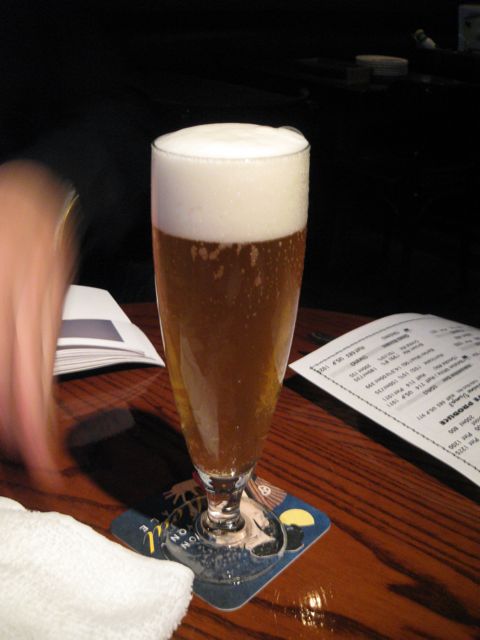
We were doing halves in order to cover as much ground as possible…..well, as much ground as possible and still remain relatively lucid. Next was a Nide Cream Ale. This had a beautiful head, creamy in texture and cratered like the moon with large bubbles breaking clear from time to time. The bubbles in this were relatively light, and the beer came over as clean, and surprisingly transparent for a cream ale. This was a good, straightforward beer, but a but mushy in the mouth, lacking a bit of definition.

Scud stayed with the Belgian theme, and went for the Belgian White from Hakusekikan. This had been second in our tasting from the other day, and the Boy felt it was worth a reprise.
Our prior tasting notes put this as “on the sweet side, with a bit of tang in there, and a reasonable presence of hops”. With a bit more time, and more volume to work with, I’d add a nose of flowers and herbals. The beer has the expected cloudiness, and the head is holding up rather well. It’s still a little too sweet for me, but it’s a good example of a Belgian White.
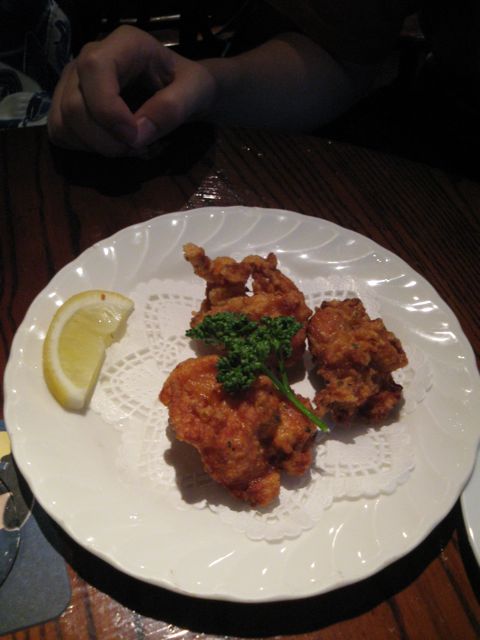
Scud ordered a plate of deep fried things, taking Rona’s excellent advice to heart. These were hot and fresh, heavy on battter with the chunks of chicken in there, too.

Next was an Echigo Pils from Niigata. This had a good opening, with a well variegated head and a nice initial flavour, but then the head passed quickly into the Great Beyond, andd there was a sad aftertaste that I couldn’t wash away. Because of the ceramic mug, it was hard to judge the colour, but “kinda orange” would sum it up best.
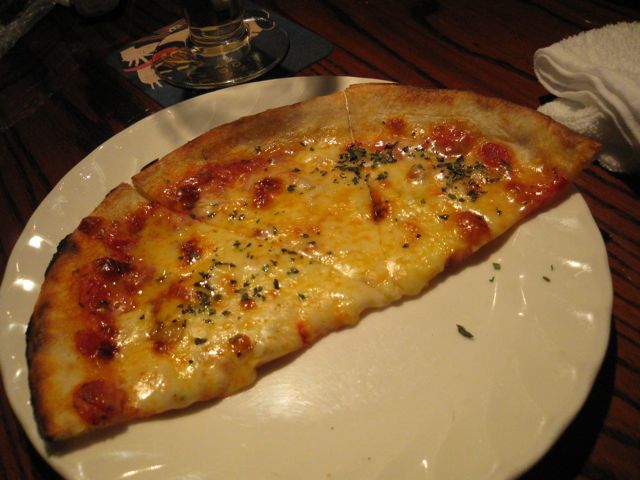
And we went out on a wedge of cheese pizza. We’d wanted to try this as a comparison piece to the odd quiche-like thing we’d eaten in Osaka. This came out much more as a “pizza” with a thin but not dry crust, and a good topping of mozzarella and herbs.
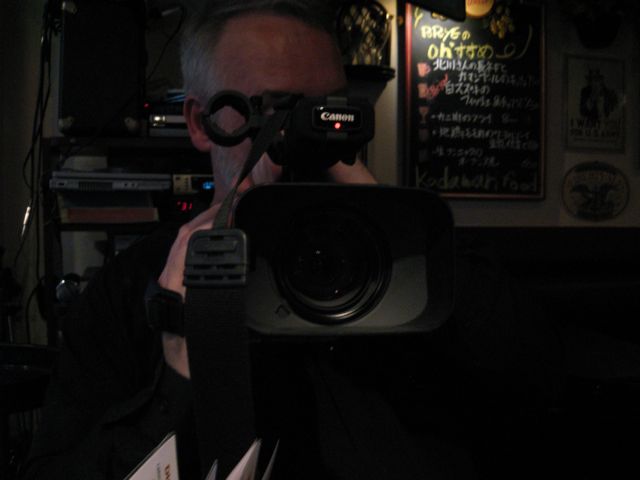
I admired the Tower of Beer that had arrived at a nearby table, a meter or more tall, 2/3 beer, and 1/3 head. The bottom 1/3 was wrapped in ice to retain the chill.
I was sorely tempted, but Scud warned me that if I ordered one of those, he was having another baked Alaska, and that would put a serious filler in our dinner plans.
“You have a plan?” Disbelief painted on his face.
“I always have a plan. Just, perhaps, not one for this reality.”

Note: For a lot more detail on the brews of Japan, Bryan Harrell has a great column on Bento.com covering the beers of Japan. He also has coverage of the April 20th tasting that we almost missed mentioning the other week (did anyone go?).
-
Yoonhi recommends Kadoya.
Korea will probably disown her.
-
March 26
I careen from success to failure.
Last night’s dinner had been good, and Scud came away with a number of new ideas about how to eat and what to look for in food.
He’d found several items in the meal, the bamboo with uni, the truffled rice, to be quite appealing. But he also found the atmosphere a little suffocating at times. This had been my reaction as well, which is a little odd, as what I’ve read of Kadowaki describes it often as more “fun”. Of a chef doing what he enjoys, creating the food he wants to create for a clientelle that appreciates it.
Mind you, some of the “literature” also says that one of Kadowaki’s issues with not courting the Michelins was that he really didn’t want to position himself as a spot on the tourist trail of Tokyo.
Of course, is there a surer way to put yourself on the tourist radar other than proclaiming that you don’t want to be there?
Would Scud and I have been there? Do we get more touristy than us?
At least I’d made Scud wear his Armani.
Anyways, after a good meal the night before, it would have been nice to start off with something pleasant this morning (although we were close to pushing lunch).

Off the mark and around the corner, Scud suggested we try the local sushi place. I considered it, and then made my usual fatal mistake.
“Let’s just look ahead a little bit more.”
Before you know it, were halfway to Azuba-Juban again, and the path behind us is all uphill.
Have you ever noticed that, when you don’t want sushi, it’s everywhere?
We wanted it. It wasn’t.
I wish I’d known where Sushi Gin was.
We made it all the way to the Azuba-Juban underground station, and Scud was fuming. I did find a place with sushi, but it was only for take away. I suggested we eat in the park, but the icy glare didn’t hold out well for that.
So……..
I said “let’s go to Tsukiji. We know there’s sushi there.”
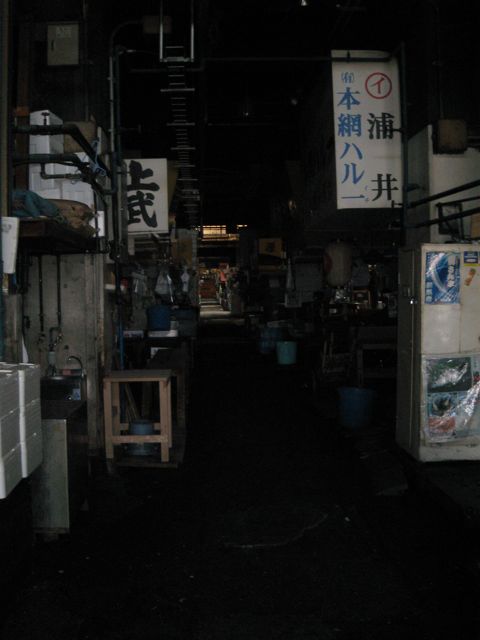
Tsukiji market is really, really, really quiet around twelve noon.
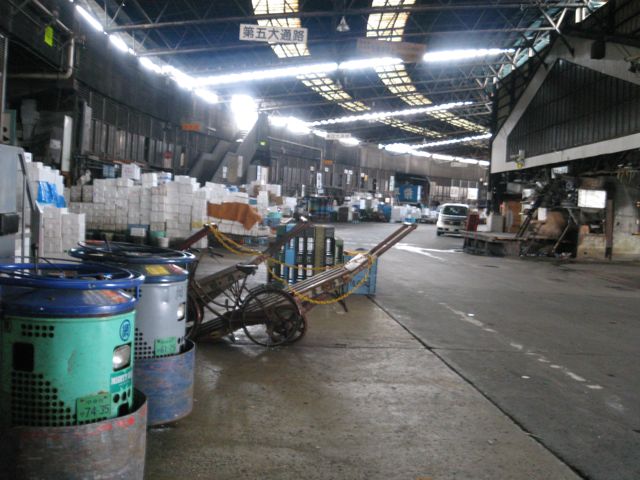
Really quiet.
I was kind of getting into prowling through the dead alleys, only cats scurrying around to show a sign of life. But I could tell that Scud wasn’t too impressed (although he did like the cats).
As a follow up to the previous Tsukiji post, we did go by the Mountain of Styrofoam, and it was gone. The whole thing was empty out, except for three lonely little pallets that were bouncing around in the wind. Either a paeon to recycling, or else the rubbish truck shows up around 11 to clear the place out.
I traced our way back to the spot we’d eaten at before, but then noticed the smaller place across the street was open – Sushi Ten, I think it was - so we decided to give it a try, instead.
This place was a lot more relaxed. It was also a lot smaller; basically, if it hadn’t been a hard roof on top, I’d’ve classified it more as a tent. The sound system was one perky iPod nano stuck into the ceiling that was playing a mix of j-pop and 60’s folk musice, and the seating was a counter for four and about three small square tables for two. Scud and I took one table, and our cameras another.
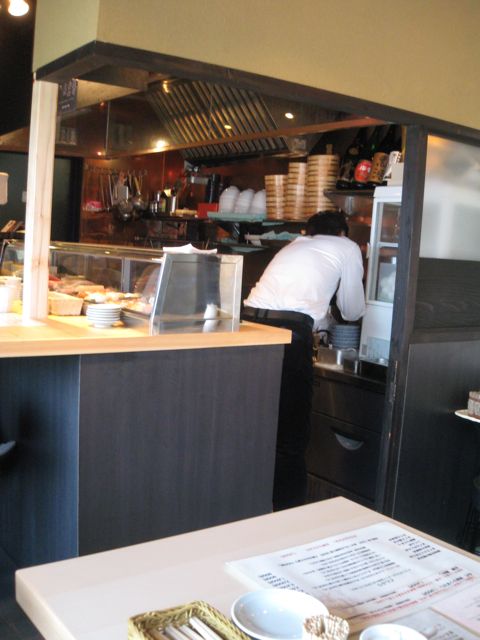
I liked this. It had a good comfort feel.
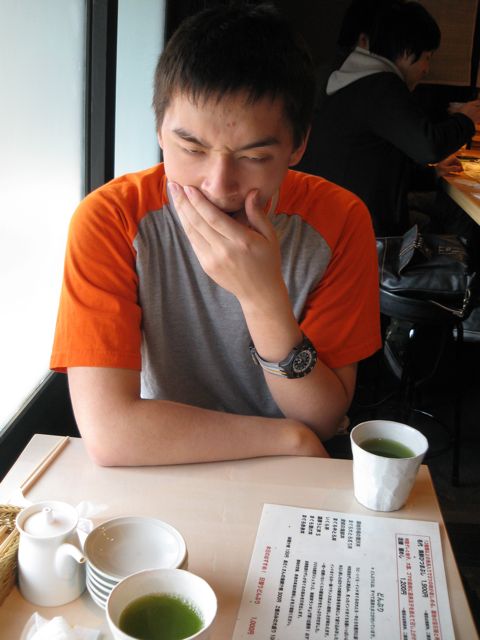
Scud, for his part, was bursting with enthusiasm.

With the amount of beer I drink, I was just bursting (you’d think, at $5 for a half pint, that they could pour you something where the head wasn’t a significant portion of the beer – even Scud is looking askance at that pour).
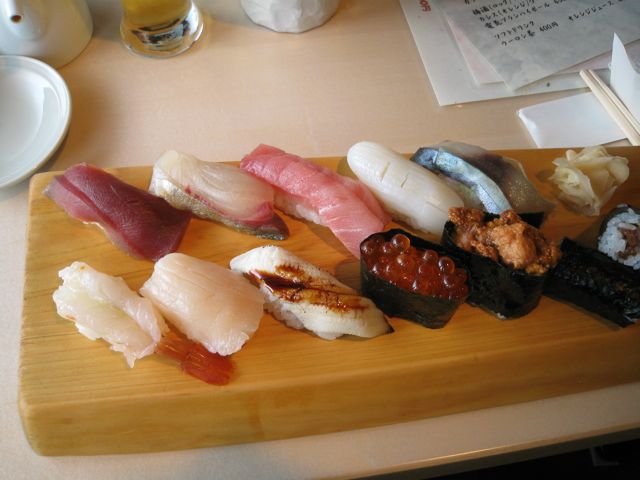
What we had was a good, solid meal of sushi. It came with tuna, shad, mackerel, eel (which was once again torched, but not tarted up with greens and stuff as with Sushi Sen), uni, suid, yellow tail, ebi, ikura, toro, and tuna maki.

I think the thing with the ikura that’s bothering me is that the brining isn’t as aggressive as what we do in B.C. I admit I’ve been lectured on this by Yoonhi, and, as she’s a lot smarter than her, I’ll bow to her knowledge. I know what’s good for me (Remember that part about waking up in damp sawdust and knowing something bad is going to come your way?.......)
Food in his belly, the Boy and I went back to the underground and headed for Asakusa.
The Oedo line will only get you so close. Seeing as it was a beautiful day out, we (okay, “I”) chose to walk in the last way, with the idea being that we’d walk along the Sumida.
Yeah, right. Anywhere else a city’s major river would have a pleasant corniche upon which to stroll…..okay, not Bangkok…..nor Vancouver…..forget about Houston, that really is just an open air sewer…..Paris! Paris has a nice walk along the Seine. And I’m certain some other famous cities do, too. The point is, don’t expect a pleasant stroll along the riverside. What there is is a narrow alley blocked off by buildings on one side, and a large wall on the other. Why a wall? Does the river flood that badly?
Anyways, we made it back out to the streetside, which is just as well, as this gave us the chance to stand in front of the Bandai building and go “ooh”, and “aah!”
And, while I’ve got video of the Doreamon statue and the Power Ranger statues and the others, Stupid Boy didn’t shoot anything with the still.
Remind me to whack him when we’re in the same continent again.
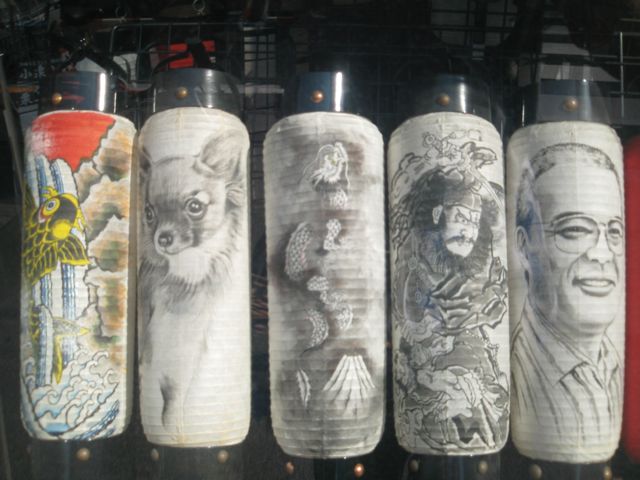
It’s a neat walk through here, though. Neat in that it’s so far off the tourist path that you get more of a feel for the sorts of things that make up daily life. Lamps, for existence.
Name signs, office signs, house signs, business signs…..these are all things that just look good, but they’re there for a purpose. It’s that element of purpose I like (and so dislike in the mountains of tourist junk I see in Nepal and elsewhere).
Finally, we began to draw near our destination. We were within spitting distance of Asakusa, the older part of Tokyo. And everyone knows the cultural significance of that.

We were right across the river from the Asahi Headquarters, and the “Flaming Turd”.
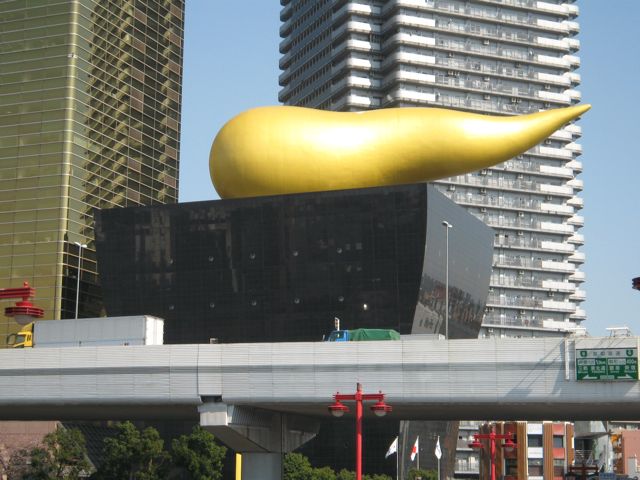
I’m being cruel, but everything I’ve read has taken this same view of Philippe Starck’s ode to the spirit of the Asahi employees.
The Japan Times has a good piece on the building, and it’s famous “Flame d’Or” topping, discussing the obvious physical comedy element, but also giving a good overview of Starck and his designs (and more on that later in the Hong Kong side of this story).
I dragged the boy across the bridge, kicking and screaming all the way. ("Why are we going across the river?")
The real joy is in the approach. The building itself is a little anticlimactic once you're there. But we figured it was worth checking out the main HQ itself.

Inside the Asahi corporate hq, they concentrated upon a display emphasizing the eco-friendly nature of beer.
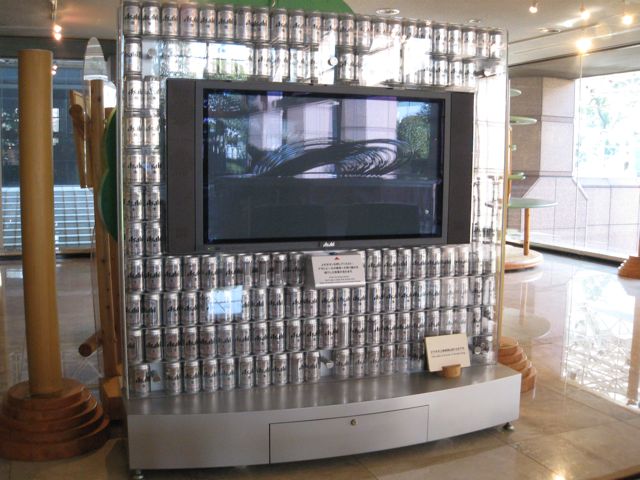
(This would be a way cool way to highight a good flat screen tv. Yoonhi doesn’t agree, oddly enough).
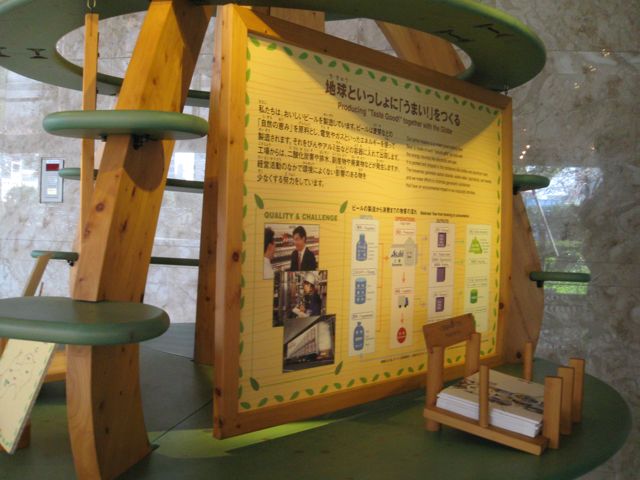
And how Asahi is “producing taste good together with the globe” drawing upon “such natural gifts as malt” with energy sources like electricity and gas.
Honestly, I was more interested in the company history up on display across the hall.


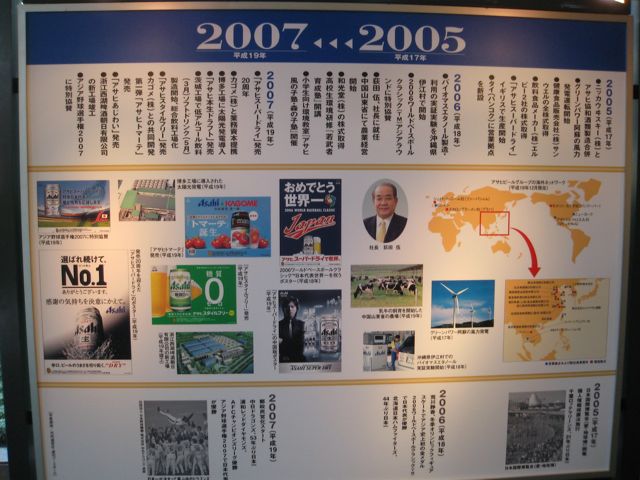
Honestly, I hadn’t appreciated how far back Asahi brewing goes., with its roots in the Meiji era. So, in a nutshell, what is the story of the Big Four (Asahi, Suntory, Sapporo, and Kirin)?
Well, Suntory we already kind of touched upon. While the whisky goes back quite a ways, the beer is pretty much a modern story, only showing up in 1963.
Asahi was originally the Osaka brewery. Meanwhile in Meguro in Tokyo there was the Japan Beer Company (producing Yebisu).
Sapporo was established byt the Hokkaido Development Commission (Kaitakushi) under Seibei Nakagawa, a German trained brewer. At that time it was Kaitakushi Brewery.
In 1906 the competition was such a lively example of free market capitalism that it was fated to implode into th DaiNippon Beer Company, which pretty much ruled the roost, monopolizing the entire beer market in Japan for the next 40 or so years.
After the War the zaibatsu were temporarily split up , and Asahi and Nippon breweries emerging from the rubble. Nippon went on to recast itself as Sapporo, after their most popular brew.
Now, of course, you’d be hard pressed to find a Sapporo from Sapporo. Most of it is brewed in Sendai, Chiba, and elsewhere, and what we drink in North America is being produced by Sleeman’s of Canada, who they bought out in 2006.
So what about the last in our quarter; Kirin?
Kirin is actually a foreign enterprise. It was started by a Norwegian – Johan Matinius Thoresen – who showed up in Yokohama in 1864 to make his fortune. By 1869 the foreign crowd were clamouring for beer (quite rightly) and he started up a brewery to keep them satisfied. He changed his name to William Copeland, and set to work with the Spring Valley Brewery.
In a tragedy which only the late Ingmar Bergman could have done justice to, Johan went out of business, closing his brewery and leaving Japan.
But, hope was not lost. A group of enterprising Brits teemed up with some local Japanese, and rounded up the capital to reopen as the Japan Brewery Company. At this point they attached the Kirin, the mythical creature of Manchuria to the lable, and history was made.
(Copeland/Thoresen returned to Japan, but died in 1901. It’s nice to read that his grave is still marked regularly by fresh cans of Kirin. If I go back, I’ll have to visit and leave one).
By 1907, the company fell under the sway of the Mitsubishis, where it’s been ever since. (The Mitsuis have Suntory, the Sumitomos Asahi. Only Sapporo seems in the clear).

This is making me quite thirsty.
-
When applied to ceramics, interiors, clothing, and design, it suggests a kind of richness balanced by a kind of minimalism, but probably not the kind of severe unadorned white porcelain aesthetic that you'd expect when "austere" is used to describe things in Europe or North America.
In modern parlance, one might describe 'shibui' things (and people) as being 'cool' (or might have, before the word 'cool' got over used.
It is tricky to describe exactly, and it's worth putting (albeit temporarily) an unripe persimmon in your mouth just to get a proper 'feel' of the word. There are many persimmon varieties, especially in the mountains, that never ripen to a state fit for consumption by humans. Unripe persimmons are easy to find in October, trying one is an intense and unforgettable experience.
Nuts! Now I've gotta find an unripe persimmon. I won't be able to sleep, otherwise.
-
Peter/nakji - wouldn't you be grumpy if you're covered in damp sawdust and there's nothing to eat and you have a bad feeling that something awful is going to happen to you?

That's not a bad description of my waking up under a bar stool in the morning.

-
March 25 – Part the Last – Kadowaki
Our afternoon had been an idle thing. I caught up on writing while Scud headed back to Akihabara/Akibahara/Akiba/the place with the comics for a few hours of exploration.
While I still didn’t own a Michelin guide, dinner wasn’t of too much concern, as I already had reservations. In all the sturm und drang regarding the Red Book for Tokyo, there had been one name that kept on coming up in the articles, and that was Toshiya Kadowaki.
He was of note for opting out of the Michelin system, refusing to allow them to photograph his restaurant and his food, and questioning their qualifications (if not hubris) for ranking the restaurants of Tokyo.
Let’s set aside the Michelin Controversy (which one?) for awhile, and we’ll just concentrate on dinner. We can discuss it in a few days. For now, let's just consider this meal.
I gave us plenty of time, and secured, through the good graces of our front desk, a map with directions.
These directions took us down the hill, past the pimps, cutting through the smaller street at Roppongi that forked off behind Almond. Scud asked about the Hard Rock, and I advised him as to the social clientelle that appear there after 8 p.m.
The nice thing about Roppongi is that its bad elements are so well contained. If you but walk a couple of blocks, you’re clear of all of it, and can then enjoy the wealthier, upscale side of things. Get to the bottom of that hill and cross the street, and you enter Azuba Juban.
Of all the areas of Tokyo (and I have been here once before, albeit in the early 90’s) I may like Azuba Juban the best….Well, maybe I like Ryugoku better, but for the opposite reasons. This neighborhood had such a nice vibe of café’s, bistros, and, well, gentility about. It’s the sort of place you’d want to live in, maybe, as opposed to visit (yes, I can make some educated guesses as to the cost of living here).
Scud was amazed, quite frankly, that I found the place. I admit that I was a little hesitant as I peaked inside and asked, but we were in the right place, and they were expecting us.
The restaurant is quite “well contained”. Simple is an overused word in respect to many Japanese restaurants, as is austere. And neither really is appropriate, as I always find a lushness to the woods and earth tones that I find in these places, and there’s a comfort in the geometry that puts everything in its place. Perhaps a better word to take up is “serious”?
We sat at the bar, always the best choice for us, as it’s the only way I can learn anything. The bar seats 6. With the extra rooms off the side, perhaps there’s accommodation for at most a couple of dozen (although I didn’t snoop inside the rooms to count).
Now, for the rest, you’re going to have to bear with me. As you’re well aware, my functional level of Japanese is nigh non-existent (I do have certain niches). While better than my capabilities, communications in English here is…..challenging. But, that’s my problem. I’m the foreigner.
First, I checked on the issue of photography by holding up my little Canon. A cross of fingers and short bow of the head was the response, so I put away the camera. Seeing as he’s often quoted as having refused Michelin’s request to photograph, it’s nice to know I’m being treated in the same manner.
I start with a sake from Yamagata. I’m afraid that, beyond the prefecture, I can’t help out much beyond that. The flask arrived in a small silver basket. It was relatively dry, with a little fruit in the nose. That much I can tell you.
I did enjoy it.
We started with a small bowl of noodles topped with crossed greens and green egg slivers (I can’t help but bring up Dr. Seuss to Scud…he hits me), a lone bean sprout laid across the top. With this were two roasted beans, broad in shape and possibly lima (?), that had been lightly charred, and were peaking out from their blackened skins.
The noodles had an excellent crisp, breaking apart feel about them, that feel of just formed from the dough, and not completely reduced in cooking. Side this with the sunimono vinegar tang that was in there, and the full starchiness of the beans, and you think, “this isn’t bad”.
And then you hit the little pebble of wasabi and it moves up a notch.
Not a bad start.
Eating like this, while a challenge to write about, is a joy to take part in. It’s like watching a mime do magic acts, with mysterious items appearing prior to the execution of the art.
Next arrived blue and white dishes with what appeared to be salt and pepper, mixed in the Chinese style. Then appeared another plate, round, topped with a pretty little paper napkin.
Frying was in order, it would appear.
A tidy quartet appeared. A thatch of kelp (thick and a little juicy), a tangle of threads of what my notes say is nakaimo (but would this be yamaimo?), a tiny bundle of chives, and a hair nest of onion shavings. (that’s the way I drew it).
He’d indicated “no pictures” but he didn’t mind sketches.
Then arrived the two sauces, and then the tempura. There were three tempura; one a small, brocolli like green, with buds rather than florets; the other a muchroom, full with juice and that soft fungus feel; and the last, the largest, a mousse of fish, crab, and prawns (I believe) that made me think of a fry of hor mak talay.
Meanwhile, we’ve been joined by another couple at the bar, and there are obviously customers in the rooms, as he and his assistant are patiently working up other orders of tempura and the sunimono we began with.
I watch with interest as he begins on some new items. A large piece of bamboo shoot – steamed - is hollowed out and filled with something. And then two cups are placed in a steamer, the handled wrapped carefully with a dark blue cloth.
The bamboo shoot is finished on the grill, then garnished with a neon green sprinkle of spring onion. It’s served to us from the grill, and I bite in, taking notice of the soft, flacid item just beneath the spring onion.
This is uni, itself slightly grilled, which has been used to top off the dish. Under that are wedges of the bamboo that have been returned to their original positions after cooking. The creamy fat of the uni goes well with the remnant crisp in the bamboo, and with the grilling there’s a very nice roast smell to everything.
Scud lets me know that he hasn’t been getting a lot of uni at school, either.
Next arrives - in the cups we’d seen placed into the steamer - a steamed lemon skin split by a break of gold and green. Deep down in this, beneath the yielding surface and through the thick sweet ooze with a smell of honey and plum, there’s something yielding and starchy. I want to say potato, but it’s been scooped to an onion shape. I find a sweet little prawn curled into one side. The texture and flavour is thick and full of starch. Quite comforting.
Communications in the restaurant is a matter of whispers and hisses. Everything has a hush about it. Likewise, there are no sharp discordants coming from the cooking station. No clanks or rattles. Everything done is done with a practiced finesse.
A nabe is next. I’m faced with a vertical line of translucent white fish fillets, sided by a grill in the shape of a turtle’s back, a bowl of broth atop. To the left of the fish is a small bowl with a ladle resting upon it.
As directed, I prepare the sauce of sesame, ginger, garlic, and then a slight twist of lemon. The fish is dipped in this, then eaten. A pleasant texture, I ask, and am told that the fish is “kime” (although there’s a good chance I’ve heard it wrong). The slightly cooked flavour, supported by the sesame in the sauce, is quite good.
After the fish is finished, our current plates are removed, and a new bowl is brought. Then the broth is removed (with a shovel, of which I heartily approve) and put in our bowls for us to take. I touch it with just a bit of the seasoning they’ve provided.
Behind the bar the corpses of our fish is wrapped mummy-like in cherry leaves (before Hiroyuki I would have said sesame leaves) and then put to rest under sheets of ice.
Scud begins to fade a bit, not having napped after Tsukiji this morning. I give him a nudge, and then advise Kadowaki san that he’s my son.
This seems to make a world of difference. Whereas before he had been, well, not exactly happy to have me there, he now smiled, and seemed to relax by a several degrees. I’m not saying he did cartwheels or Robin Williams impersonations, but the frost in the air dissipated.
Next came a small assortment of pickles, particularly the yamagobo (that Hiroyuki had identified for me earlier) that we recognized from Morimoto’s.
Scud ate it.
Without a blink, Kadowaki san placed another on Scud’s plate, while I restrained the Boy.
Our rice then arrived. I recognized that smell. Black truffles. Full of earth and the dankness of rich soil. Not something I would have associated with rice, but it was extremely good, the nose filling as you brought a bite into your mouth.
Another fine sake had arrived, who’s origin I’m now at a loss to detail. My notes do make the point that the truffles help to bring out the background ferment in the smell of good sake, that rich tangy odour that’s in there.
As rice finishes the meal, all that was left was dessert. This arrived in a shortened martini-glass-like dish atop a platter of beaten steel, a long silver spoon with a small leaf of a bowl at the end resting on the platter.
This dessert was a thing of softness. I believe it was primarily soft tofu, topped with a bit of mocha and some gratinated elements with a bit of citrus in them. But put away the gratinee, the overall impression was soft.
We finished, smiled and nodded to the chef, and paid the bill. Kadowaki san took us to the door, and I tried my best to express how much we’d enjoyed the meal.
Scud just smiled, and that seemed to work the best.
Afterwards, as we walked back uphill, Scud asked how much it had been.
I told him.
To avoid being banned from egullet, I won’t reprint what he said.
But then he said it was probably worth it.
I’m probably not doing a very good job of preparing him for the real world, am I?
-
From my traditional sushi shop in Niigata thread:
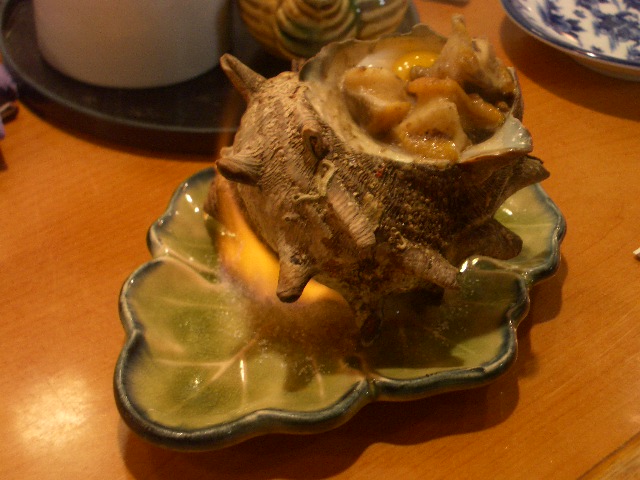
Sazae no tsuboyaki (turban shell cooked in its own shell). The sazae is seasoned with soy sauce and sake. My son likes this particular dish. As for me, I like to have sazae as sashimi.
That looks really, really, really good.
Do you have an idea on how they do this? I'd venture they remove the meat, marinate it, then place it back in the marinade and then grill it?
I've gotta try this in Vancouver (if I can find the conches).
-
Peter - the sawdust keeps the moisture around the crab and helps them live longer. Just wanted to let you know.

It's in his best interests, but that crab still looks pretty angry about the whole thing.
-
Hi, Hiroyuki,
2. Hoya: Sea squirt, often called sea pinapple.How do you usually have the hoya/sea squirt (that was the name I was looking for!). Is it a sashimi item only, or is there something else you can do with it?
4. Self-breading: Yeah, saw-dust!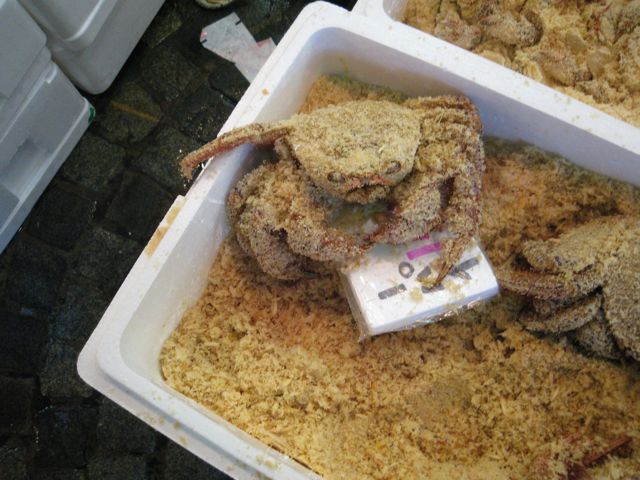
Sawdust seemed the most reasonable, but I wasn't about to put my fingers in there to check.
Do you know if there's something special about these smaller big clawed crabs that requires them to be packed this way?
7. Horagai: They are sazae! You don't know Sazae-san (very famous anime)?!
Ahh, Sazae.....The Wonderful World of Sazae san hadn't triggered. I guess that'd be like mentioning "Peanuts" or "Charlie Brown" to someone in North America (although I wonder about Scud's generation...)
8. Styrofoam: Styrofoam containers are recycled there. You can see the sign ryokinjo (tollbooth).That's good to know. It was one of those things that was going to bother me for awhile.
11. Hora in horagai: "Hora o fuku (= blow)" means to brag.So the English catchphrase "to blow your own horn" in terms of bragging, would make sense here?
Thanks,
Peter
-
March 25 – Part 4 – Q & Q [What! You expect answers?)
Let’s wander through the market at a leisurely pace, and see what else there is here besides the BTA (big tuna auction). We’ll treat this as a comparative trip, trying to spot things in use from the other side of Straits, and I’ll ask the questions about what happens to them over here.
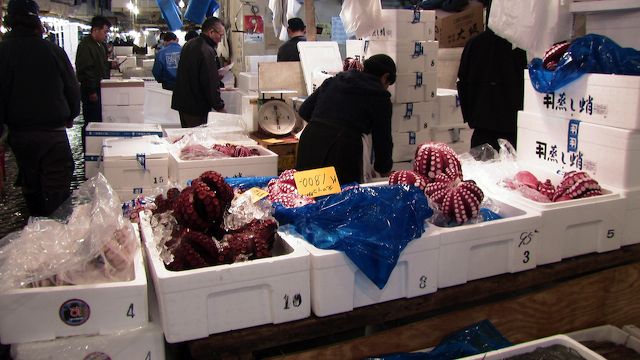
Octopii are some of my favourite things to eat. I think I’ve mentioned earlier that they were my first introduction to interesting eating (having been spent my early years with fine, traditional Canadian cuisine – sole in white sauce, meatloaf, spinach from a freezer bag, twice charred flank steak, and burnt-to-a-cinder roast beef….I hope Mom’s not reading this!).
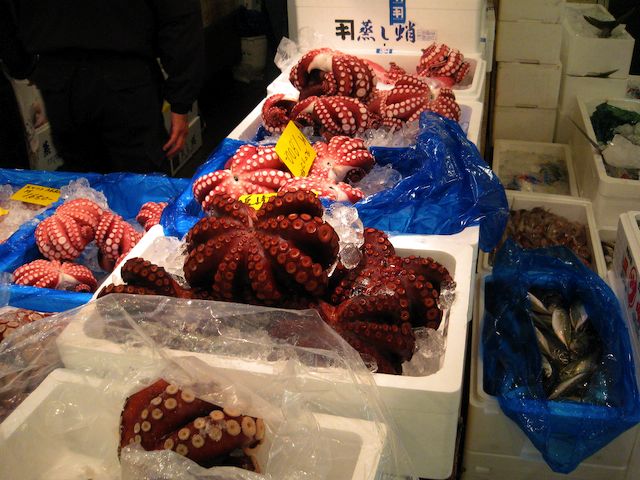
What I saw here were of the very firm sort, which I would assume were destined for the sushi houses.
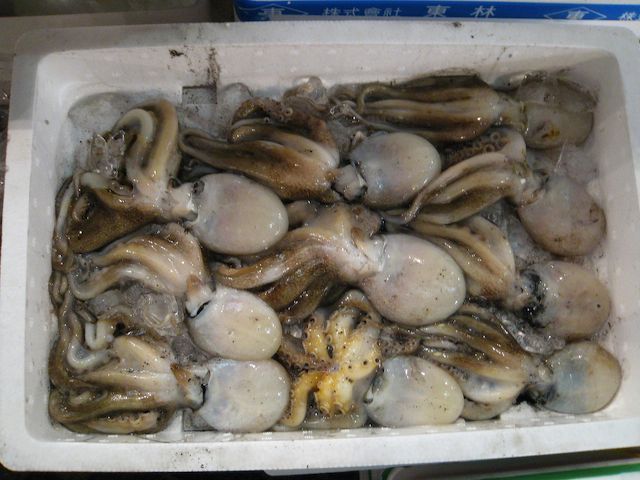
Now, I base that on Korea, where the softer, more flacid varieties of octopus (such as these ones chilling out in a styrofoam carton) go into the hotpots, and the little, live squirming ones just go in your mouth (something I missed out on that last trip, but I’ve had before back in ’98) or else would end up pickled and taken as yet another form of kim chi. Would these typically be used in a nabe in Japan, or are there other preparations for them here?
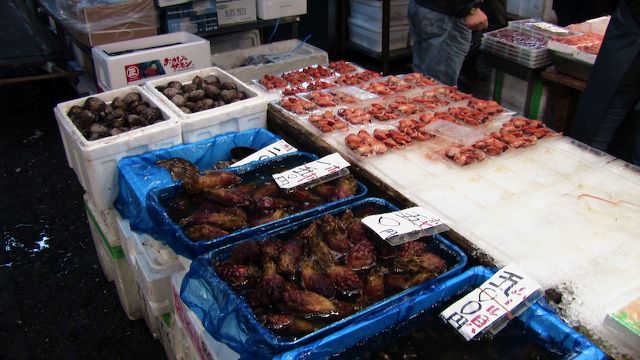
And, speaking of Korea, here’s another old friend. Mongae, or what Scud and refer to as Doggaebi food (Doggaebi are the gaurdian demons that flank the gates of Buddhist temples, and have very large spiked clubs…hence, spiked food, spiked clubs….maybe you had to be there).
But that raises the question….in Korea this is eaten raw with vinegared gochujang. In Japan is it just used as sashimi, or is there an alternate preparation for it? (I told you I’d have lots of questions).
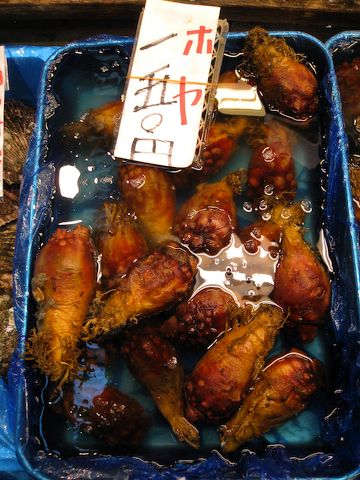
I think there was a thread around somewhere discussing these things, but darned if I can find it (at least not by searching on mongae…maybe I’m thinking of the golbengi thread?). Anyways, for pictures of them stripped of their naked aggression, here’s the link to
dinner on the Eastern Coast at Jyeongpodea.
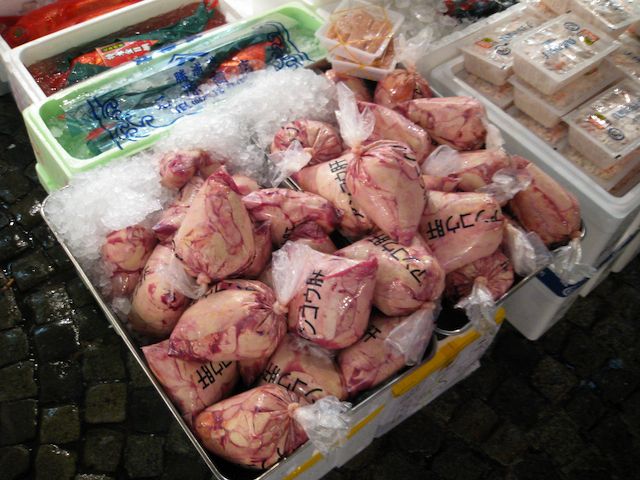
This I’m not certain about? Fish liver? Is this the raw material for what I’d had at Tazuru in Kyoto?
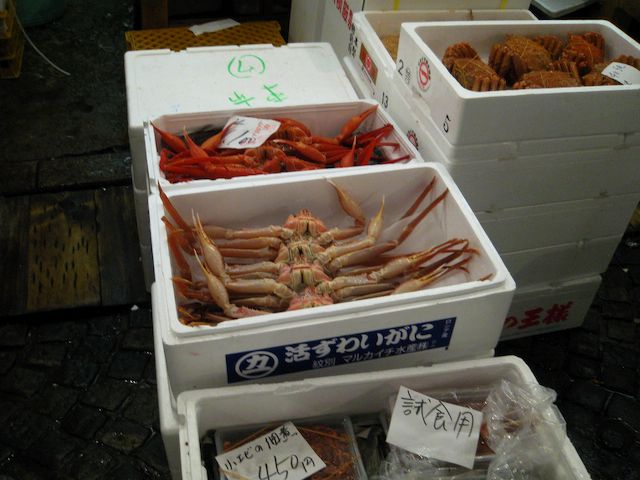
And you gotta love crabs, at least for eating. Anything else gets painful. Nothing huge on offer (although there must be some Alaskans about, as I’d had them in a nabe in Osaka) but there was a nice assortment of varietals, some with beautiful bright technicolour orange ones in the back there.

And there were Tanner crabs with their long pincers stretching out of the box.

These ones I’m not certain what was up. Alive, it almost appeared they were self-breading themselves, which would be a neat habit to breed into critters.

Small and stubby, but with good claws on them that would be full of meat.
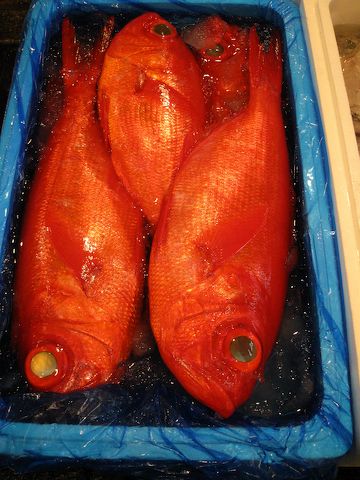
I admit it. I just don’t know fish. These ones are red. I know they’re not tuna, shark, salmon, and there are a few others I can disqualify, but it’s up to you to put a name on them. I just liked the organization of them in the box (and red and blue makes the best spectral contrast)
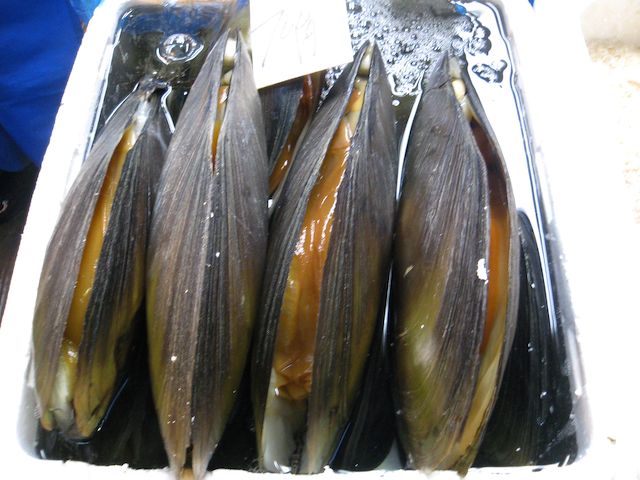
These I do recognize. We’d also had them in Korea. They look like a huge mussel, but they’re not.
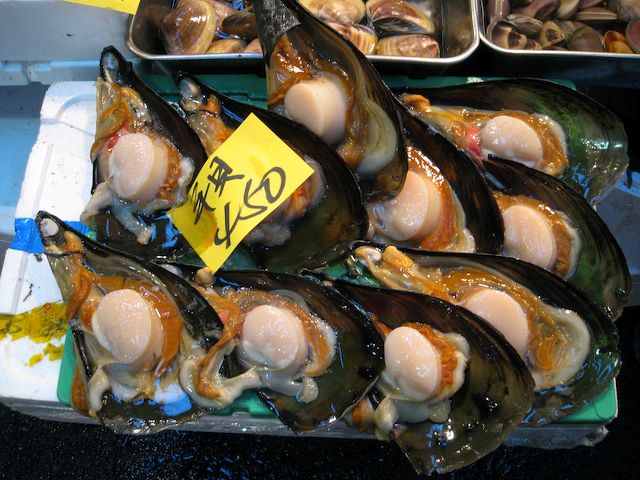
After we’d eaten them in Jyeongpodea I was told that they’re not really a part of the mussel grouping, having been disowned and cast into some other family.
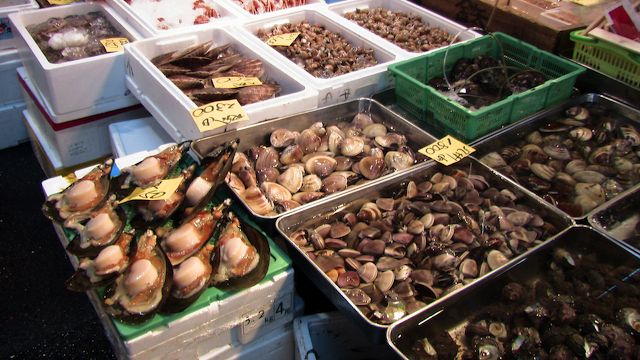
They’re more like a clam (and sold with them), with a much meatier flavour. We’d eat these grilled, rather than raw, and again, there’d be a lot of gochujang about to go with them. In Japan, I’d yet to come across them on a menu.
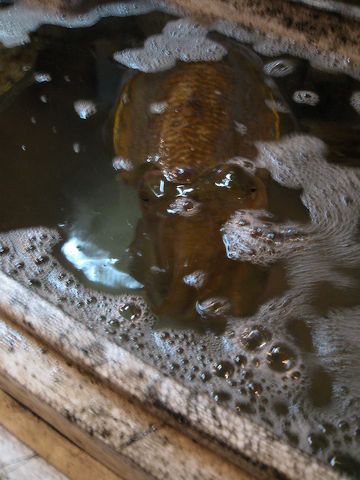
I found a live cuttlefish, thinking its odd thoughts in a circulating bath. This I’d take blanched, and then dipped into gochujang. They’re the oddest thing under the water, looking (to me) like an old man’s bearded face.

These we’d come across, and they had beautiful colours to them. Surprisingly (to me) I didn’t see that many on offer (but maybe I just didn’t go down the right aisle?).
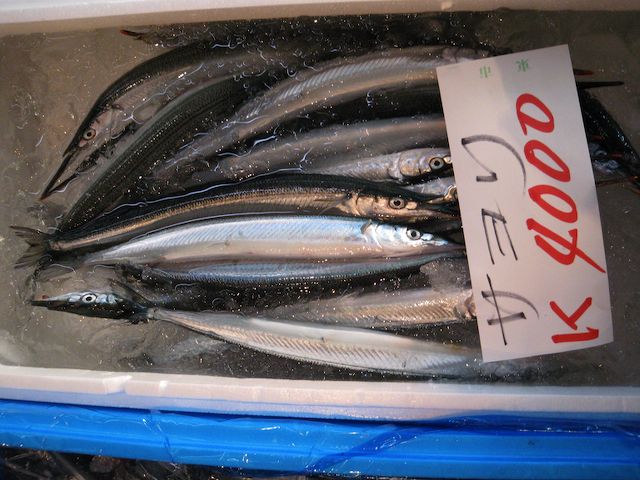
Okay, I already told you about how I’m fish-challenged. An interesting underhanging jaw on these that puts me in mind of some Frank Miller characters (swtiching back to American comics, althoug Frank Miller has been an extremely big fan of Japanese manga and cinema since way back in the 70’s).

Now, I would classify these as conches. Spiral shell, pointy end, hard casing over the pad of the foot, native shamans blowing them from atop the volcanoes…..okay, scratch that last part. Still, I’d call them conches, so does that fit the profile of horagai? (Is the "hora" part related to "sound"?)
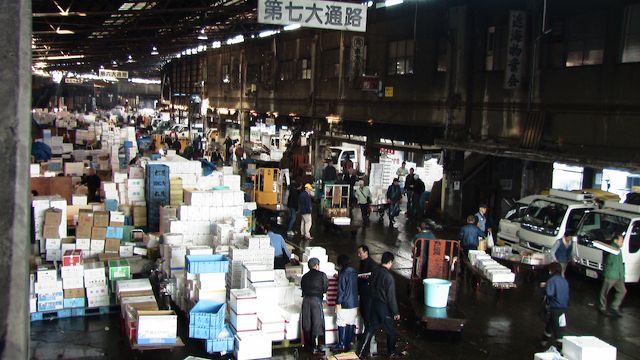
Early light was now coming from the sky, with the sun making a more sensible timely appearance than the rest of us

(this is a condition technically referred to as “morning” in many places. As most women will remind us men, this is a time set aside for sleeping).

There was still some trade going on, but things were beginning to go quiet, and there were already fewer trucks about. Most of the morning’s business was over, and the shutdown was underway.

Part of the shutdown is finishing up the orders, packing out the fish in those tidy styrofoam containers.
So what about those tighty whities?
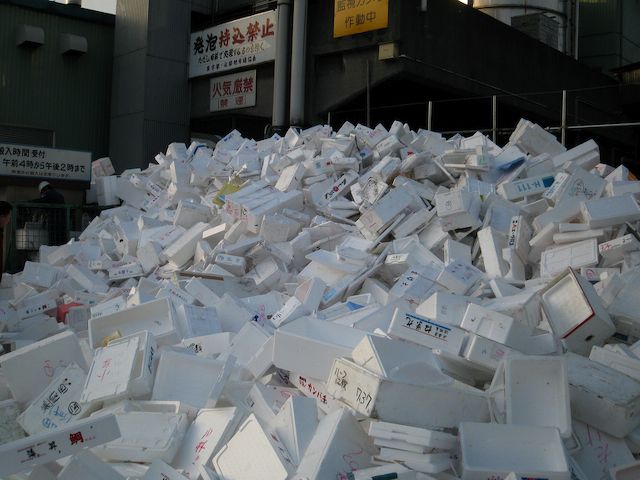
Walking out of the wholesale zone, we came across the Holy Mountain off polystyrene.
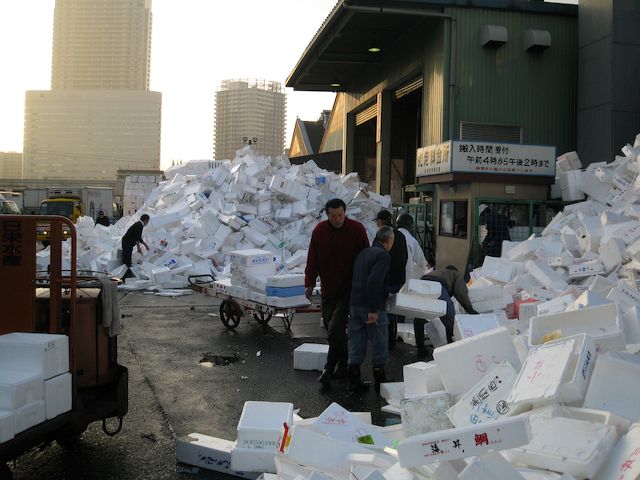
It was unclear to me as to the nature of the pile. I’d thought, at first, that it was a dump, but it was being worked over by the market staff who were piling up carts with the boxes and disappeaing back inside. Is it a distribution point (oddly haphazard when everything else is so tidy), or is it just easier to dump a few containers here and let people sort through them for what they need?
Life is a mystery.
From here we continued to the outer market.
I know! I know! “What about Sushi Dai?”
Frankly, I was happy that Scud was still ambulatory. I can’t carry him anymore, that’s for certain. And, while the Boy and I have the innate respect Canadians have for queues, we still don’t like them. It may be the best sushi in the world, but at 7:00 a.m. with only around 4 hours of sleep behind us, we were running on reserve patience.
We figured there’d be other places selling fish nearby.
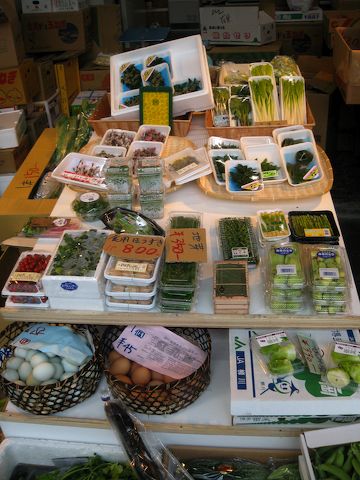
The outer market also had a fair amount of greens to complement the seafood (in small lots) on offer. Eggs, too. Again, lots of packaging being used to keep things tidy. But, really, it looked like a market stand anywhere else in Asia, it was just so much more....tidy. And presentable.
There's a comment. This section was more approachable, being a retail market for the riff raff like me. Inside was much more "commercial" than what I'm used to from elsewhere. Calling Tsukiji a "market" does it a disservice, as it much more a processing and distribution centre.
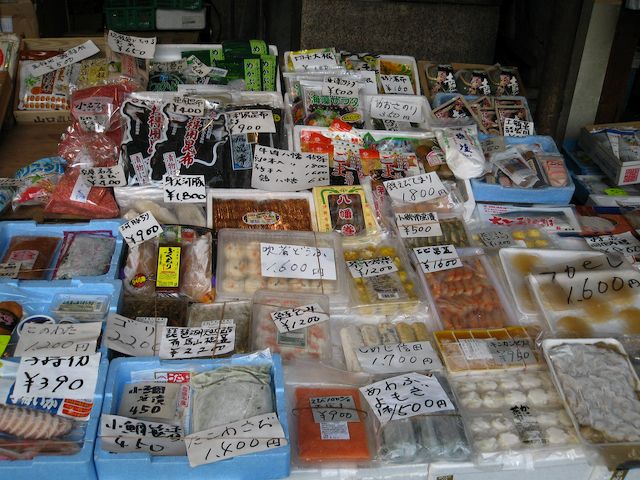
I’m guessing again with some of this, but it looked like packages of gyoza on the far right, and an orange packet of shrimp paste of some form in the middle (at least it says “ebi100%” on it). Peeled prawns, seaweed, sachets with pictures of tuna on them, bags of MSG (aji no moto), and there were lots of what looked like fishballs.
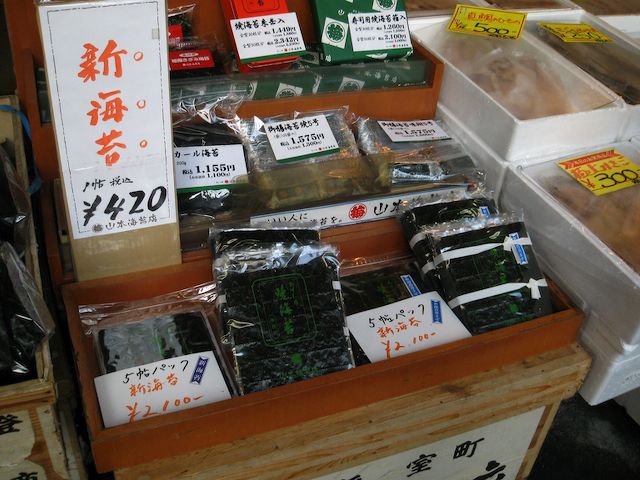
And the nori stand got my attention. We go through a lot of nori (or gim, in Korean). Maybe I should be thinking about bringing a souvenir back for Yoonhi? But the odds of these surviving my packing were probably pretty miniscule.
And then I saw them. What every girl dreams about.
Loose, assorted dried fish. These were the perfect souvenir to bring her. No refridgeration requirements, and something that’ll get used.

I just had to remember to ziploc it before I put it in the suitcase (we had a bad experience with me sending back river weed from Luang Prabang a long time ago. Luckily, it was in my friend's suitcase).
The vendor was concerned about me asking for a whole kilo, and checked (in very good English) to see if I was a complete idiot, or just an approximation to one.
“Do you know how to prepare this properly?”
“Oh, yes! I give it to my wife and she does it!”
At least I got a smile out of him.
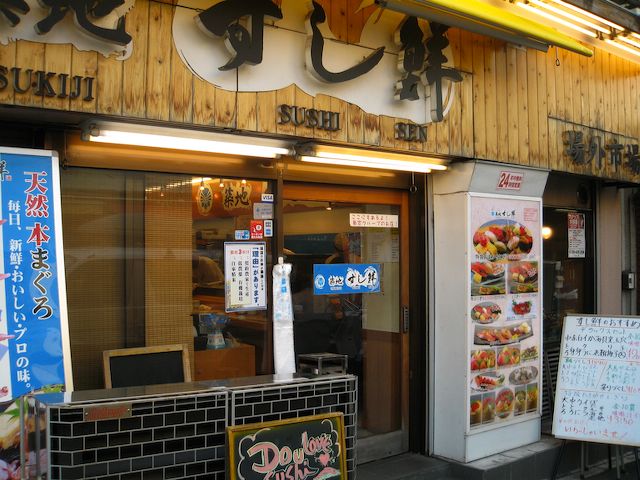
Near here we came across some likely lunch spots. One of them Sushi Sen, was open 24 hours, which is usually a good sign in Korea (it means they’re food can draw customers at all hours of the day), so I could give it a try here. Scud was beyong caring. He just wanted to be fed.
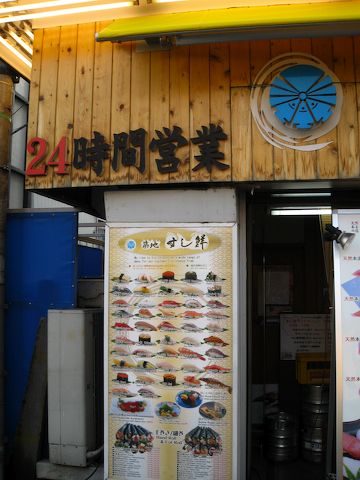
Right, having gone with the “24 hour” and drawing customers ploy, I was a little disconcerted to find the place empty. But, having entered, we’re not the types to back out.
We took a place at the blond-wood bar, and asked for two of the sets we’d seen out front.

I didn’t want to make things difficult. He seemed to be in a bad mood, and he had a big knife.

Now that he was sitting down, Scud was in a better mood. He and Serena have always liked sushi, and it’s one of the things that his school seems to be shorting the students on (along with foie gras, caviar, and good champagne….he does get bacon, though, so life’s not all bad).
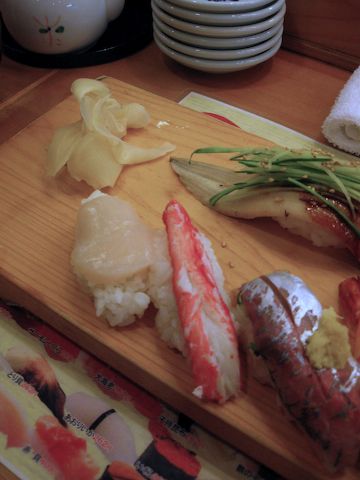
What came was very good. Starting with the piece on Scud’s board that was closest to me, there was (I think) Bastard Halibut (a name that got a smile from the Boy), and then some Tanner Crab, a long piece of meat taken from one of those extended legs we saw earlier.
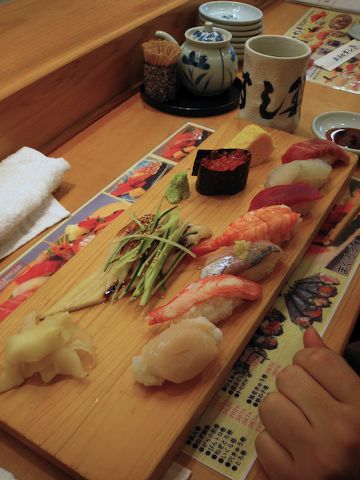
Beside that is a shiny bit of Jack mackeral, with a dab of ginger on top, and then there’s a shrimp beside it.
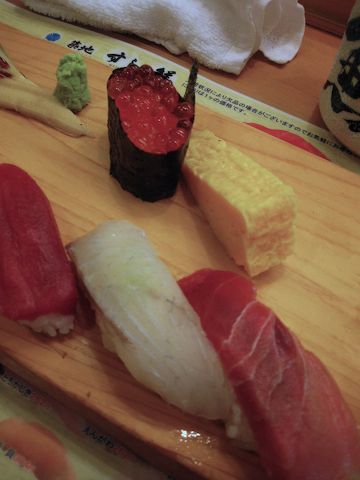
Moving right along we have our tuna, than what I think is sea bass, and fatty tuna. There’s our ubiquitous egg up top, both the chickenal variety, and the salmon kind.
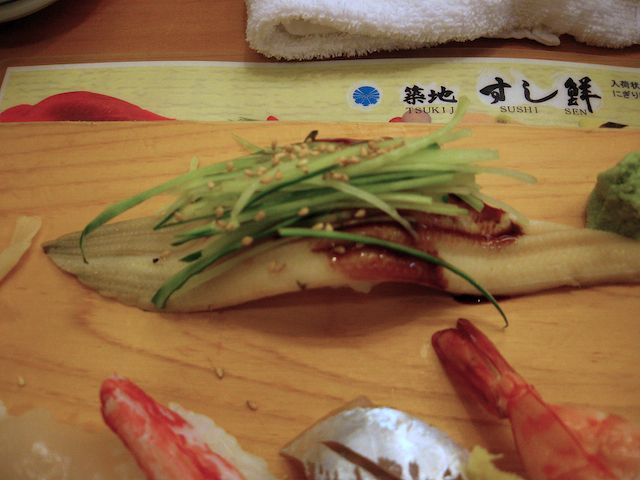
The real star though, was the conger eel. This was blowtorched lightly, and then topped with slivers of cucumber, sauce, and a sprinkle of sesame.
Scud’s happy anytime they bring out the flamethrowers.
The place was filling out with a mix of locals and tourists. I guess all it takes is one pair to act as the seed to get things going.
The chef had stopped his grumbling (a constant litany of a word we recognized from anime which didn’t have the best connotations), so we ordered a few more pieces (octopus, more tuna, another eel for Scud) and I saw something I’d been meaning to try.
Nattou.
With this he smiled.
He reached into one of the fridges, and pulled out plastic sack of brown stuff, nipped off one corner with a pair of scissors, and then formed a temaki, piping in the nattou. This left spiderweb strands of the stuff dangling about in the air, catching up on my fngers as I accepted the piece.
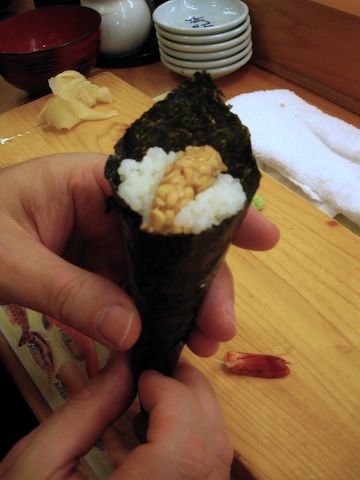
The flavours a lot like doenjang – the Korean fermented bean paste - but the texture is quite different. The Koreans also have a chungukjang (Chinese paste) which I haven’t had, but which is a relatively quick ferment (72 hours) and I’m told is very similar.
The Soy Info Center goes into a lot of detail on the alternate theories of the origin of nattou, coveing the external possibilities, citing the blind Buddhist monk Ganjin bringing over 1400 gallons of tan-shih “soy nuggets” with him when he arrived in 754 AD (that’s a lot of nattou to take on a trip), and the local versions, attributed both to Prince Shotoku (7th century) and to Minamoto no Yoshiie (11th century) of lucking upon beans gone bad, and then having the gumption (or hunger) to get past the smell and try it out
Of course, the more plausable explanation is that it’s something that just happens. The bacteria that acts to ferment the soybeans is found in straw, and there’s a lot of straw used to wrap up stuff in the old days.
The three pages the Soy Info Center has posted is an interesting read (and part of the reason – albeit a small one – that I’m falling so far behind in my writing). They also cover the different types of nattou. Here I was thinking that it was one thing, but they list (I love lists)
itohiki nattou – regular nattou
Mito Nattou- A small-bean natto, from Mito.
Hikiwari Nattou - Split Roasted Soybean Nattou, from Aomori prefecture.
Yukiwari Nattou - Finger Lickin' Natto (my favourite name) from Yamagata a mix of nattou, rice koji and salt, and then a long15 day ferment.
Nattou Hishio – from the northeast – is similar to the Yukiwara, just with different ratios (and of course, different personal touches in the seasonings)
Hoshi Nattou – dried salty nattou – which isn’t sticky, but comes with a flour dusting. These are eaten more “like peanuts”, and are a southern specialty, from Kumamoto in Kyushu.
Toozoo – nattou fermented persimmon water, daikon, salt, and koji (from Chiba).
They also talk about a dish from the Fukushima area that sounds good just based on the name daraku nabe “degenerate one pot cookery” – udon in a big pot topped with nattou.
What a world there is in the soybean.
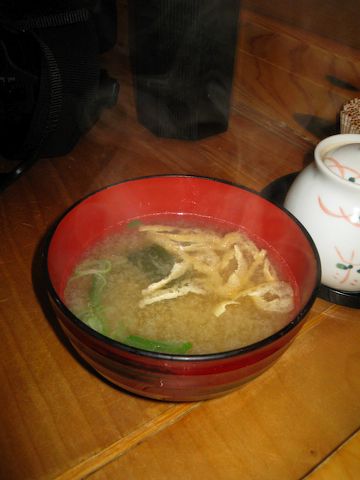
And don’t forget our miso soup, either, another soybean product. This soup was fairly rich, with a lot of body to it. I like the dissolved-toilet paper texture that this has, along with the ample selection of extra bits (tofu skin?) in there.
Yup, a good broth, raw fish, some blowtorch action, and a couple of slugs of alcohol. Maybe breakfast can be the most important meal of the day like they say?
Anyways, back to the real world, we came out of Sushi Sen with a surprisingly small bill, considering we’d gone well past the initial set specials, and I’d added on some sake to help appreciate the fish.
Honestly, it was just for the sake of the fish.
If you're interested here's Sushi Sen's web page in English. It helped me kind of remember what I ate (the special we had that day isn't on there), but beyond that it goes into the health details of the different items, and provides more details on their sakes, and on their shochu.
If I go back I'll review the site first. On the shochu's they had a couple that were "brown sugar distilled white spirit". The write up on these make it sound like they're very small batch shochus, and could make for an interesting breakfast at some other time.
I’ve probably belaboured the nattou a bit (“No! Really?” comes the audience) but it, and that eel, were the only really different things, so I give them the bulk of the typesetting effort here. Again, it’s the rice itself under the fish that’s the highlight for me. Not up to what we had at Morimoto’s (I can still feel that in my mouth), but still far above what I’m used to.
My only disappointment was in the ikura (the salmon eggs). And this wasn’t a criticism of Sushi Sen, but in general I was finding that the ikura here weren’t as heavily brined as what I’m used to in Vancouver, and the eggs didn’t have quite the same firmness to them. Quibbling, I know, but a very nice meal is a simple bowl of rice hollowed out in the middle and then filled with ikura. It sort of looks like a baboon’s pimpled derrierre, but it tastes good (the rice and ikura, that is, not the baboon’s backside).

Clear of the market, we just had to make our way past the final layer of noodle shops and yakitori joints (all of which were doing a good business, or else we might have stopped for a wee bit of afters).
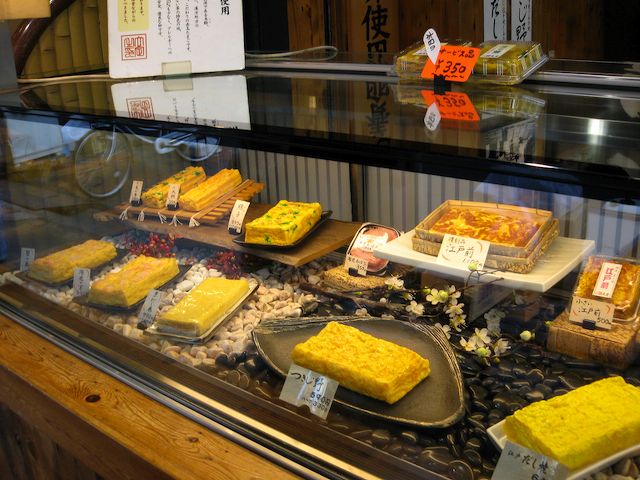
We’d just cleared the omelet display (we’re not egg types), when were waylaid by these.
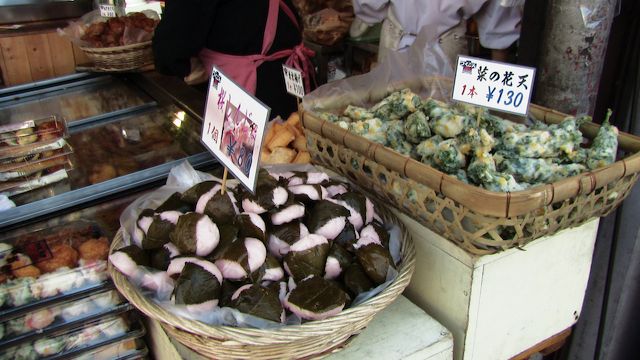
As usual, we had no idea what we were buying, but they looked pretty, all pink with what looked like a perilla leaf (sesame leaf) wrapped around the outside.
That was enough. We made it down to the tube and headed home.
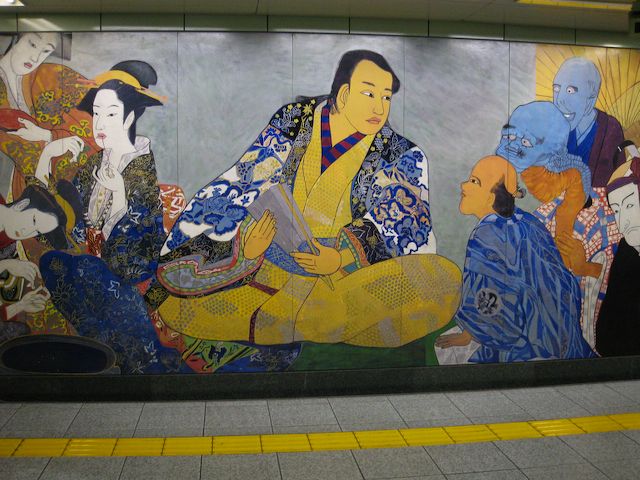
We needed some nap time.
Next: The Star That Wasn't
-
Sorry for being away for a couple of days, but the latest flu is passing through with the duststorms, and even my godlike physique (Bacchus, although some hold out for Dionysius or the Sileni, who aren't really gods, but more just old, overweight lecherous satyrs) has succumbed.
So, I've been away from the keyboard for a bit.
However, I'll try to catch up, although there is a physical law that indicates that the constancy of writing is inversely proportional to the square of the time away from the topic.
Or something like that.
Anyways, let me proof part 4 of Tsukiji, and then we can think about dinner.



Travelogue: Spirited Away
in Japan: Dining
Posted